
https://abs.twimg.com/emoji/v2/... draggable="false" alt="🍃" title="Im Wind flatterndes Blatt" aria-label="Emoji: Im Wind flatterndes Blatt">

https://abs.twimg.com/emoji/v2/... draggable="false" alt="🌿" title="Kräuter" aria-label="Emoji: Kräuter">Let&
#39;s know more about 𝐂𝐨𝐦𝐦𝐨𝐧 𝐌𝐚𝐧𝐠𝐫𝐨𝐯𝐞𝐬 𝐨𝐟 𝐒𝐮𝐧𝐝𝐞𝐫𝐛𝐚𝐧𝐬 this
#WorldMangroveDay2020. For coming one week, I shall be sharing about these unique plants.

https://abs.twimg.com/emoji/v2/... draggable="false" alt="🌿" title="Kräuter" aria-label="Emoji: Kräuter">

https://abs.twimg.com/emoji/v2/... draggable="false" alt="🍃" title="Im Wind flatterndes Blatt" aria-label="Emoji: Im Wind flatterndes Blatt">
@ParveenKaswan @deespeak @susantananda3 @RandeepHooda @narendramodi @LicypriyaK @ZebaZoariahAhsa

https://abs.twimg.com/emoji/v2/... draggable="false" alt="🍃" title="Im Wind flatterndes Blatt" aria-label="Emoji: Im Wind flatterndes Blatt">𝐒𝐔𝐍𝐃𝐀𝐑𝐈

https://abs.twimg.com/emoji/v2/... draggable="false" alt="🍃" title="Im Wind flatterndes Blatt" aria-label="Emoji: Im Wind flatterndes Blatt">

https://abs.twimg.com/emoji/v2/... draggable="false" alt="🌳" title="Laubbaum" aria-label="Emoji: Laubbaum">Name says it all, its a beautiful tall tree. Name “Sunderbans”is said to be derived from this.

https://abs.twimg.com/emoji/v2/... draggable="false" alt="🛎" title="Empfangsglocke" aria-label="Emoji: Empfangsglocke">Its beautiful small bell shaped flowers have cream colored petals which are reddish inside.

https://abs.twimg.com/emoji/v2/... draggable="false" alt="🍈" title="Melone" aria-label="Emoji: Melone">Bears roundish thin woody fruit with ridges along length&breadth.

https://abs.twimg.com/emoji/v2/... draggable="false" alt="🍃" title="Im Wind flatterndes Blatt" aria-label="Emoji: Im Wind flatterndes Blatt">𝐆𝐀𝐑𝐉𝐀𝐍

https://abs.twimg.com/emoji/v2/... draggable="false" alt="🍃" title="Im Wind flatterndes Blatt" aria-label="Emoji: Im Wind flatterndes Blatt">

https://abs.twimg.com/emoji/v2/... draggable="false" alt="🐅" title="Tiger" aria-label="Emoji: Tiger">Home to tigers, its name is apt which means “roar”.

https://abs.twimg.com/emoji/v2/... draggable="false" alt="☔️" title="Regenschirm mit Regentropfen" aria-label="Emoji: Regenschirm mit Regentropfen">Also known as mangrove on stilts. Long umbrella shaped stilt roots provide a broad solid base helping keep it stable even in loose sand.

https://abs.twimg.com/emoji/v2/... draggable="false" alt="🌬" title="Wind blasendes Gesicht" aria-label="Emoji: Wind blasendes Gesicht">Aerial “knee roots” help entire underground root system breathe.

https://abs.twimg.com/emoji/v2/... draggable="false" alt="🍃" title="Im Wind flatterndes Blatt" aria-label="Emoji: Im Wind flatterndes Blatt">𝐆𝐍𝐄𝐖𝐀

https://abs.twimg.com/emoji/v2/... draggable="false" alt="🍃" title="Im Wind flatterndes Blatt" aria-label="Emoji: Im Wind flatterndes Blatt">

https://abs.twimg.com/emoji/v2/... draggable="false" alt="🌳" title="Laubbaum" aria-label="Emoji: Laubbaum">A medium sized bushy tree with rough skinned main stem.

https://abs.twimg.com/emoji/v2/... draggable="false" alt="🍂" title="Gefallenes Blatt" aria-label="Emoji: Gefallenes Blatt">Leaf turns reddish-orange in colour with maturity.

https://abs.twimg.com/emoji/v2/... draggable="false" alt="👀" title="Augen" aria-label="Emoji: Augen">Stem exudes white colored alkaloid if punctured or if leaves are torn. This poisonous latex is harmful for both human eyes and skin.

https://abs.twimg.com/emoji/v2/... draggable="false" alt="🍃" title="Im Wind flatterndes Blatt" aria-label="Emoji: Im Wind flatterndes Blatt">𝐊𝐀𝐋𝐎 𝐁𝐀𝐈𝐍

https://abs.twimg.com/emoji/v2/... draggable="false" alt="🍃" title="Im Wind flatterndes Blatt" aria-label="Emoji: Im Wind flatterndes Blatt">

https://abs.twimg.com/emoji/v2/... draggable="false" alt="♣️" title="Kreuz-Blatt" aria-label="Emoji: Kreuz-Blatt">As name suggests, it has a blackish coloured tree trunk.

https://abs.twimg.com/emoji/v2/... draggable="false" alt="🌊" title="Wasserwelle" aria-label="Emoji: Wasserwelle">It is one of the very few dominant and salt-tolerant species, which acts as a natural bio-shield against rising salinity and sea levels.

https://abs.twimg.com/emoji/v2/... draggable="false" alt="🌼" title="Blüte" aria-label="Emoji: Blüte">Flower is yellow in color with four petals.

https://abs.twimg.com/emoji/v2/... draggable="false" alt="🍃" title="Im Wind flatterndes Blatt" aria-label="Emoji: Im Wind flatterndes Blatt">𝐏𝐄𝐘𝐀𝐑𝐀 𝐁𝐀𝐈𝐍

https://abs.twimg.com/emoji/v2/... draggable="false" alt="🍃" title="Im Wind flatterndes Blatt" aria-label="Emoji: Im Wind flatterndes Blatt">

https://abs.twimg.com/emoji/v2/... draggable="false" alt="🌳" title="Laubbaum" aria-label="Emoji: Laubbaum">It’s name is apt as its trunk has got unique whitish patches similar to that of guava (peyara in Bengali) tree.

https://abs.twimg.com/emoji/v2/... draggable="false" alt="🍀" title="Vierblättriges Kleeblatt" aria-label="Emoji: Vierblättriges Kleeblatt">Leaf is the broadest among its family species (Avicennia) found in Sunderbans.

https://abs.twimg.com/emoji/v2/... draggable="false" alt="🌻" title="Sonnenblume" aria-label="Emoji: Sonnenblume">Petals have outer white side and yellow inner side.

https://abs.twimg.com/emoji/v2/... draggable="false" alt="🍃" title="Im Wind flatterndes Blatt" aria-label="Emoji: Im Wind flatterndes Blatt">𝐊𝐀𝐑𝐀𝐍𝐉𝐀 𝐁𝐀𝐈𝐍

https://abs.twimg.com/emoji/v2/... draggable="false" alt="🍃" title="Im Wind flatterndes Blatt" aria-label="Emoji: Im Wind flatterndes Blatt">

https://abs.twimg.com/emoji/v2/... draggable="false" alt="📚" title="Bücher" aria-label="Emoji: Bücher">Word “Karanja” is found in ancient Buddhist & Hindu texts, where it is name of a tree used in medicinal preparations.

https://abs.twimg.com/emoji/v2/... draggable="false" alt="🌿" title="Kräuter" aria-label="Emoji: Kräuter">Similarly, everything of Karanja Bain, from its bark to egg-shaped fruits have found extensive use in traditional medicine.

https://abs.twimg.com/emoji/v2/... draggable="false" alt="🍃" title="Im Wind flatterndes Blatt" aria-label="Emoji: Im Wind flatterndes Blatt">𝐓𝐎𝐊 𝐊𝐄𝐎𝐑𝐀

https://abs.twimg.com/emoji/v2/... draggable="false" alt="🍃" title="Im Wind flatterndes Blatt" aria-label="Emoji: Im Wind flatterndes Blatt">

https://abs.twimg.com/emoji/v2/... draggable="false" alt="🍋" title="Zitrone" aria-label="Emoji: Zitrone">Tok in Bengali means “sour”. Since fruits of Tok Keora are rich in Vitamin C, hence it is named this.

https://abs.twimg.com/emoji/v2/... draggable="false" alt="🌿" title="Kräuter" aria-label="Emoji: Kräuter">Thick leaves hang downwards and have same color both sides (upper, under).

https://abs.twimg.com/emoji/v2/... draggable="false" alt="✨" title="Funken" aria-label="Emoji: Funken">Calyx of flower is star shaped, hard, green, and four in number.
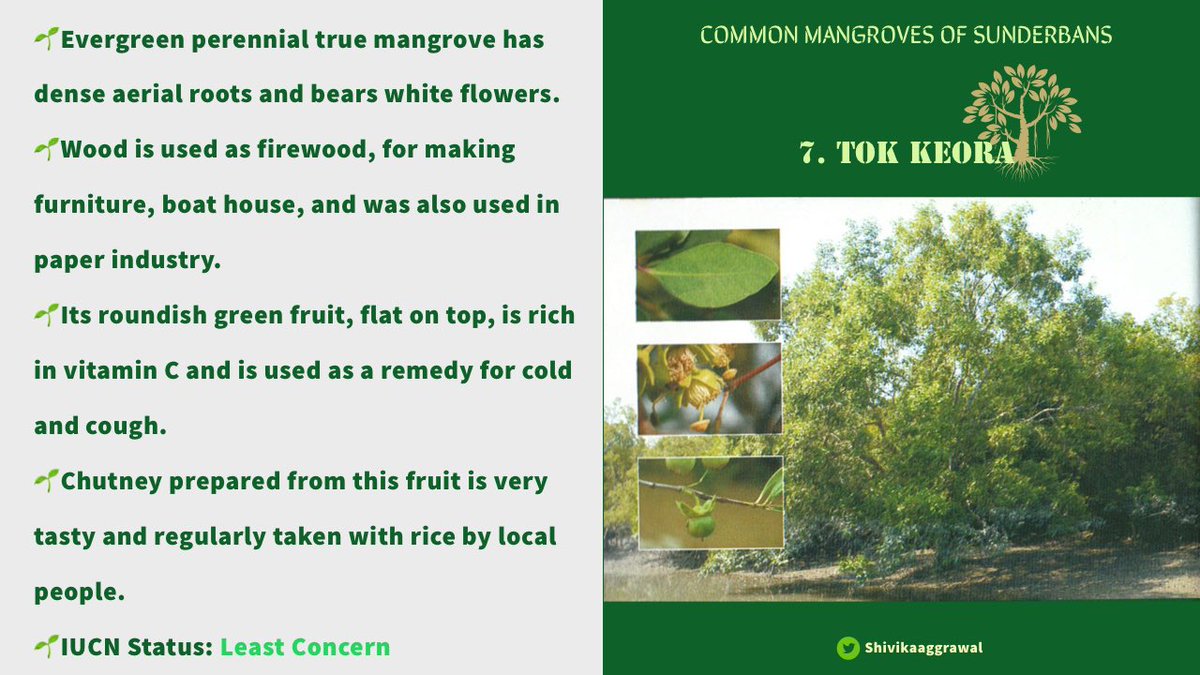 𝐓𝐎𝐊 𝐊𝐄𝐎𝐑𝐀https://abs.twimg.com/emoji/v2/... draggable="false" alt="🍃" title="Im Wind flatterndes Blatt" aria-label="Emoji: Im Wind flatterndes Blatt">https://abs.twimg.com/emoji/v2/... draggable="false" alt="🍋" title="Zitrone" aria-label="Emoji: Zitrone">Tok in Bengali means “sour”. Since fruits of Tok Keora are rich in Vitamin C, hence it is named this.https://abs.twimg.com/emoji/v2/... draggable="false" alt="🌿" title="Kräuter" aria-label="Emoji: Kräuter">Thick leaves hang downwards and have same color both sides (upper, under).https://abs.twimg.com/emoji/v2/... draggable="false" alt="✨" title="Funken" aria-label="Emoji: Funken">Calyx of flower is star shaped, hard, green, and four in number." title="https://abs.twimg.com/emoji/v2/... draggable="false" alt="🍃" title="Im Wind flatterndes Blatt" aria-label="Emoji: Im Wind flatterndes Blatt">𝐓𝐎𝐊 𝐊𝐄𝐎𝐑𝐀https://abs.twimg.com/emoji/v2/... draggable="false" alt="🍃" title="Im Wind flatterndes Blatt" aria-label="Emoji: Im Wind flatterndes Blatt">https://abs.twimg.com/emoji/v2/... draggable="false" alt="🍋" title="Zitrone" aria-label="Emoji: Zitrone">Tok in Bengali means “sour”. Since fruits of Tok Keora are rich in Vitamin C, hence it is named this.https://abs.twimg.com/emoji/v2/... draggable="false" alt="🌿" title="Kräuter" aria-label="Emoji: Kräuter">Thick leaves hang downwards and have same color both sides (upper, under).https://abs.twimg.com/emoji/v2/... draggable="false" alt="✨" title="Funken" aria-label="Emoji: Funken">Calyx of flower is star shaped, hard, green, and four in number." class="img-responsive" style="max-width:100%;"/>
𝐓𝐎𝐊 𝐊𝐄𝐎𝐑𝐀https://abs.twimg.com/emoji/v2/... draggable="false" alt="🍃" title="Im Wind flatterndes Blatt" aria-label="Emoji: Im Wind flatterndes Blatt">https://abs.twimg.com/emoji/v2/... draggable="false" alt="🍋" title="Zitrone" aria-label="Emoji: Zitrone">Tok in Bengali means “sour”. Since fruits of Tok Keora are rich in Vitamin C, hence it is named this.https://abs.twimg.com/emoji/v2/... draggable="false" alt="🌿" title="Kräuter" aria-label="Emoji: Kräuter">Thick leaves hang downwards and have same color both sides (upper, under).https://abs.twimg.com/emoji/v2/... draggable="false" alt="✨" title="Funken" aria-label="Emoji: Funken">Calyx of flower is star shaped, hard, green, and four in number." title="https://abs.twimg.com/emoji/v2/... draggable="false" alt="🍃" title="Im Wind flatterndes Blatt" aria-label="Emoji: Im Wind flatterndes Blatt">𝐓𝐎𝐊 𝐊𝐄𝐎𝐑𝐀https://abs.twimg.com/emoji/v2/... draggable="false" alt="🍃" title="Im Wind flatterndes Blatt" aria-label="Emoji: Im Wind flatterndes Blatt">https://abs.twimg.com/emoji/v2/... draggable="false" alt="🍋" title="Zitrone" aria-label="Emoji: Zitrone">Tok in Bengali means “sour”. Since fruits of Tok Keora are rich in Vitamin C, hence it is named this.https://abs.twimg.com/emoji/v2/... draggable="false" alt="🌿" title="Kräuter" aria-label="Emoji: Kräuter">Thick leaves hang downwards and have same color both sides (upper, under).https://abs.twimg.com/emoji/v2/... draggable="false" alt="✨" title="Funken" aria-label="Emoji: Funken">Calyx of flower is star shaped, hard, green, and four in number." class="img-responsive" style="max-width:100%;"/>

https://abs.twimg.com/emoji/v2/... draggable="false" alt="🍃" title="Im Wind flatterndes Blatt" aria-label="Emoji: Im Wind flatterndes Blatt">𝐂𝐇𝐀𝐊 𝐊𝐄𝐎𝐑𝐀

https://abs.twimg.com/emoji/v2/... draggable="false" alt="🍃" title="Im Wind flatterndes Blatt" aria-label="Emoji: Im Wind flatterndes Blatt">

https://abs.twimg.com/emoji/v2/... draggable="false" alt="🥌" title="Rollender Stein" aria-label="Emoji: Rollender Stein">Chak in Bengali means “wheel”. Its edible fruit looks like wheel from top which is roundish in shape while being tapered in the middle.

https://abs.twimg.com/emoji/v2/... draggable="false" alt="🥘" title="Flache Pfanne mit Essen" aria-label="Emoji: Flache Pfanne mit Essen">Fruit is cooked and used as condiment to flavor curries.

https://abs.twimg.com/emoji/v2/... draggable="false" alt="🩸" title="Tropfen Blut" aria-label="Emoji: Tropfen Blut">Fermented fruit juice relieves bleeding/haemorrhage.

https://abs.twimg.com/emoji/v2/... draggable="false" alt="🍃" title="Im Wind flatterndes Blatt" aria-label="Emoji: Im Wind flatterndes Blatt">𝐊𝐀𝐍𝐊𝐑𝐀

https://abs.twimg.com/emoji/v2/... draggable="false" alt="🍃" title="Im Wind flatterndes Blatt" aria-label="Emoji: Im Wind flatterndes Blatt">

https://abs.twimg.com/emoji/v2/... draggable="false" alt="🦀" title="Krabbe" aria-label="Emoji: Krabbe"> Kankra in Bengali means “crab”. Red bell-shaped calyx of flower is divided into number of strips which resemble to the legs of crab.

https://abs.twimg.com/emoji/v2/... draggable="false" alt="🌺" title="Hibiskus" aria-label="Emoji: Hibiskus">Small orange petals of flower almost remain invisible as they remain within the calyx.

https://abs.twimg.com/emoji/v2/... draggable="false" alt="🌳" title="Laubbaum" aria-label="Emoji: Laubbaum">Robust in nature, adapts well.

https://abs.twimg.com/emoji/v2/... draggable="false" alt="🍃" title="Im Wind flatterndes Blatt" aria-label="Emoji: Im Wind flatterndes Blatt">𝐁𝐎𝐊𝐔𝐋 𝐊𝐀𝐍𝐊𝐑𝐀

https://abs.twimg.com/emoji/v2/... draggable="false" alt="🍃" title="Im Wind flatterndes Blatt" aria-label="Emoji: Im Wind flatterndes Blatt">

https://abs.twimg.com/emoji/v2/... draggable="false" alt="🥀" title="Verwelkte Blume" aria-label="Emoji: Verwelkte Blume"> Bokul in Bengali means “bud”. Though similar in shape to that of Kankra, its flowers are very small in size. Even when full grown, appears like a bud.

https://abs.twimg.com/emoji/v2/... draggable="false" alt="🌼" title="Blüte" aria-label="Emoji: Blüte">Calyx is yellowish green and petals are butter yellow in color.

https://abs.twimg.com/emoji/v2/... draggable="false" alt="🍃" title="Im Wind flatterndes Blatt" aria-label="Emoji: Im Wind flatterndes Blatt">𝐌𝐀𝐓𝐇 𝐆𝐎𝐑𝐀𝐍

https://abs.twimg.com/emoji/v2/... draggable="false" alt="🍃" title="Im Wind flatterndes Blatt" aria-label="Emoji: Im Wind flatterndes Blatt">

https://abs.twimg.com/emoji/v2/... draggable="false" alt="🛕" title="Hindutempel" aria-label="Emoji: Hindutempel">Math,in Bengal, is place of worship. It is also known for their unique Bengal roof architecture.These mangroves resemble Math in shape.

https://abs.twimg.com/emoji/v2/... draggable="false" alt="🎋" title="Tanabata Baum" aria-label="Emoji: Tanabata Baum">It develops profusely branched root system.

https://abs.twimg.com/emoji/v2/... draggable="false" alt="🌳" title="Laubbaum" aria-label="Emoji: Laubbaum">Main stem flattens near the ground which appears like buttresses.

https://abs.twimg.com/emoji/v2/... draggable="false" alt="🍃" title="Im Wind flatterndes Blatt" aria-label="Emoji: Im Wind flatterndes Blatt">𝐉𝐇𝐀𝐌𝐓𝐈 𝐆𝐎𝐑𝐀𝐍

https://abs.twimg.com/emoji/v2/... draggable="false" alt="🍃" title="Im Wind flatterndes Blatt" aria-label="Emoji: Im Wind flatterndes Blatt">

https://abs.twimg.com/emoji/v2/... draggable="false" alt="🎍" title="Kiefer Dekoration" aria-label="Emoji: Kiefer Dekoration">Jhamti may have been derived from Hindi word jamat meaning “group”. They grow in cluster & give an appearance that young trees are growing together, though in reality they are matured.

https://abs.twimg.com/emoji/v2/... draggable="false" alt="🌸" title="Kirschblüte" aria-label="Emoji: Kirschblüte">Fruits and flowers are pretty similar to that of Math Goran.

https://abs.twimg.com/emoji/v2/... draggable="false" alt="🍃" title="Im Wind flatterndes Blatt" aria-label="Emoji: Im Wind flatterndes Blatt">𝐃𝐇𝐔𝐍𝐃𝐇𝐔𝐋

https://abs.twimg.com/emoji/v2/... draggable="false" alt="🍃" title="Im Wind flatterndes Blatt" aria-label="Emoji: Im Wind flatterndes Blatt">

https://abs.twimg.com/emoji/v2/... draggable="false" alt="☄️" title="Komet" aria-label="Emoji: Komet">Dhundhul is also known as “cannon ball” tree as it bears big round shaped fruits which turns woody and reddish brown when matured.

https://abs.twimg.com/emoji/v2/... draggable="false" alt="🪑" title="Stuhl" aria-label="Emoji: Stuhl"> It is known for its best quality timber used for making furniture, umbrella handle, flower vase, and carvings.

https://abs.twimg.com/emoji/v2/... draggable="false" alt="🍃" title="Im Wind flatterndes Blatt" aria-label="Emoji: Im Wind flatterndes Blatt">𝐏𝐀𝐒𝐇𝐔𝐑

https://abs.twimg.com/emoji/v2/... draggable="false" alt="🍃" title="Im Wind flatterndes Blatt" aria-label="Emoji: Im Wind flatterndes Blatt">

https://abs.twimg.com/emoji/v2/... draggable="false" alt="🦌" title="Hirsch" aria-label="Emoji: Hirsch">Pashur in Bengali translates to “animals”. Also, its a name of river in Sunderbans region of Bangladesh. So, the name of mangrove may have association with any of these.

https://abs.twimg.com/emoji/v2/... draggable="false" alt="🍀" title="Vierblättriges Kleeblatt" aria-label="Emoji: Vierblättriges Kleeblatt">Looks similar to Dhundhul tree but can be distinguished by the color of leaf.

https://abs.twimg.com/emoji/v2/... draggable="false" alt="🍃" title="Im Wind flatterndes Blatt" aria-label="Emoji: Im Wind flatterndes Blatt">𝐊𝐇𝐀𝐋𝐒𝐈

https://abs.twimg.com/emoji/v2/... draggable="false" alt="🍃" title="Im Wind flatterndes Blatt" aria-label="Emoji: Im Wind flatterndes Blatt">

https://abs.twimg.com/emoji/v2/... draggable="false" alt="🐐" title="Ziege" aria-label="Emoji: Ziege">Also called Black mangrove, River mangrove, & Goat&
#39;s horn mangrove.

https://abs.twimg.com/emoji/v2/... draggable="false" alt="🐠" title="Tropischer Fisch" aria-label="Emoji: Tropischer Fisch">Also, Khalsi (Bengali) translates to “redemption”. This may have association with toxic chemical saponin found in tree which is used in fisheries to clear out unwanted fishes & crabs.

https://abs.twimg.com/emoji/v2/... draggable="false" alt="🍃" title="Im Wind flatterndes Blatt" aria-label="Emoji: Im Wind flatterndes Blatt">𝐓𝐎𝐑𝐀

https://abs.twimg.com/emoji/v2/... draggable="false" alt="🍃" title="Im Wind flatterndes Blatt" aria-label="Emoji: Im Wind flatterndes Blatt">

https://abs.twimg.com/emoji/v2/... draggable="false" alt="🌟" title="Leuchtender Stern" aria-label="Emoji: Leuchtender Stern">Tora, in Bengali, translates to “star”. Since this mangrove bears white, small, star-shaped flowers; it might have been named Tora.

https://abs.twimg.com/emoji/v2/... draggable="false" alt="🧂" title="Salt" aria-label="Emoji: Salt"> Its shining leaves have high density of salt glands. Therefore, dried leaves were used to prepare table salts.
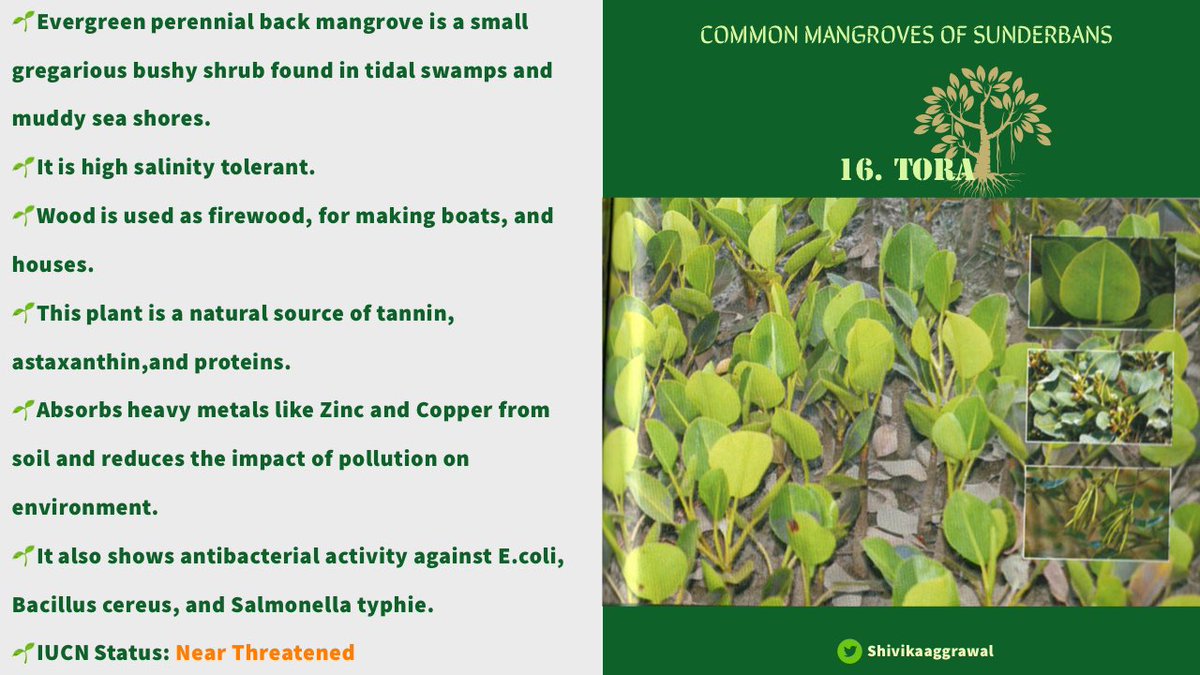 𝐓𝐎𝐑𝐀https://abs.twimg.com/emoji/v2/... draggable="false" alt="🍃" title="Im Wind flatterndes Blatt" aria-label="Emoji: Im Wind flatterndes Blatt">https://abs.twimg.com/emoji/v2/... draggable="false" alt="🌟" title="Leuchtender Stern" aria-label="Emoji: Leuchtender Stern">Tora, in Bengali, translates to “star”. Since this mangrove bears white, small, star-shaped flowers; it might have been named Tora. https://abs.twimg.com/emoji/v2/... draggable="false" alt="🧂" title="Salt" aria-label="Emoji: Salt"> Its shining leaves have high density of salt glands. Therefore, dried leaves were used to prepare table salts." title="https://abs.twimg.com/emoji/v2/... draggable="false" alt="🍃" title="Im Wind flatterndes Blatt" aria-label="Emoji: Im Wind flatterndes Blatt">𝐓𝐎𝐑𝐀https://abs.twimg.com/emoji/v2/... draggable="false" alt="🍃" title="Im Wind flatterndes Blatt" aria-label="Emoji: Im Wind flatterndes Blatt">https://abs.twimg.com/emoji/v2/... draggable="false" alt="🌟" title="Leuchtender Stern" aria-label="Emoji: Leuchtender Stern">Tora, in Bengali, translates to “star”. Since this mangrove bears white, small, star-shaped flowers; it might have been named Tora. https://abs.twimg.com/emoji/v2/... draggable="false" alt="🧂" title="Salt" aria-label="Emoji: Salt"> Its shining leaves have high density of salt glands. Therefore, dried leaves were used to prepare table salts." class="img-responsive" style="max-width:100%;"/>
𝐓𝐎𝐑𝐀https://abs.twimg.com/emoji/v2/... draggable="false" alt="🍃" title="Im Wind flatterndes Blatt" aria-label="Emoji: Im Wind flatterndes Blatt">https://abs.twimg.com/emoji/v2/... draggable="false" alt="🌟" title="Leuchtender Stern" aria-label="Emoji: Leuchtender Stern">Tora, in Bengali, translates to “star”. Since this mangrove bears white, small, star-shaped flowers; it might have been named Tora. https://abs.twimg.com/emoji/v2/... draggable="false" alt="🧂" title="Salt" aria-label="Emoji: Salt"> Its shining leaves have high density of salt glands. Therefore, dried leaves were used to prepare table salts." title="https://abs.twimg.com/emoji/v2/... draggable="false" alt="🍃" title="Im Wind flatterndes Blatt" aria-label="Emoji: Im Wind flatterndes Blatt">𝐓𝐎𝐑𝐀https://abs.twimg.com/emoji/v2/... draggable="false" alt="🍃" title="Im Wind flatterndes Blatt" aria-label="Emoji: Im Wind flatterndes Blatt">https://abs.twimg.com/emoji/v2/... draggable="false" alt="🌟" title="Leuchtender Stern" aria-label="Emoji: Leuchtender Stern">Tora, in Bengali, translates to “star”. Since this mangrove bears white, small, star-shaped flowers; it might have been named Tora. https://abs.twimg.com/emoji/v2/... draggable="false" alt="🧂" title="Salt" aria-label="Emoji: Salt"> Its shining leaves have high density of salt glands. Therefore, dried leaves were used to prepare table salts." class="img-responsive" style="max-width:100%;"/>

https://abs.twimg.com/emoji/v2/... draggable="false" alt="🍃" title="Im Wind flatterndes Blatt" aria-label="Emoji: Im Wind flatterndes Blatt">𝐇𝐄𝐍𝐓𝐀𝐋

https://abs.twimg.com/emoji/v2/... draggable="false" alt="🍃" title="Im Wind flatterndes Blatt" aria-label="Emoji: Im Wind flatterndes Blatt">

https://abs.twimg.com/emoji/v2/... draggable="false" alt="🌴" title="Palme" aria-label="Emoji: Palme">Hental is derived from a Sanskrit word Hintāla meaning “marshland date palm” where Hin stands for short (palm) and tāla for marsh. It is also known as Sea Dates.

https://abs.twimg.com/emoji/v2/... draggable="false" alt="🐅" title="Tiger" aria-label="Emoji: Tiger">It is also called Tiger palm as it provides Big cats perfect camouflage.
#WorldTigerDay2020

https://abs.twimg.com/emoji/v2/... draggable="false" alt="🍃" title="Im Wind flatterndes Blatt" aria-label="Emoji: Im Wind flatterndes Blatt">𝐆𝐎𝐋𝐏𝐀𝐓𝐀

https://abs.twimg.com/emoji/v2/... draggable="false" alt="🍃" title="Im Wind flatterndes Blatt" aria-label="Emoji: Im Wind flatterndes Blatt">

https://abs.twimg.com/emoji/v2/... draggable="false" alt="🥥" title="Kokosnuss" aria-label="Emoji: Kokosnuss"> Golpata is named so as it has Pata (leaf in Hindi) very similar to that of Gola (coconut in Hindi) tree.

https://abs.twimg.com/emoji/v2/... draggable="false" alt="🌴" title="Palme" aria-label="Emoji: Palme">Though called “Mangrove Palm”, it is only moderately salt tolerant and prefers brackish waters of estuaries.

https://abs.twimg.com/emoji/v2/... draggable="false" alt="🍃" title="Im Wind flatterndes Blatt" aria-label="Emoji: Im Wind flatterndes Blatt">𝐊𝐑𝐈𝐏𝐀𝐋

https://abs.twimg.com/emoji/v2/... draggable="false" alt="🍃" title="Im Wind flatterndes Blatt" aria-label="Emoji: Im Wind flatterndes Blatt">

https://abs.twimg.com/emoji/v2/... draggable="false" alt="🕊" title="Friedens-Taube" aria-label="Emoji: Friedens-Taube">This “white flowered black mangrove” is a pretty plant having spoon shaped leaves.

https://abs.twimg.com/emoji/v2/... draggable="false" alt="🍂" title="Gefallenes Blatt" aria-label="Emoji: Gefallenes Blatt">It develops pneumatophores and often has stilt roots.

https://abs.twimg.com/emoji/v2/... draggable="false" alt="🟤" title="Brauner Kreis" aria-label="Emoji: Brauner Kreis">Its woody fruit contains only one seed.

https://abs.twimg.com/emoji/v2/... draggable="false" alt="🍃" title="Im Wind flatterndes Blatt" aria-label="Emoji: Im Wind flatterndes Blatt">𝐇𝐔𝐁𝐋𝐈

https://abs.twimg.com/emoji/v2/... draggable="false" alt="🍃" title="Im Wind flatterndes Blatt" aria-label="Emoji: Im Wind flatterndes Blatt">

https://abs.twimg.com/emoji/v2/... draggable="false" alt="🌷" title="Tulpe" aria-label="Emoji: Tulpe">Commonly known as Indian tulip tree is able to grow in wide range of soil types present in coastal environments.

https://abs.twimg.com/emoji/v2/... draggable="false" alt="🍏" title="Grüner Apfel" aria-label="Emoji: Grüner Apfel">It is also known as “Aden Apple tree” as flowers are followed by apple-shaped fruit.

https://abs.twimg.com/emoji/v2/... draggable="false" alt="🍃" title="Im Wind flatterndes Blatt" aria-label="Emoji: Im Wind flatterndes Blatt">𝐆𝐈𝐑𝐈𝐘𝐀 𝐒𝐇𝐀𝐊

https://abs.twimg.com/emoji/v2/... draggable="false" alt="🍃" title="Im Wind flatterndes Blatt" aria-label="Emoji: Im Wind flatterndes Blatt">

https://abs.twimg.com/emoji/v2/... draggable="false" alt="🥬" title="Leafy green" aria-label="Emoji: Leafy green">Shak in Bengali refers to green leafy vegetable called spinach. Similarly Giriya Shak is consumed as a green leafy vegetable.

https://abs.twimg.com/emoji/v2/... draggable="false" alt="📏" title="Gerades Lineal" aria-label="Emoji: Gerades Lineal">Generally donot grow more than one and half feet in height.

https://abs.twimg.com/emoji/v2/... draggable="false" alt="🍃" title="Im Wind flatterndes Blatt" aria-label="Emoji: Im Wind flatterndes Blatt">𝐍𝐎𝐍𝐀 𝐒𝐇𝐀𝐊

https://abs.twimg.com/emoji/v2/... draggable="false" alt="🍃" title="Im Wind flatterndes Blatt" aria-label="Emoji: Im Wind flatterndes Blatt">

https://abs.twimg.com/emoji/v2/... draggable="false" alt="🥗" title="Grüner Salat" aria-label="Emoji: Grüner Salat">As its name suggests, nona shak, is consumed as green leafy vegetable.

https://abs.twimg.com/emoji/v2/... draggable="false" alt="🧂" title="Salt" aria-label="Emoji: Salt">Due to its high salt content, it is also used as a seasoning with other foods.

https://abs.twimg.com/emoji/v2/... draggable="false" alt="🍃" title="Im Wind flatterndes Blatt" aria-label="Emoji: Im Wind flatterndes Blatt">𝐇𝐔𝐃𝐎

https://abs.twimg.com/emoji/v2/... draggable="false" alt="🍃" title="Im Wind flatterndes Blatt" aria-label="Emoji: Im Wind flatterndes Blatt">

https://abs.twimg.com/emoji/v2/... draggable="false" alt="🍁" title="Ahornblatt" aria-label="Emoji: Ahornblatt">Only mangrove terrestrial fern is commonly known as “Golden Leather Fern” owingto its matured reddish aand dark brown elongated leaves.

https://abs.twimg.com/emoji/v2/... draggable="false" alt="🌊" title="Wasserwelle" aria-label="Emoji: Wasserwelle">Grows in upper reaches of tidal zone, perticularly, from where tidal water has retreated.

https://abs.twimg.com/emoji/v2/... draggable="false" alt="🍃" title="Im Wind flatterndes Blatt" aria-label="Emoji: Im Wind flatterndes Blatt">𝐃𝐇𝐀𝐍𝐈 𝐆𝐇𝐀𝐒

https://abs.twimg.com/emoji/v2/... draggable="false" alt="🍃" title="Im Wind flatterndes Blatt" aria-label="Emoji: Im Wind flatterndes Blatt">

https://abs.twimg.com/emoji/v2/... draggable="false" alt="🌾" title="Reisgetreide" aria-label="Emoji: Reisgetreide">Dhani Ghas is named so as this grass (ghas) belongs to the paddy (dhani) family.

https://abs.twimg.com/emoji/v2/... draggable="false" alt="🧂" title="Salt" aria-label="Emoji: Salt"> A pioneer species of mangrove excretes salt crystals through its leaves.

https://abs.twimg.com/emoji/v2/... draggable="false" alt="🐒" title="Affe" aria-label="Emoji: Affe"> Roots are preferred food of wild boars and even rhesus monkey.

https://abs.twimg.com/emoji/v2/... draggable="false" alt="🍃" title="Im Wind flatterndes Blatt" aria-label="Emoji: Im Wind flatterndes Blatt">𝐊𝐀𝐋𝐌𝐈 𝐋𝐀𝐓𝐀

https://abs.twimg.com/emoji/v2/... draggable="false" alt="🍃" title="Im Wind flatterndes Blatt" aria-label="Emoji: Im Wind flatterndes Blatt">

https://abs.twimg.com/emoji/v2/... draggable="false" alt="🎋" title="Tanabata Baum" aria-label="Emoji: Tanabata Baum">Kalam refers to “stem” and Lata means “creeper”, therefore, name suggests that it is a creeper with a woody stem.

https://abs.twimg.com/emoji/v2/... draggable="false" alt="🌸" title="Kirschblüte" aria-label="Emoji: Kirschblüte">It has beautiful flowers which are bell-shaped and face towards the sky. They are deep magenta colored inside and pink outside.

https://abs.twimg.com/emoji/v2/... draggable="false" alt="🍃" title="Im Wind flatterndes Blatt" aria-label="Emoji: Im Wind flatterndes Blatt">𝐉𝐎𝐃𝐔𝐏𝐀𝐋𝐎𝐍𝐆

https://abs.twimg.com/emoji/v2/... draggable="false" alt="🍃" title="Im Wind flatterndes Blatt" aria-label="Emoji: Im Wind flatterndes Blatt">

https://abs.twimg.com/emoji/v2/... draggable="false" alt="🥬" title="Leafy green" aria-label="Emoji: Leafy green">Palong translates to “spinach” or “vegetable”. Since its taken as food by local people, this creeping herb, is named so.

https://abs.twimg.com/emoji/v2/... draggable="false" alt="🌟" title="Leuchtender Stern" aria-label="Emoji: Leuchtender Stern">Its 5-petals star-shaped pink flowers look beautiful.

https://abs.twimg.com/emoji/v2/... draggable="false" alt="🍃" title="Im Wind flatterndes Blatt" aria-label="Emoji: Im Wind flatterndes Blatt">𝐌𝐀𝐍𝐃𝐀

https://abs.twimg.com/emoji/v2/... draggable="false" alt="🍃" title="Im Wind flatterndes Blatt" aria-label="Emoji: Im Wind flatterndes Blatt">

https://abs.twimg.com/emoji/v2/... draggable="false" alt="🐌" title="Schnecke" aria-label="Emoji: Schnecke">Manda seems to be derived from Sanskrit word which roughly translates to slow, tardy,sick,bad something that can be associated with parasites.

https://abs.twimg.com/emoji/v2/... draggable="false" alt="☘️" title="Kleeblatt" aria-label="Emoji: Kleeblatt">Remains almost fully camouflaged within the main tree except at the time of flowering.

https://abs.twimg.com/emoji/v2/... draggable="false" alt="🍃" title="Im Wind flatterndes Blatt" aria-label="Emoji: Im Wind flatterndes Blatt">𝐁𝐎𝐑𝐎 𝐌𝐀𝐍𝐃𝐀

https://abs.twimg.com/emoji/v2/... draggable="false" alt="🍃" title="Im Wind flatterndes Blatt" aria-label="Emoji: Im Wind flatterndes Blatt">

https://abs.twimg.com/emoji/v2/... draggable="false" alt="🍀" title="Vierblättriges Kleeblatt" aria-label="Emoji: Vierblättriges Kleeblatt">Boro means “big” in Bengali. Since, its leaves are bigger than Manda; it is named so.

https://abs.twimg.com/emoji/v2/... draggable="false" alt="🌺" title="Hibiskus" aria-label="Emoji: Hibiskus">Red and yellow flowers make the plant visible during flowering season, otherwise it remains well camouflaged within the main tree.

https://abs.twimg.com/emoji/v2/... draggable="false" alt="🍃" title="Im Wind flatterndes Blatt" aria-label="Emoji: Im Wind flatterndes Blatt">𝐒𝐔𝐓𝐎 𝐒𝐇𝐀𝐎𝐋𝐀

https://abs.twimg.com/emoji/v2/... draggable="false" alt="🍃" title="Im Wind flatterndes Blatt" aria-label="Emoji: Im Wind flatterndes Blatt">

https://abs.twimg.com/emoji/v2/... draggable="false" alt="🧶" title="Yarn" aria-label="Emoji: Yarn">Suto in Bengali means “thread” whereas Shaola means “algae”. This algae is named so as it looks like green thread floating in water.

https://abs.twimg.com/emoji/v2/... draggable="false" alt="🍃" title="Im Wind flatterndes Blatt" aria-label="Emoji: Im Wind flatterndes Blatt">𝐒𝐎𝐁𝐔𝐉 𝐒𝐇𝐀𝐎𝐋𝐀

https://abs.twimg.com/emoji/v2/... draggable="false" alt="🍃" title="Im Wind flatterndes Blatt" aria-label="Emoji: Im Wind flatterndes Blatt">

https://abs.twimg.com/emoji/v2/... draggable="false" alt="🌿" title="Kräuter" aria-label="Emoji: Kräuter">Sobuj means “green” in Bengali. Since this algae is green in color, it is called so.

https://abs.twimg.com/emoji/v2/... draggable="false" alt="🍃" title="Im Wind flatterndes Blatt" aria-label="Emoji: Im Wind flatterndes Blatt">𝐍𝐎𝐍𝐀𝐉𝐇𝐀𝐔/𝐁𝐎𝐍𝐉𝐇𝐀𝐔

https://abs.twimg.com/emoji/v2/... draggable="false" alt="🍃" title="Im Wind flatterndes Blatt" aria-label="Emoji: Im Wind flatterndes Blatt">

https://abs.twimg.com/emoji/v2/... draggable="false" alt="🎋" title="Tanabata Baum" aria-label="Emoji: Tanabata Baum">Commonly known as Indian Tamarisk is called “jhau” in Hindi and Bengali.

https://abs.twimg.com/emoji/v2/... draggable="false" alt="🥀" title="Verwelkte Blume" aria-label="Emoji: Verwelkte Blume">Its flowers are borne on long and slender racemes.

https://abs.twimg.com/emoji/v2/... draggable="false" alt="🍃" title="Im Wind flatterndes Blatt" aria-label="Emoji: Im Wind flatterndes Blatt">𝐇𝐎𝐑𝐆𝐎𝐉𝐀

https://abs.twimg.com/emoji/v2/... draggable="false" alt="🍃" title="Im Wind flatterndes Blatt" aria-label="Emoji: Im Wind flatterndes Blatt">

https://abs.twimg.com/emoji/v2/... draggable="false" alt="🌺" title="Hibiskus" aria-label="Emoji: Hibiskus">Its leaves and flowers are quite different in shape.

https://abs.twimg.com/emoji/v2/... draggable="false" alt="🍀" title="Vierblättriges Kleeblatt" aria-label="Emoji: Vierblättriges Kleeblatt">Leaves are bright green, thorny, and twisted horizontally.

https://abs.twimg.com/emoji/v2/... draggable="false" alt="🌸" title="Kirschblüte" aria-label="Emoji: Kirschblüte">Horgoja is known for its beautiful bright purple flowers.

https://abs.twimg.com/emoji/v2/... draggable="false" alt="🍃" title="Im Wind flatterndes Blatt" aria-label="Emoji: Im Wind flatterndes Blatt">𝐓𝐇𝐀𝐍𝐊 𝐘𝐎𝐔

https://abs.twimg.com/emoji/v2/... draggable="false" alt="🍃" title="Im Wind flatterndes Blatt" aria-label="Emoji: Im Wind flatterndes Blatt">
I request you to share this thread esp with school & college going students. It&
#39;s important that they know about these beautiful ecosystems irrespective of their streams, take interest & think of pursuing higher studies & research in this unexplored domain.
Tip: mention @twtextapp on a Twitter thread with the keyword “unroll” to get a link to it.

 Read on Twitter
Read on Twitter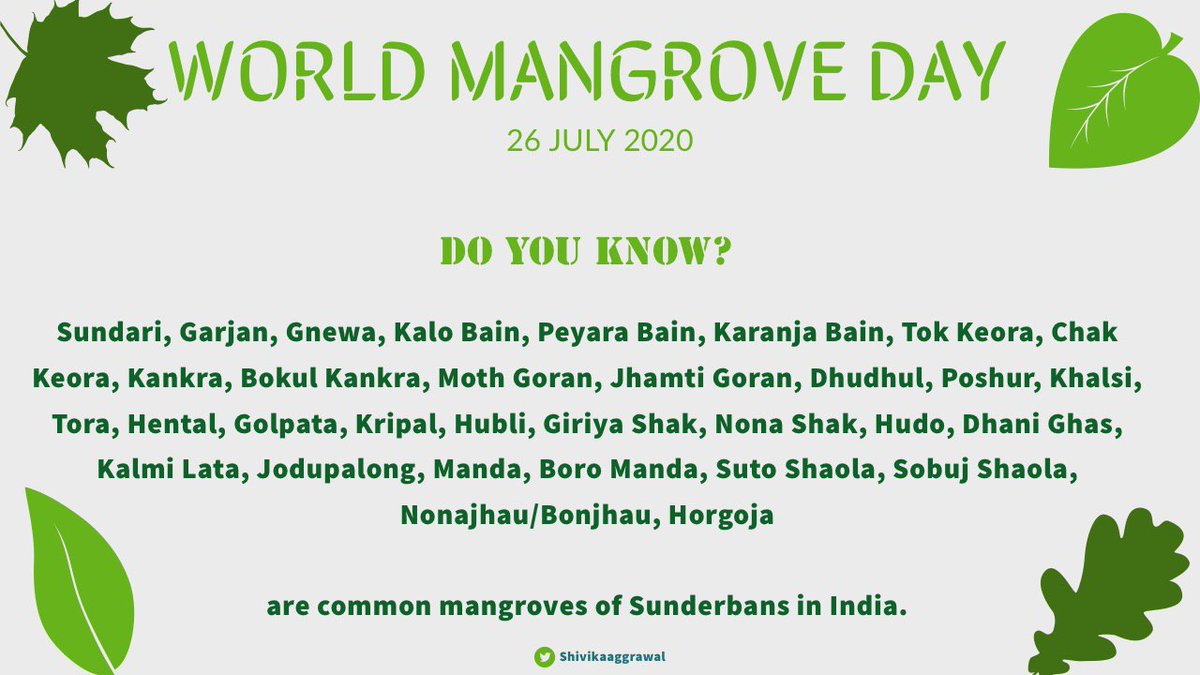 https://abs.twimg.com/emoji/v2/... draggable="false" alt="🌿" title="Kräuter" aria-label="Emoji: Kräuter">Let& #39;s know more about 𝐂𝐨𝐦𝐦𝐨𝐧 𝐌𝐚𝐧𝐠𝐫𝐨𝐯𝐞𝐬 𝐨𝐟 𝐒𝐮𝐧𝐝𝐞𝐫𝐛𝐚𝐧𝐬 this #WorldMangroveDay2020. For coming one week, I shall be sharing about these unique plants.https://abs.twimg.com/emoji/v2/... draggable="false" alt="🌿" title="Kräuter" aria-label="Emoji: Kräuter">https://abs.twimg.com/emoji/v2/... draggable="false" alt="🍃" title="Im Wind flatterndes Blatt" aria-label="Emoji: Im Wind flatterndes Blatt"> @ParveenKaswan @deespeak @susantananda3 @RandeepHooda @narendramodi @LicypriyaK @ZebaZoariahAhsa" title="https://abs.twimg.com/emoji/v2/... draggable="false" alt="🍃" title="Im Wind flatterndes Blatt" aria-label="Emoji: Im Wind flatterndes Blatt">https://abs.twimg.com/emoji/v2/... draggable="false" alt="🌿" title="Kräuter" aria-label="Emoji: Kräuter">Let& #39;s know more about 𝐂𝐨𝐦𝐦𝐨𝐧 𝐌𝐚𝐧𝐠𝐫𝐨𝐯𝐞𝐬 𝐨𝐟 𝐒𝐮𝐧𝐝𝐞𝐫𝐛𝐚𝐧𝐬 this #WorldMangroveDay2020. For coming one week, I shall be sharing about these unique plants.https://abs.twimg.com/emoji/v2/... draggable="false" alt="🌿" title="Kräuter" aria-label="Emoji: Kräuter">https://abs.twimg.com/emoji/v2/... draggable="false" alt="🍃" title="Im Wind flatterndes Blatt" aria-label="Emoji: Im Wind flatterndes Blatt"> @ParveenKaswan @deespeak @susantananda3 @RandeepHooda @narendramodi @LicypriyaK @ZebaZoariahAhsa" class="img-responsive" style="max-width:100%;"/>
https://abs.twimg.com/emoji/v2/... draggable="false" alt="🌿" title="Kräuter" aria-label="Emoji: Kräuter">Let& #39;s know more about 𝐂𝐨𝐦𝐦𝐨𝐧 𝐌𝐚𝐧𝐠𝐫𝐨𝐯𝐞𝐬 𝐨𝐟 𝐒𝐮𝐧𝐝𝐞𝐫𝐛𝐚𝐧𝐬 this #WorldMangroveDay2020. For coming one week, I shall be sharing about these unique plants.https://abs.twimg.com/emoji/v2/... draggable="false" alt="🌿" title="Kräuter" aria-label="Emoji: Kräuter">https://abs.twimg.com/emoji/v2/... draggable="false" alt="🍃" title="Im Wind flatterndes Blatt" aria-label="Emoji: Im Wind flatterndes Blatt"> @ParveenKaswan @deespeak @susantananda3 @RandeepHooda @narendramodi @LicypriyaK @ZebaZoariahAhsa" title="https://abs.twimg.com/emoji/v2/... draggable="false" alt="🍃" title="Im Wind flatterndes Blatt" aria-label="Emoji: Im Wind flatterndes Blatt">https://abs.twimg.com/emoji/v2/... draggable="false" alt="🌿" title="Kräuter" aria-label="Emoji: Kräuter">Let& #39;s know more about 𝐂𝐨𝐦𝐦𝐨𝐧 𝐌𝐚𝐧𝐠𝐫𝐨𝐯𝐞𝐬 𝐨𝐟 𝐒𝐮𝐧𝐝𝐞𝐫𝐛𝐚𝐧𝐬 this #WorldMangroveDay2020. For coming one week, I shall be sharing about these unique plants.https://abs.twimg.com/emoji/v2/... draggable="false" alt="🌿" title="Kräuter" aria-label="Emoji: Kräuter">https://abs.twimg.com/emoji/v2/... draggable="false" alt="🍃" title="Im Wind flatterndes Blatt" aria-label="Emoji: Im Wind flatterndes Blatt"> @ParveenKaswan @deespeak @susantananda3 @RandeepHooda @narendramodi @LicypriyaK @ZebaZoariahAhsa" class="img-responsive" style="max-width:100%;"/>
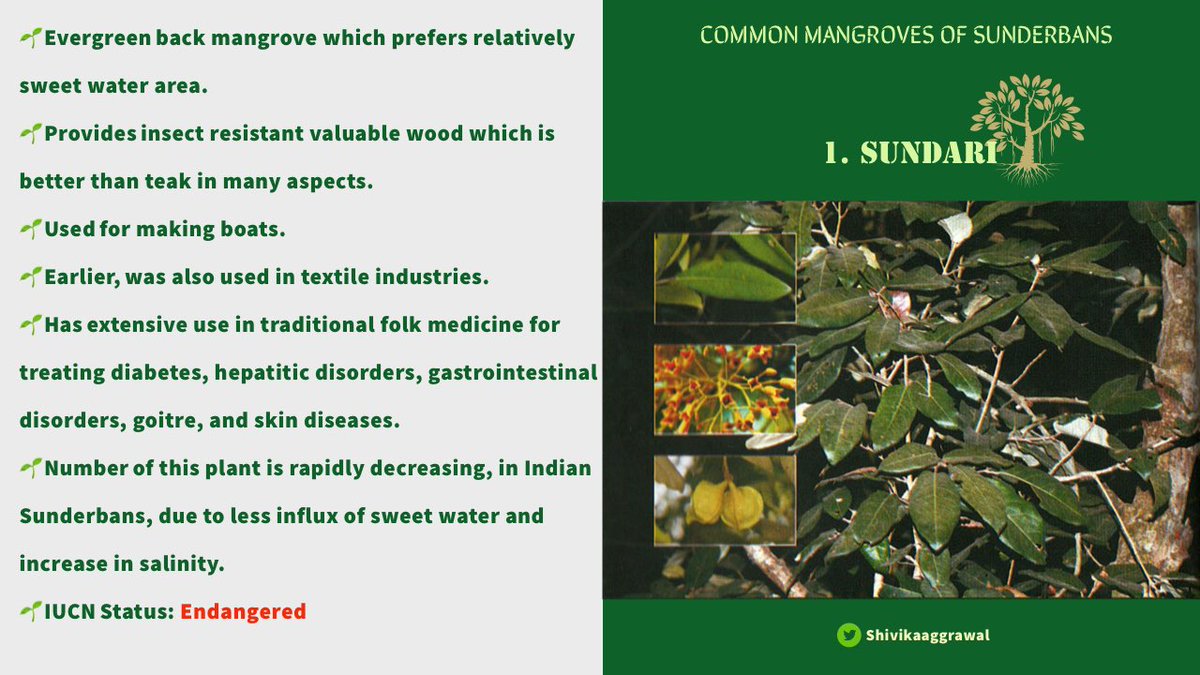 𝐒𝐔𝐍𝐃𝐀𝐑𝐈https://abs.twimg.com/emoji/v2/... draggable="false" alt="🍃" title="Im Wind flatterndes Blatt" aria-label="Emoji: Im Wind flatterndes Blatt">https://abs.twimg.com/emoji/v2/... draggable="false" alt="🌳" title="Laubbaum" aria-label="Emoji: Laubbaum">Name says it all, its a beautiful tall tree. Name “Sunderbans”is said to be derived from this.https://abs.twimg.com/emoji/v2/... draggable="false" alt="🛎" title="Empfangsglocke" aria-label="Emoji: Empfangsglocke">Its beautiful small bell shaped flowers have cream colored petals which are reddish inside.https://abs.twimg.com/emoji/v2/... draggable="false" alt="🍈" title="Melone" aria-label="Emoji: Melone">Bears roundish thin woody fruit with ridges along length&breadth." title="https://abs.twimg.com/emoji/v2/... draggable="false" alt="🍃" title="Im Wind flatterndes Blatt" aria-label="Emoji: Im Wind flatterndes Blatt">𝐒𝐔𝐍𝐃𝐀𝐑𝐈https://abs.twimg.com/emoji/v2/... draggable="false" alt="🍃" title="Im Wind flatterndes Blatt" aria-label="Emoji: Im Wind flatterndes Blatt">https://abs.twimg.com/emoji/v2/... draggable="false" alt="🌳" title="Laubbaum" aria-label="Emoji: Laubbaum">Name says it all, its a beautiful tall tree. Name “Sunderbans”is said to be derived from this.https://abs.twimg.com/emoji/v2/... draggable="false" alt="🛎" title="Empfangsglocke" aria-label="Emoji: Empfangsglocke">Its beautiful small bell shaped flowers have cream colored petals which are reddish inside.https://abs.twimg.com/emoji/v2/... draggable="false" alt="🍈" title="Melone" aria-label="Emoji: Melone">Bears roundish thin woody fruit with ridges along length&breadth." class="img-responsive" style="max-width:100%;"/>
𝐒𝐔𝐍𝐃𝐀𝐑𝐈https://abs.twimg.com/emoji/v2/... draggable="false" alt="🍃" title="Im Wind flatterndes Blatt" aria-label="Emoji: Im Wind flatterndes Blatt">https://abs.twimg.com/emoji/v2/... draggable="false" alt="🌳" title="Laubbaum" aria-label="Emoji: Laubbaum">Name says it all, its a beautiful tall tree. Name “Sunderbans”is said to be derived from this.https://abs.twimg.com/emoji/v2/... draggable="false" alt="🛎" title="Empfangsglocke" aria-label="Emoji: Empfangsglocke">Its beautiful small bell shaped flowers have cream colored petals which are reddish inside.https://abs.twimg.com/emoji/v2/... draggable="false" alt="🍈" title="Melone" aria-label="Emoji: Melone">Bears roundish thin woody fruit with ridges along length&breadth." title="https://abs.twimg.com/emoji/v2/... draggable="false" alt="🍃" title="Im Wind flatterndes Blatt" aria-label="Emoji: Im Wind flatterndes Blatt">𝐒𝐔𝐍𝐃𝐀𝐑𝐈https://abs.twimg.com/emoji/v2/... draggable="false" alt="🍃" title="Im Wind flatterndes Blatt" aria-label="Emoji: Im Wind flatterndes Blatt">https://abs.twimg.com/emoji/v2/... draggable="false" alt="🌳" title="Laubbaum" aria-label="Emoji: Laubbaum">Name says it all, its a beautiful tall tree. Name “Sunderbans”is said to be derived from this.https://abs.twimg.com/emoji/v2/... draggable="false" alt="🛎" title="Empfangsglocke" aria-label="Emoji: Empfangsglocke">Its beautiful small bell shaped flowers have cream colored petals which are reddish inside.https://abs.twimg.com/emoji/v2/... draggable="false" alt="🍈" title="Melone" aria-label="Emoji: Melone">Bears roundish thin woody fruit with ridges along length&breadth." class="img-responsive" style="max-width:100%;"/>
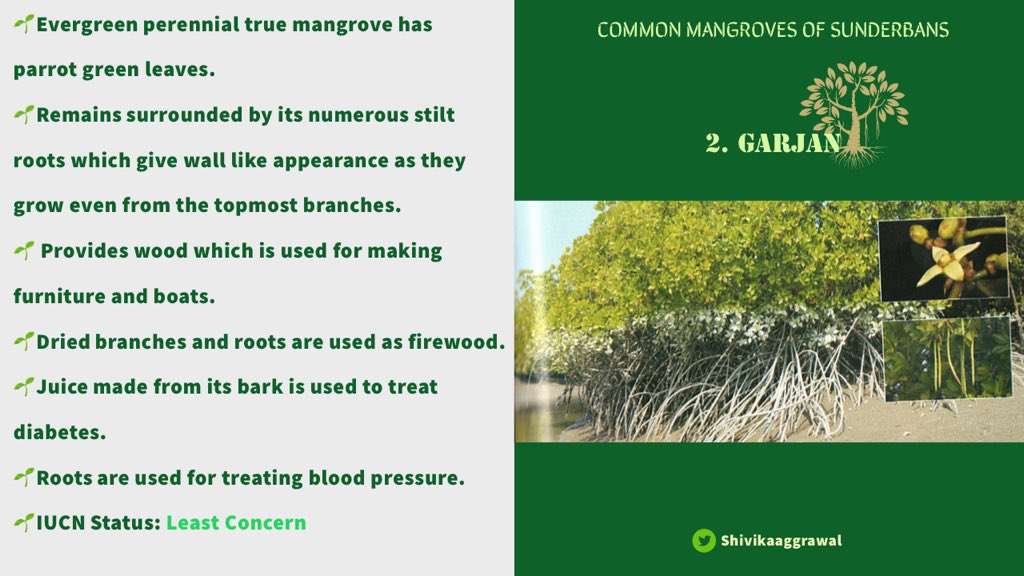 𝐆𝐀𝐑𝐉𝐀𝐍https://abs.twimg.com/emoji/v2/... draggable="false" alt="🍃" title="Im Wind flatterndes Blatt" aria-label="Emoji: Im Wind flatterndes Blatt">https://abs.twimg.com/emoji/v2/... draggable="false" alt="🐅" title="Tiger" aria-label="Emoji: Tiger">Home to tigers, its name is apt which means “roar”. https://abs.twimg.com/emoji/v2/... draggable="false" alt="☔️" title="Regenschirm mit Regentropfen" aria-label="Emoji: Regenschirm mit Regentropfen">Also known as mangrove on stilts. Long umbrella shaped stilt roots provide a broad solid base helping keep it stable even in loose sand.https://abs.twimg.com/emoji/v2/... draggable="false" alt="🌬" title="Wind blasendes Gesicht" aria-label="Emoji: Wind blasendes Gesicht">Aerial “knee roots” help entire underground root system breathe." title="https://abs.twimg.com/emoji/v2/... draggable="false" alt="🍃" title="Im Wind flatterndes Blatt" aria-label="Emoji: Im Wind flatterndes Blatt">𝐆𝐀𝐑𝐉𝐀𝐍https://abs.twimg.com/emoji/v2/... draggable="false" alt="🍃" title="Im Wind flatterndes Blatt" aria-label="Emoji: Im Wind flatterndes Blatt">https://abs.twimg.com/emoji/v2/... draggable="false" alt="🐅" title="Tiger" aria-label="Emoji: Tiger">Home to tigers, its name is apt which means “roar”. https://abs.twimg.com/emoji/v2/... draggable="false" alt="☔️" title="Regenschirm mit Regentropfen" aria-label="Emoji: Regenschirm mit Regentropfen">Also known as mangrove on stilts. Long umbrella shaped stilt roots provide a broad solid base helping keep it stable even in loose sand.https://abs.twimg.com/emoji/v2/... draggable="false" alt="🌬" title="Wind blasendes Gesicht" aria-label="Emoji: Wind blasendes Gesicht">Aerial “knee roots” help entire underground root system breathe." class="img-responsive" style="max-width:100%;"/>
𝐆𝐀𝐑𝐉𝐀𝐍https://abs.twimg.com/emoji/v2/... draggable="false" alt="🍃" title="Im Wind flatterndes Blatt" aria-label="Emoji: Im Wind flatterndes Blatt">https://abs.twimg.com/emoji/v2/... draggable="false" alt="🐅" title="Tiger" aria-label="Emoji: Tiger">Home to tigers, its name is apt which means “roar”. https://abs.twimg.com/emoji/v2/... draggable="false" alt="☔️" title="Regenschirm mit Regentropfen" aria-label="Emoji: Regenschirm mit Regentropfen">Also known as mangrove on stilts. Long umbrella shaped stilt roots provide a broad solid base helping keep it stable even in loose sand.https://abs.twimg.com/emoji/v2/... draggable="false" alt="🌬" title="Wind blasendes Gesicht" aria-label="Emoji: Wind blasendes Gesicht">Aerial “knee roots” help entire underground root system breathe." title="https://abs.twimg.com/emoji/v2/... draggable="false" alt="🍃" title="Im Wind flatterndes Blatt" aria-label="Emoji: Im Wind flatterndes Blatt">𝐆𝐀𝐑𝐉𝐀𝐍https://abs.twimg.com/emoji/v2/... draggable="false" alt="🍃" title="Im Wind flatterndes Blatt" aria-label="Emoji: Im Wind flatterndes Blatt">https://abs.twimg.com/emoji/v2/... draggable="false" alt="🐅" title="Tiger" aria-label="Emoji: Tiger">Home to tigers, its name is apt which means “roar”. https://abs.twimg.com/emoji/v2/... draggable="false" alt="☔️" title="Regenschirm mit Regentropfen" aria-label="Emoji: Regenschirm mit Regentropfen">Also known as mangrove on stilts. Long umbrella shaped stilt roots provide a broad solid base helping keep it stable even in loose sand.https://abs.twimg.com/emoji/v2/... draggable="false" alt="🌬" title="Wind blasendes Gesicht" aria-label="Emoji: Wind blasendes Gesicht">Aerial “knee roots” help entire underground root system breathe." class="img-responsive" style="max-width:100%;"/>
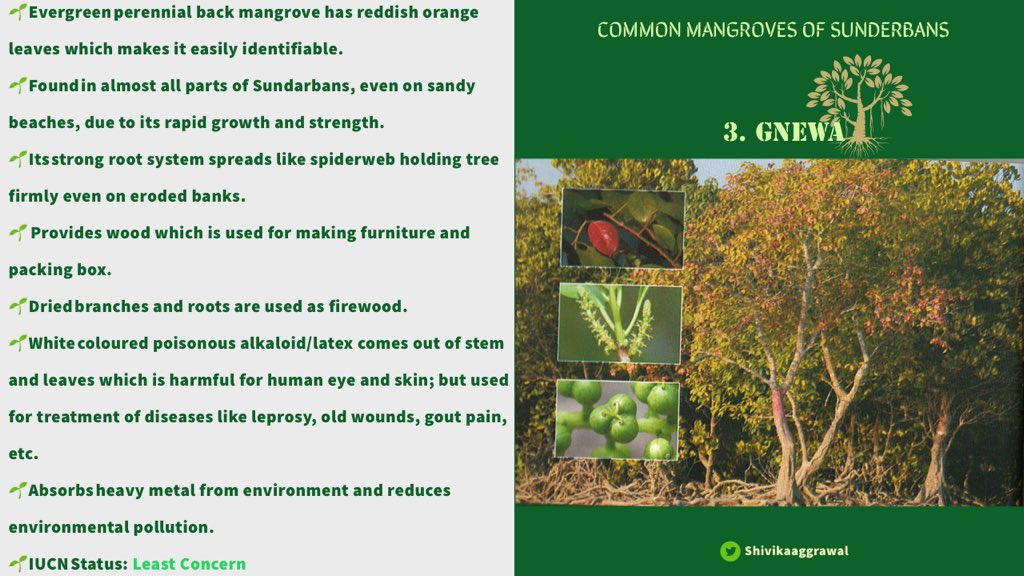 𝐆𝐍𝐄𝐖𝐀https://abs.twimg.com/emoji/v2/... draggable="false" alt="🍃" title="Im Wind flatterndes Blatt" aria-label="Emoji: Im Wind flatterndes Blatt">https://abs.twimg.com/emoji/v2/... draggable="false" alt="🌳" title="Laubbaum" aria-label="Emoji: Laubbaum">A medium sized bushy tree with rough skinned main stem.https://abs.twimg.com/emoji/v2/... draggable="false" alt="🍂" title="Gefallenes Blatt" aria-label="Emoji: Gefallenes Blatt">Leaf turns reddish-orange in colour with maturity.https://abs.twimg.com/emoji/v2/... draggable="false" alt="👀" title="Augen" aria-label="Emoji: Augen">Stem exudes white colored alkaloid if punctured or if leaves are torn. This poisonous latex is harmful for both human eyes and skin." title="https://abs.twimg.com/emoji/v2/... draggable="false" alt="🍃" title="Im Wind flatterndes Blatt" aria-label="Emoji: Im Wind flatterndes Blatt">𝐆𝐍𝐄𝐖𝐀https://abs.twimg.com/emoji/v2/... draggable="false" alt="🍃" title="Im Wind flatterndes Blatt" aria-label="Emoji: Im Wind flatterndes Blatt">https://abs.twimg.com/emoji/v2/... draggable="false" alt="🌳" title="Laubbaum" aria-label="Emoji: Laubbaum">A medium sized bushy tree with rough skinned main stem.https://abs.twimg.com/emoji/v2/... draggable="false" alt="🍂" title="Gefallenes Blatt" aria-label="Emoji: Gefallenes Blatt">Leaf turns reddish-orange in colour with maturity.https://abs.twimg.com/emoji/v2/... draggable="false" alt="👀" title="Augen" aria-label="Emoji: Augen">Stem exudes white colored alkaloid if punctured or if leaves are torn. This poisonous latex is harmful for both human eyes and skin." class="img-responsive" style="max-width:100%;"/>
𝐆𝐍𝐄𝐖𝐀https://abs.twimg.com/emoji/v2/... draggable="false" alt="🍃" title="Im Wind flatterndes Blatt" aria-label="Emoji: Im Wind flatterndes Blatt">https://abs.twimg.com/emoji/v2/... draggable="false" alt="🌳" title="Laubbaum" aria-label="Emoji: Laubbaum">A medium sized bushy tree with rough skinned main stem.https://abs.twimg.com/emoji/v2/... draggable="false" alt="🍂" title="Gefallenes Blatt" aria-label="Emoji: Gefallenes Blatt">Leaf turns reddish-orange in colour with maturity.https://abs.twimg.com/emoji/v2/... draggable="false" alt="👀" title="Augen" aria-label="Emoji: Augen">Stem exudes white colored alkaloid if punctured or if leaves are torn. This poisonous latex is harmful for both human eyes and skin." title="https://abs.twimg.com/emoji/v2/... draggable="false" alt="🍃" title="Im Wind flatterndes Blatt" aria-label="Emoji: Im Wind flatterndes Blatt">𝐆𝐍𝐄𝐖𝐀https://abs.twimg.com/emoji/v2/... draggable="false" alt="🍃" title="Im Wind flatterndes Blatt" aria-label="Emoji: Im Wind flatterndes Blatt">https://abs.twimg.com/emoji/v2/... draggable="false" alt="🌳" title="Laubbaum" aria-label="Emoji: Laubbaum">A medium sized bushy tree with rough skinned main stem.https://abs.twimg.com/emoji/v2/... draggable="false" alt="🍂" title="Gefallenes Blatt" aria-label="Emoji: Gefallenes Blatt">Leaf turns reddish-orange in colour with maturity.https://abs.twimg.com/emoji/v2/... draggable="false" alt="👀" title="Augen" aria-label="Emoji: Augen">Stem exudes white colored alkaloid if punctured or if leaves are torn. This poisonous latex is harmful for both human eyes and skin." class="img-responsive" style="max-width:100%;"/>
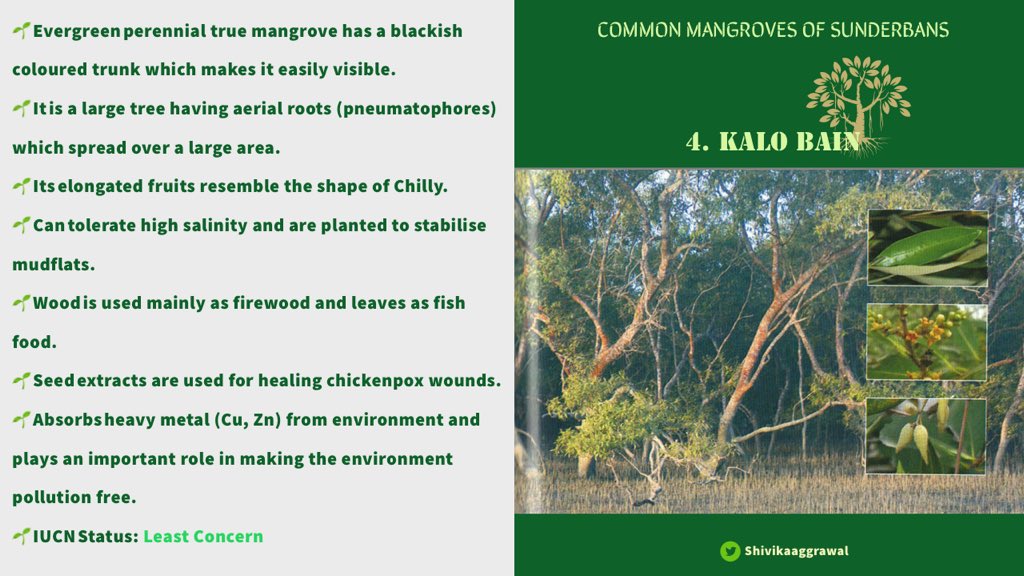 𝐊𝐀𝐋𝐎 𝐁𝐀𝐈𝐍https://abs.twimg.com/emoji/v2/... draggable="false" alt="🍃" title="Im Wind flatterndes Blatt" aria-label="Emoji: Im Wind flatterndes Blatt">https://abs.twimg.com/emoji/v2/... draggable="false" alt="♣️" title="Kreuz-Blatt" aria-label="Emoji: Kreuz-Blatt">As name suggests, it has a blackish coloured tree trunk.https://abs.twimg.com/emoji/v2/... draggable="false" alt="🌊" title="Wasserwelle" aria-label="Emoji: Wasserwelle">It is one of the very few dominant and salt-tolerant species, which acts as a natural bio-shield against rising salinity and sea levels.https://abs.twimg.com/emoji/v2/... draggable="false" alt="🌼" title="Blüte" aria-label="Emoji: Blüte">Flower is yellow in color with four petals." title="https://abs.twimg.com/emoji/v2/... draggable="false" alt="🍃" title="Im Wind flatterndes Blatt" aria-label="Emoji: Im Wind flatterndes Blatt">𝐊𝐀𝐋𝐎 𝐁𝐀𝐈𝐍https://abs.twimg.com/emoji/v2/... draggable="false" alt="🍃" title="Im Wind flatterndes Blatt" aria-label="Emoji: Im Wind flatterndes Blatt">https://abs.twimg.com/emoji/v2/... draggable="false" alt="♣️" title="Kreuz-Blatt" aria-label="Emoji: Kreuz-Blatt">As name suggests, it has a blackish coloured tree trunk.https://abs.twimg.com/emoji/v2/... draggable="false" alt="🌊" title="Wasserwelle" aria-label="Emoji: Wasserwelle">It is one of the very few dominant and salt-tolerant species, which acts as a natural bio-shield against rising salinity and sea levels.https://abs.twimg.com/emoji/v2/... draggable="false" alt="🌼" title="Blüte" aria-label="Emoji: Blüte">Flower is yellow in color with four petals." class="img-responsive" style="max-width:100%;"/>
𝐊𝐀𝐋𝐎 𝐁𝐀𝐈𝐍https://abs.twimg.com/emoji/v2/... draggable="false" alt="🍃" title="Im Wind flatterndes Blatt" aria-label="Emoji: Im Wind flatterndes Blatt">https://abs.twimg.com/emoji/v2/... draggable="false" alt="♣️" title="Kreuz-Blatt" aria-label="Emoji: Kreuz-Blatt">As name suggests, it has a blackish coloured tree trunk.https://abs.twimg.com/emoji/v2/... draggable="false" alt="🌊" title="Wasserwelle" aria-label="Emoji: Wasserwelle">It is one of the very few dominant and salt-tolerant species, which acts as a natural bio-shield against rising salinity and sea levels.https://abs.twimg.com/emoji/v2/... draggable="false" alt="🌼" title="Blüte" aria-label="Emoji: Blüte">Flower is yellow in color with four petals." title="https://abs.twimg.com/emoji/v2/... draggable="false" alt="🍃" title="Im Wind flatterndes Blatt" aria-label="Emoji: Im Wind flatterndes Blatt">𝐊𝐀𝐋𝐎 𝐁𝐀𝐈𝐍https://abs.twimg.com/emoji/v2/... draggable="false" alt="🍃" title="Im Wind flatterndes Blatt" aria-label="Emoji: Im Wind flatterndes Blatt">https://abs.twimg.com/emoji/v2/... draggable="false" alt="♣️" title="Kreuz-Blatt" aria-label="Emoji: Kreuz-Blatt">As name suggests, it has a blackish coloured tree trunk.https://abs.twimg.com/emoji/v2/... draggable="false" alt="🌊" title="Wasserwelle" aria-label="Emoji: Wasserwelle">It is one of the very few dominant and salt-tolerant species, which acts as a natural bio-shield against rising salinity and sea levels.https://abs.twimg.com/emoji/v2/... draggable="false" alt="🌼" title="Blüte" aria-label="Emoji: Blüte">Flower is yellow in color with four petals." class="img-responsive" style="max-width:100%;"/>
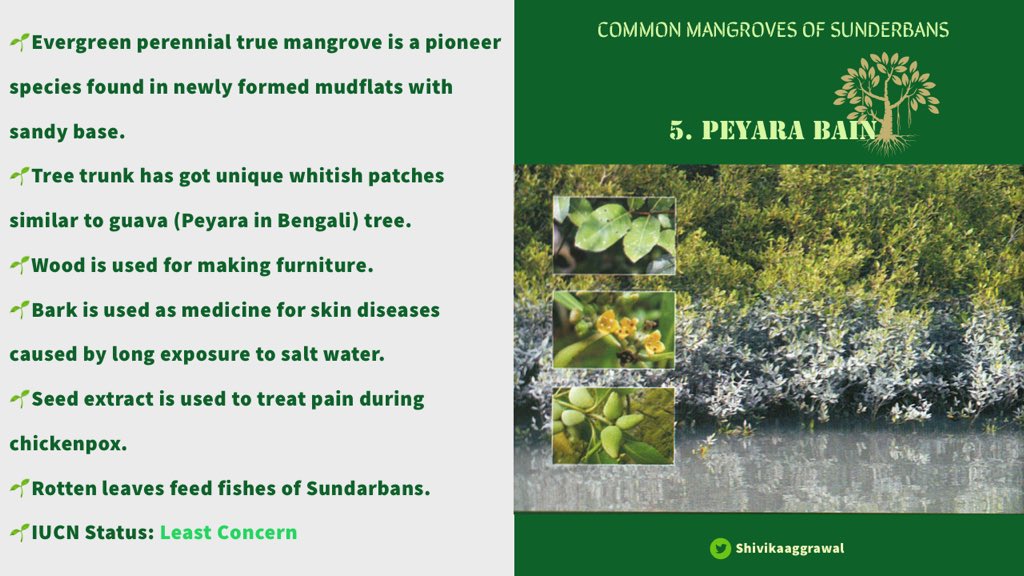 𝐏𝐄𝐘𝐀𝐑𝐀 𝐁𝐀𝐈𝐍https://abs.twimg.com/emoji/v2/... draggable="false" alt="🍃" title="Im Wind flatterndes Blatt" aria-label="Emoji: Im Wind flatterndes Blatt">https://abs.twimg.com/emoji/v2/... draggable="false" alt="🌳" title="Laubbaum" aria-label="Emoji: Laubbaum">It’s name is apt as its trunk has got unique whitish patches similar to that of guava (peyara in Bengali) tree.https://abs.twimg.com/emoji/v2/... draggable="false" alt="🍀" title="Vierblättriges Kleeblatt" aria-label="Emoji: Vierblättriges Kleeblatt">Leaf is the broadest among its family species (Avicennia) found in Sunderbans. https://abs.twimg.com/emoji/v2/... draggable="false" alt="🌻" title="Sonnenblume" aria-label="Emoji: Sonnenblume">Petals have outer white side and yellow inner side." title="https://abs.twimg.com/emoji/v2/... draggable="false" alt="🍃" title="Im Wind flatterndes Blatt" aria-label="Emoji: Im Wind flatterndes Blatt">𝐏𝐄𝐘𝐀𝐑𝐀 𝐁𝐀𝐈𝐍https://abs.twimg.com/emoji/v2/... draggable="false" alt="🍃" title="Im Wind flatterndes Blatt" aria-label="Emoji: Im Wind flatterndes Blatt">https://abs.twimg.com/emoji/v2/... draggable="false" alt="🌳" title="Laubbaum" aria-label="Emoji: Laubbaum">It’s name is apt as its trunk has got unique whitish patches similar to that of guava (peyara in Bengali) tree.https://abs.twimg.com/emoji/v2/... draggable="false" alt="🍀" title="Vierblättriges Kleeblatt" aria-label="Emoji: Vierblättriges Kleeblatt">Leaf is the broadest among its family species (Avicennia) found in Sunderbans. https://abs.twimg.com/emoji/v2/... draggable="false" alt="🌻" title="Sonnenblume" aria-label="Emoji: Sonnenblume">Petals have outer white side and yellow inner side." class="img-responsive" style="max-width:100%;"/>
𝐏𝐄𝐘𝐀𝐑𝐀 𝐁𝐀𝐈𝐍https://abs.twimg.com/emoji/v2/... draggable="false" alt="🍃" title="Im Wind flatterndes Blatt" aria-label="Emoji: Im Wind flatterndes Blatt">https://abs.twimg.com/emoji/v2/... draggable="false" alt="🌳" title="Laubbaum" aria-label="Emoji: Laubbaum">It’s name is apt as its trunk has got unique whitish patches similar to that of guava (peyara in Bengali) tree.https://abs.twimg.com/emoji/v2/... draggable="false" alt="🍀" title="Vierblättriges Kleeblatt" aria-label="Emoji: Vierblättriges Kleeblatt">Leaf is the broadest among its family species (Avicennia) found in Sunderbans. https://abs.twimg.com/emoji/v2/... draggable="false" alt="🌻" title="Sonnenblume" aria-label="Emoji: Sonnenblume">Petals have outer white side and yellow inner side." title="https://abs.twimg.com/emoji/v2/... draggable="false" alt="🍃" title="Im Wind flatterndes Blatt" aria-label="Emoji: Im Wind flatterndes Blatt">𝐏𝐄𝐘𝐀𝐑𝐀 𝐁𝐀𝐈𝐍https://abs.twimg.com/emoji/v2/... draggable="false" alt="🍃" title="Im Wind flatterndes Blatt" aria-label="Emoji: Im Wind flatterndes Blatt">https://abs.twimg.com/emoji/v2/... draggable="false" alt="🌳" title="Laubbaum" aria-label="Emoji: Laubbaum">It’s name is apt as its trunk has got unique whitish patches similar to that of guava (peyara in Bengali) tree.https://abs.twimg.com/emoji/v2/... draggable="false" alt="🍀" title="Vierblättriges Kleeblatt" aria-label="Emoji: Vierblättriges Kleeblatt">Leaf is the broadest among its family species (Avicennia) found in Sunderbans. https://abs.twimg.com/emoji/v2/... draggable="false" alt="🌻" title="Sonnenblume" aria-label="Emoji: Sonnenblume">Petals have outer white side and yellow inner side." class="img-responsive" style="max-width:100%;"/>
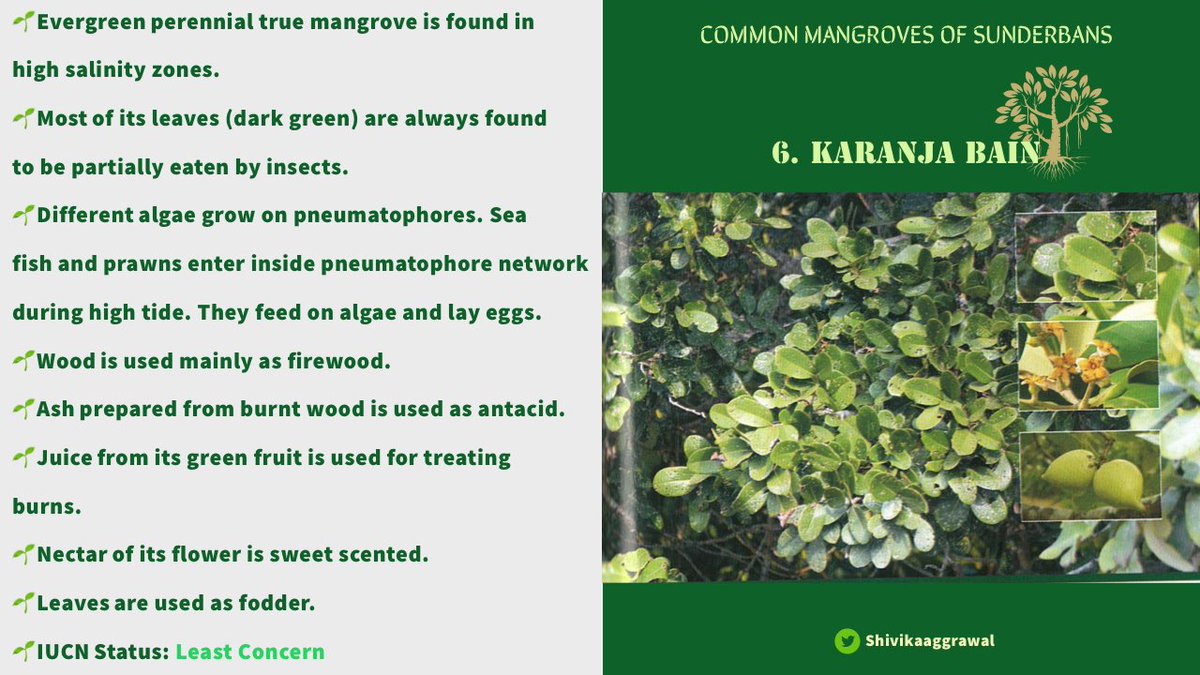 𝐊𝐀𝐑𝐀𝐍𝐉𝐀 𝐁𝐀𝐈𝐍https://abs.twimg.com/emoji/v2/... draggable="false" alt="🍃" title="Im Wind flatterndes Blatt" aria-label="Emoji: Im Wind flatterndes Blatt">https://abs.twimg.com/emoji/v2/... draggable="false" alt="📚" title="Bücher" aria-label="Emoji: Bücher">Word “Karanja” is found in ancient Buddhist & Hindu texts, where it is name of a tree used in medicinal preparations.https://abs.twimg.com/emoji/v2/... draggable="false" alt="🌿" title="Kräuter" aria-label="Emoji: Kräuter">Similarly, everything of Karanja Bain, from its bark to egg-shaped fruits have found extensive use in traditional medicine." title="https://abs.twimg.com/emoji/v2/... draggable="false" alt="🍃" title="Im Wind flatterndes Blatt" aria-label="Emoji: Im Wind flatterndes Blatt">𝐊𝐀𝐑𝐀𝐍𝐉𝐀 𝐁𝐀𝐈𝐍https://abs.twimg.com/emoji/v2/... draggable="false" alt="🍃" title="Im Wind flatterndes Blatt" aria-label="Emoji: Im Wind flatterndes Blatt">https://abs.twimg.com/emoji/v2/... draggable="false" alt="📚" title="Bücher" aria-label="Emoji: Bücher">Word “Karanja” is found in ancient Buddhist & Hindu texts, where it is name of a tree used in medicinal preparations.https://abs.twimg.com/emoji/v2/... draggable="false" alt="🌿" title="Kräuter" aria-label="Emoji: Kräuter">Similarly, everything of Karanja Bain, from its bark to egg-shaped fruits have found extensive use in traditional medicine." class="img-responsive" style="max-width:100%;"/>
𝐊𝐀𝐑𝐀𝐍𝐉𝐀 𝐁𝐀𝐈𝐍https://abs.twimg.com/emoji/v2/... draggable="false" alt="🍃" title="Im Wind flatterndes Blatt" aria-label="Emoji: Im Wind flatterndes Blatt">https://abs.twimg.com/emoji/v2/... draggable="false" alt="📚" title="Bücher" aria-label="Emoji: Bücher">Word “Karanja” is found in ancient Buddhist & Hindu texts, where it is name of a tree used in medicinal preparations.https://abs.twimg.com/emoji/v2/... draggable="false" alt="🌿" title="Kräuter" aria-label="Emoji: Kräuter">Similarly, everything of Karanja Bain, from its bark to egg-shaped fruits have found extensive use in traditional medicine." title="https://abs.twimg.com/emoji/v2/... draggable="false" alt="🍃" title="Im Wind flatterndes Blatt" aria-label="Emoji: Im Wind flatterndes Blatt">𝐊𝐀𝐑𝐀𝐍𝐉𝐀 𝐁𝐀𝐈𝐍https://abs.twimg.com/emoji/v2/... draggable="false" alt="🍃" title="Im Wind flatterndes Blatt" aria-label="Emoji: Im Wind flatterndes Blatt">https://abs.twimg.com/emoji/v2/... draggable="false" alt="📚" title="Bücher" aria-label="Emoji: Bücher">Word “Karanja” is found in ancient Buddhist & Hindu texts, where it is name of a tree used in medicinal preparations.https://abs.twimg.com/emoji/v2/... draggable="false" alt="🌿" title="Kräuter" aria-label="Emoji: Kräuter">Similarly, everything of Karanja Bain, from its bark to egg-shaped fruits have found extensive use in traditional medicine." class="img-responsive" style="max-width:100%;"/>
 𝐓𝐎𝐊 𝐊𝐄𝐎𝐑𝐀https://abs.twimg.com/emoji/v2/... draggable="false" alt="🍃" title="Im Wind flatterndes Blatt" aria-label="Emoji: Im Wind flatterndes Blatt">https://abs.twimg.com/emoji/v2/... draggable="false" alt="🍋" title="Zitrone" aria-label="Emoji: Zitrone">Tok in Bengali means “sour”. Since fruits of Tok Keora are rich in Vitamin C, hence it is named this.https://abs.twimg.com/emoji/v2/... draggable="false" alt="🌿" title="Kräuter" aria-label="Emoji: Kräuter">Thick leaves hang downwards and have same color both sides (upper, under).https://abs.twimg.com/emoji/v2/... draggable="false" alt="✨" title="Funken" aria-label="Emoji: Funken">Calyx of flower is star shaped, hard, green, and four in number." title="https://abs.twimg.com/emoji/v2/... draggable="false" alt="🍃" title="Im Wind flatterndes Blatt" aria-label="Emoji: Im Wind flatterndes Blatt">𝐓𝐎𝐊 𝐊𝐄𝐎𝐑𝐀https://abs.twimg.com/emoji/v2/... draggable="false" alt="🍃" title="Im Wind flatterndes Blatt" aria-label="Emoji: Im Wind flatterndes Blatt">https://abs.twimg.com/emoji/v2/... draggable="false" alt="🍋" title="Zitrone" aria-label="Emoji: Zitrone">Tok in Bengali means “sour”. Since fruits of Tok Keora are rich in Vitamin C, hence it is named this.https://abs.twimg.com/emoji/v2/... draggable="false" alt="🌿" title="Kräuter" aria-label="Emoji: Kräuter">Thick leaves hang downwards and have same color both sides (upper, under).https://abs.twimg.com/emoji/v2/... draggable="false" alt="✨" title="Funken" aria-label="Emoji: Funken">Calyx of flower is star shaped, hard, green, and four in number." class="img-responsive" style="max-width:100%;"/>
𝐓𝐎𝐊 𝐊𝐄𝐎𝐑𝐀https://abs.twimg.com/emoji/v2/... draggable="false" alt="🍃" title="Im Wind flatterndes Blatt" aria-label="Emoji: Im Wind flatterndes Blatt">https://abs.twimg.com/emoji/v2/... draggable="false" alt="🍋" title="Zitrone" aria-label="Emoji: Zitrone">Tok in Bengali means “sour”. Since fruits of Tok Keora are rich in Vitamin C, hence it is named this.https://abs.twimg.com/emoji/v2/... draggable="false" alt="🌿" title="Kräuter" aria-label="Emoji: Kräuter">Thick leaves hang downwards and have same color both sides (upper, under).https://abs.twimg.com/emoji/v2/... draggable="false" alt="✨" title="Funken" aria-label="Emoji: Funken">Calyx of flower is star shaped, hard, green, and four in number." title="https://abs.twimg.com/emoji/v2/... draggable="false" alt="🍃" title="Im Wind flatterndes Blatt" aria-label="Emoji: Im Wind flatterndes Blatt">𝐓𝐎𝐊 𝐊𝐄𝐎𝐑𝐀https://abs.twimg.com/emoji/v2/... draggable="false" alt="🍃" title="Im Wind flatterndes Blatt" aria-label="Emoji: Im Wind flatterndes Blatt">https://abs.twimg.com/emoji/v2/... draggable="false" alt="🍋" title="Zitrone" aria-label="Emoji: Zitrone">Tok in Bengali means “sour”. Since fruits of Tok Keora are rich in Vitamin C, hence it is named this.https://abs.twimg.com/emoji/v2/... draggable="false" alt="🌿" title="Kräuter" aria-label="Emoji: Kräuter">Thick leaves hang downwards and have same color both sides (upper, under).https://abs.twimg.com/emoji/v2/... draggable="false" alt="✨" title="Funken" aria-label="Emoji: Funken">Calyx of flower is star shaped, hard, green, and four in number." class="img-responsive" style="max-width:100%;"/>
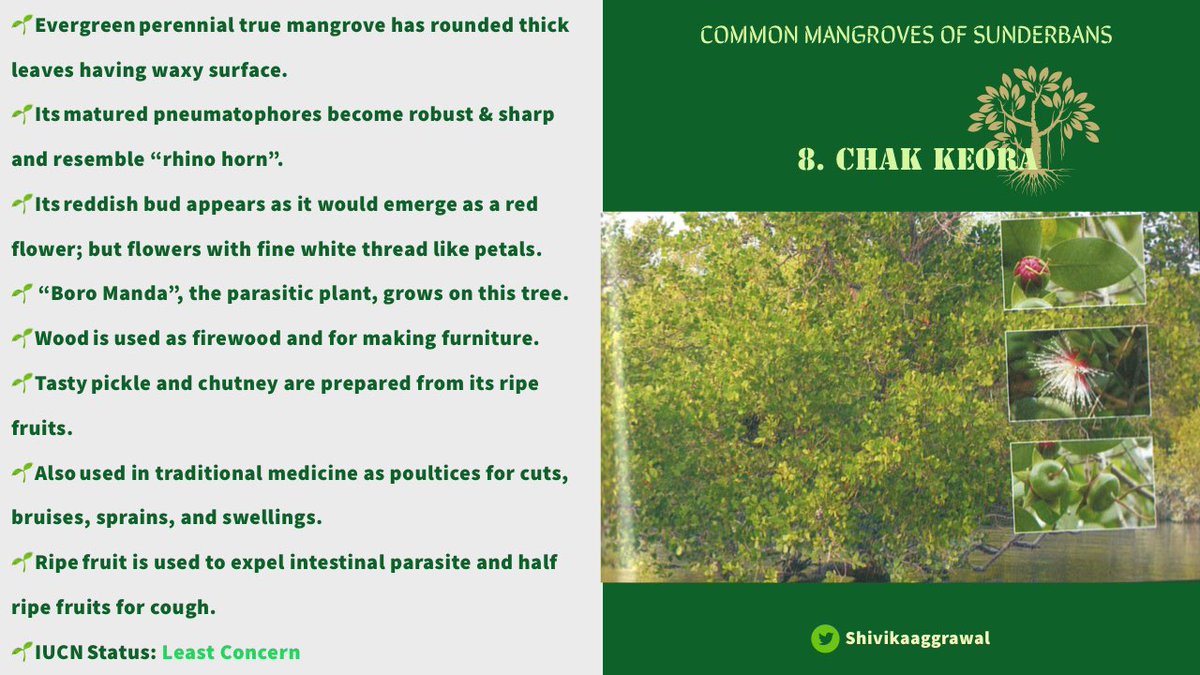 𝐂𝐇𝐀𝐊 𝐊𝐄𝐎𝐑𝐀https://abs.twimg.com/emoji/v2/... draggable="false" alt="🍃" title="Im Wind flatterndes Blatt" aria-label="Emoji: Im Wind flatterndes Blatt">https://abs.twimg.com/emoji/v2/... draggable="false" alt="🥌" title="Rollender Stein" aria-label="Emoji: Rollender Stein">Chak in Bengali means “wheel”. Its edible fruit looks like wheel from top which is roundish in shape while being tapered in the middle.https://abs.twimg.com/emoji/v2/... draggable="false" alt="🥘" title="Flache Pfanne mit Essen" aria-label="Emoji: Flache Pfanne mit Essen">Fruit is cooked and used as condiment to flavor curries.https://abs.twimg.com/emoji/v2/... draggable="false" alt="🩸" title="Tropfen Blut" aria-label="Emoji: Tropfen Blut">Fermented fruit juice relieves bleeding/haemorrhage." title="https://abs.twimg.com/emoji/v2/... draggable="false" alt="🍃" title="Im Wind flatterndes Blatt" aria-label="Emoji: Im Wind flatterndes Blatt">𝐂𝐇𝐀𝐊 𝐊𝐄𝐎𝐑𝐀https://abs.twimg.com/emoji/v2/... draggable="false" alt="🍃" title="Im Wind flatterndes Blatt" aria-label="Emoji: Im Wind flatterndes Blatt">https://abs.twimg.com/emoji/v2/... draggable="false" alt="🥌" title="Rollender Stein" aria-label="Emoji: Rollender Stein">Chak in Bengali means “wheel”. Its edible fruit looks like wheel from top which is roundish in shape while being tapered in the middle.https://abs.twimg.com/emoji/v2/... draggable="false" alt="🥘" title="Flache Pfanne mit Essen" aria-label="Emoji: Flache Pfanne mit Essen">Fruit is cooked and used as condiment to flavor curries.https://abs.twimg.com/emoji/v2/... draggable="false" alt="🩸" title="Tropfen Blut" aria-label="Emoji: Tropfen Blut">Fermented fruit juice relieves bleeding/haemorrhage." class="img-responsive" style="max-width:100%;"/>
𝐂𝐇𝐀𝐊 𝐊𝐄𝐎𝐑𝐀https://abs.twimg.com/emoji/v2/... draggable="false" alt="🍃" title="Im Wind flatterndes Blatt" aria-label="Emoji: Im Wind flatterndes Blatt">https://abs.twimg.com/emoji/v2/... draggable="false" alt="🥌" title="Rollender Stein" aria-label="Emoji: Rollender Stein">Chak in Bengali means “wheel”. Its edible fruit looks like wheel from top which is roundish in shape while being tapered in the middle.https://abs.twimg.com/emoji/v2/... draggable="false" alt="🥘" title="Flache Pfanne mit Essen" aria-label="Emoji: Flache Pfanne mit Essen">Fruit is cooked and used as condiment to flavor curries.https://abs.twimg.com/emoji/v2/... draggable="false" alt="🩸" title="Tropfen Blut" aria-label="Emoji: Tropfen Blut">Fermented fruit juice relieves bleeding/haemorrhage." title="https://abs.twimg.com/emoji/v2/... draggable="false" alt="🍃" title="Im Wind flatterndes Blatt" aria-label="Emoji: Im Wind flatterndes Blatt">𝐂𝐇𝐀𝐊 𝐊𝐄𝐎𝐑𝐀https://abs.twimg.com/emoji/v2/... draggable="false" alt="🍃" title="Im Wind flatterndes Blatt" aria-label="Emoji: Im Wind flatterndes Blatt">https://abs.twimg.com/emoji/v2/... draggable="false" alt="🥌" title="Rollender Stein" aria-label="Emoji: Rollender Stein">Chak in Bengali means “wheel”. Its edible fruit looks like wheel from top which is roundish in shape while being tapered in the middle.https://abs.twimg.com/emoji/v2/... draggable="false" alt="🥘" title="Flache Pfanne mit Essen" aria-label="Emoji: Flache Pfanne mit Essen">Fruit is cooked and used as condiment to flavor curries.https://abs.twimg.com/emoji/v2/... draggable="false" alt="🩸" title="Tropfen Blut" aria-label="Emoji: Tropfen Blut">Fermented fruit juice relieves bleeding/haemorrhage." class="img-responsive" style="max-width:100%;"/>
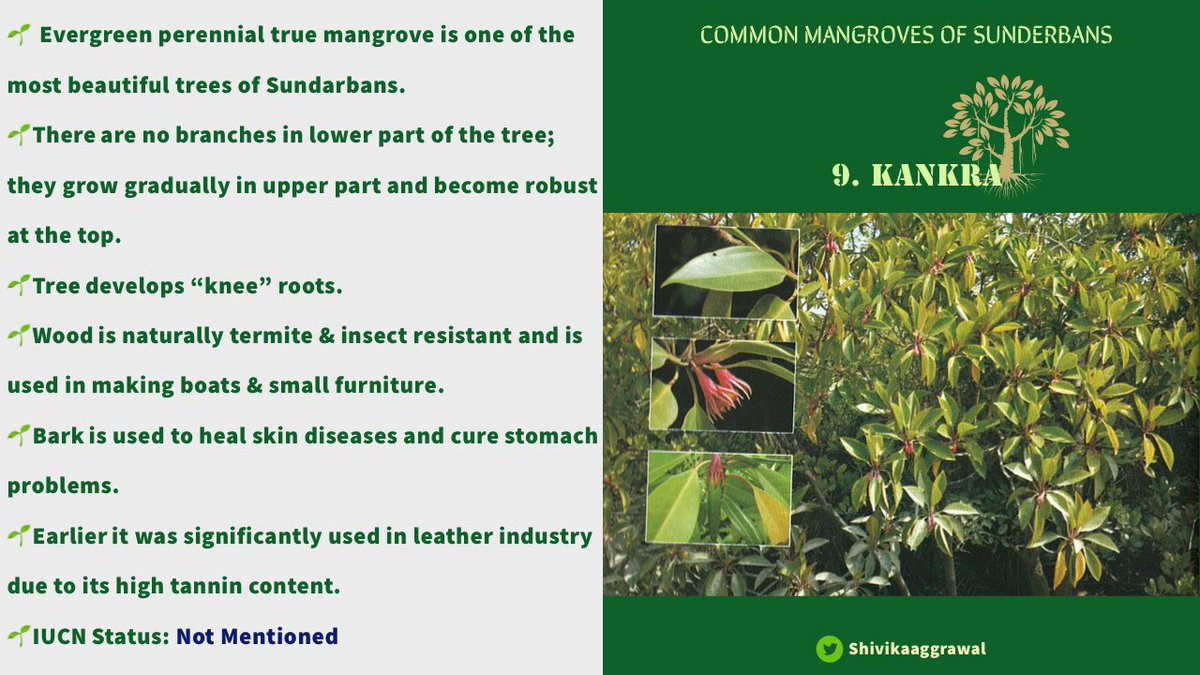 𝐊𝐀𝐍𝐊𝐑𝐀https://abs.twimg.com/emoji/v2/... draggable="false" alt="🍃" title="Im Wind flatterndes Blatt" aria-label="Emoji: Im Wind flatterndes Blatt">https://abs.twimg.com/emoji/v2/... draggable="false" alt="🦀" title="Krabbe" aria-label="Emoji: Krabbe"> Kankra in Bengali means “crab”. Red bell-shaped calyx of flower is divided into number of strips which resemble to the legs of crab. https://abs.twimg.com/emoji/v2/... draggable="false" alt="🌺" title="Hibiskus" aria-label="Emoji: Hibiskus">Small orange petals of flower almost remain invisible as they remain within the calyx.https://abs.twimg.com/emoji/v2/... draggable="false" alt="🌳" title="Laubbaum" aria-label="Emoji: Laubbaum">Robust in nature, adapts well." title="https://abs.twimg.com/emoji/v2/... draggable="false" alt="🍃" title="Im Wind flatterndes Blatt" aria-label="Emoji: Im Wind flatterndes Blatt">𝐊𝐀𝐍𝐊𝐑𝐀https://abs.twimg.com/emoji/v2/... draggable="false" alt="🍃" title="Im Wind flatterndes Blatt" aria-label="Emoji: Im Wind flatterndes Blatt">https://abs.twimg.com/emoji/v2/... draggable="false" alt="🦀" title="Krabbe" aria-label="Emoji: Krabbe"> Kankra in Bengali means “crab”. Red bell-shaped calyx of flower is divided into number of strips which resemble to the legs of crab. https://abs.twimg.com/emoji/v2/... draggable="false" alt="🌺" title="Hibiskus" aria-label="Emoji: Hibiskus">Small orange petals of flower almost remain invisible as they remain within the calyx.https://abs.twimg.com/emoji/v2/... draggable="false" alt="🌳" title="Laubbaum" aria-label="Emoji: Laubbaum">Robust in nature, adapts well." class="img-responsive" style="max-width:100%;"/>
𝐊𝐀𝐍𝐊𝐑𝐀https://abs.twimg.com/emoji/v2/... draggable="false" alt="🍃" title="Im Wind flatterndes Blatt" aria-label="Emoji: Im Wind flatterndes Blatt">https://abs.twimg.com/emoji/v2/... draggable="false" alt="🦀" title="Krabbe" aria-label="Emoji: Krabbe"> Kankra in Bengali means “crab”. Red bell-shaped calyx of flower is divided into number of strips which resemble to the legs of crab. https://abs.twimg.com/emoji/v2/... draggable="false" alt="🌺" title="Hibiskus" aria-label="Emoji: Hibiskus">Small orange petals of flower almost remain invisible as they remain within the calyx.https://abs.twimg.com/emoji/v2/... draggable="false" alt="🌳" title="Laubbaum" aria-label="Emoji: Laubbaum">Robust in nature, adapts well." title="https://abs.twimg.com/emoji/v2/... draggable="false" alt="🍃" title="Im Wind flatterndes Blatt" aria-label="Emoji: Im Wind flatterndes Blatt">𝐊𝐀𝐍𝐊𝐑𝐀https://abs.twimg.com/emoji/v2/... draggable="false" alt="🍃" title="Im Wind flatterndes Blatt" aria-label="Emoji: Im Wind flatterndes Blatt">https://abs.twimg.com/emoji/v2/... draggable="false" alt="🦀" title="Krabbe" aria-label="Emoji: Krabbe"> Kankra in Bengali means “crab”. Red bell-shaped calyx of flower is divided into number of strips which resemble to the legs of crab. https://abs.twimg.com/emoji/v2/... draggable="false" alt="🌺" title="Hibiskus" aria-label="Emoji: Hibiskus">Small orange petals of flower almost remain invisible as they remain within the calyx.https://abs.twimg.com/emoji/v2/... draggable="false" alt="🌳" title="Laubbaum" aria-label="Emoji: Laubbaum">Robust in nature, adapts well." class="img-responsive" style="max-width:100%;"/>
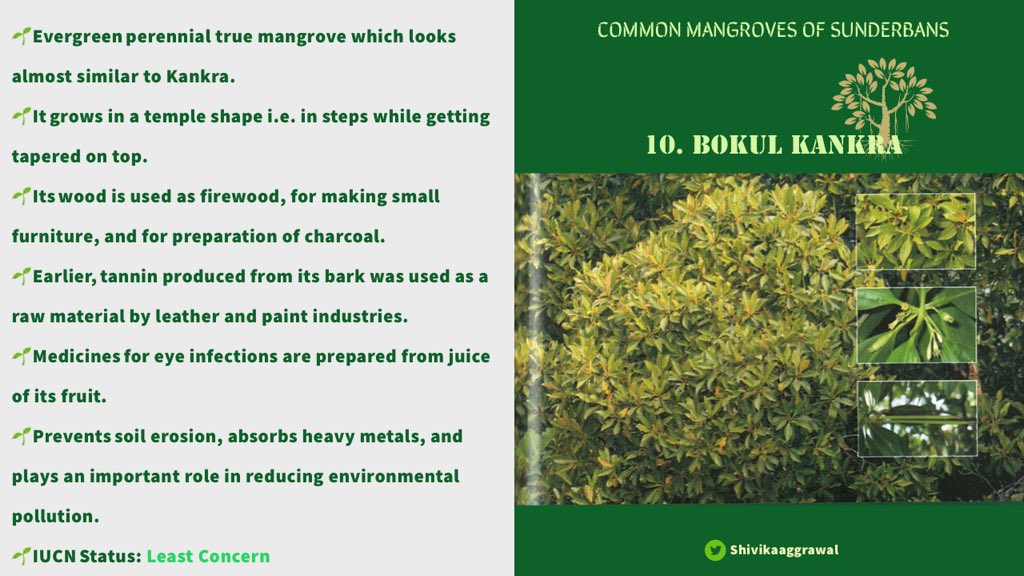 𝐁𝐎𝐊𝐔𝐋 𝐊𝐀𝐍𝐊𝐑𝐀https://abs.twimg.com/emoji/v2/... draggable="false" alt="🍃" title="Im Wind flatterndes Blatt" aria-label="Emoji: Im Wind flatterndes Blatt">https://abs.twimg.com/emoji/v2/... draggable="false" alt="🥀" title="Verwelkte Blume" aria-label="Emoji: Verwelkte Blume"> Bokul in Bengali means “bud”. Though similar in shape to that of Kankra, its flowers are very small in size. Even when full grown, appears like a bud.https://abs.twimg.com/emoji/v2/... draggable="false" alt="🌼" title="Blüte" aria-label="Emoji: Blüte">Calyx is yellowish green and petals are butter yellow in color." title="https://abs.twimg.com/emoji/v2/... draggable="false" alt="🍃" title="Im Wind flatterndes Blatt" aria-label="Emoji: Im Wind flatterndes Blatt">𝐁𝐎𝐊𝐔𝐋 𝐊𝐀𝐍𝐊𝐑𝐀https://abs.twimg.com/emoji/v2/... draggable="false" alt="🍃" title="Im Wind flatterndes Blatt" aria-label="Emoji: Im Wind flatterndes Blatt">https://abs.twimg.com/emoji/v2/... draggable="false" alt="🥀" title="Verwelkte Blume" aria-label="Emoji: Verwelkte Blume"> Bokul in Bengali means “bud”. Though similar in shape to that of Kankra, its flowers are very small in size. Even when full grown, appears like a bud.https://abs.twimg.com/emoji/v2/... draggable="false" alt="🌼" title="Blüte" aria-label="Emoji: Blüte">Calyx is yellowish green and petals are butter yellow in color." class="img-responsive" style="max-width:100%;"/>
𝐁𝐎𝐊𝐔𝐋 𝐊𝐀𝐍𝐊𝐑𝐀https://abs.twimg.com/emoji/v2/... draggable="false" alt="🍃" title="Im Wind flatterndes Blatt" aria-label="Emoji: Im Wind flatterndes Blatt">https://abs.twimg.com/emoji/v2/... draggable="false" alt="🥀" title="Verwelkte Blume" aria-label="Emoji: Verwelkte Blume"> Bokul in Bengali means “bud”. Though similar in shape to that of Kankra, its flowers are very small in size. Even when full grown, appears like a bud.https://abs.twimg.com/emoji/v2/... draggable="false" alt="🌼" title="Blüte" aria-label="Emoji: Blüte">Calyx is yellowish green and petals are butter yellow in color." title="https://abs.twimg.com/emoji/v2/... draggable="false" alt="🍃" title="Im Wind flatterndes Blatt" aria-label="Emoji: Im Wind flatterndes Blatt">𝐁𝐎𝐊𝐔𝐋 𝐊𝐀𝐍𝐊𝐑𝐀https://abs.twimg.com/emoji/v2/... draggable="false" alt="🍃" title="Im Wind flatterndes Blatt" aria-label="Emoji: Im Wind flatterndes Blatt">https://abs.twimg.com/emoji/v2/... draggable="false" alt="🥀" title="Verwelkte Blume" aria-label="Emoji: Verwelkte Blume"> Bokul in Bengali means “bud”. Though similar in shape to that of Kankra, its flowers are very small in size. Even when full grown, appears like a bud.https://abs.twimg.com/emoji/v2/... draggable="false" alt="🌼" title="Blüte" aria-label="Emoji: Blüte">Calyx is yellowish green and petals are butter yellow in color." class="img-responsive" style="max-width:100%;"/>
 𝐌𝐀𝐓𝐇 𝐆𝐎𝐑𝐀𝐍https://abs.twimg.com/emoji/v2/... draggable="false" alt="🍃" title="Im Wind flatterndes Blatt" aria-label="Emoji: Im Wind flatterndes Blatt">https://abs.twimg.com/emoji/v2/... draggable="false" alt="🛕" title="Hindutempel" aria-label="Emoji: Hindutempel">Math,in Bengal, is place of worship. It is also known for their unique Bengal roof architecture.These mangroves resemble Math in shape.https://abs.twimg.com/emoji/v2/... draggable="false" alt="🎋" title="Tanabata Baum" aria-label="Emoji: Tanabata Baum">It develops profusely branched root system. https://abs.twimg.com/emoji/v2/... draggable="false" alt="🌳" title="Laubbaum" aria-label="Emoji: Laubbaum">Main stem flattens near the ground which appears like buttresses." title="https://abs.twimg.com/emoji/v2/... draggable="false" alt="🍃" title="Im Wind flatterndes Blatt" aria-label="Emoji: Im Wind flatterndes Blatt">𝐌𝐀𝐓𝐇 𝐆𝐎𝐑𝐀𝐍https://abs.twimg.com/emoji/v2/... draggable="false" alt="🍃" title="Im Wind flatterndes Blatt" aria-label="Emoji: Im Wind flatterndes Blatt">https://abs.twimg.com/emoji/v2/... draggable="false" alt="🛕" title="Hindutempel" aria-label="Emoji: Hindutempel">Math,in Bengal, is place of worship. It is also known for their unique Bengal roof architecture.These mangroves resemble Math in shape.https://abs.twimg.com/emoji/v2/... draggable="false" alt="🎋" title="Tanabata Baum" aria-label="Emoji: Tanabata Baum">It develops profusely branched root system. https://abs.twimg.com/emoji/v2/... draggable="false" alt="🌳" title="Laubbaum" aria-label="Emoji: Laubbaum">Main stem flattens near the ground which appears like buttresses." class="img-responsive" style="max-width:100%;"/>
𝐌𝐀𝐓𝐇 𝐆𝐎𝐑𝐀𝐍https://abs.twimg.com/emoji/v2/... draggable="false" alt="🍃" title="Im Wind flatterndes Blatt" aria-label="Emoji: Im Wind flatterndes Blatt">https://abs.twimg.com/emoji/v2/... draggable="false" alt="🛕" title="Hindutempel" aria-label="Emoji: Hindutempel">Math,in Bengal, is place of worship. It is also known for their unique Bengal roof architecture.These mangroves resemble Math in shape.https://abs.twimg.com/emoji/v2/... draggable="false" alt="🎋" title="Tanabata Baum" aria-label="Emoji: Tanabata Baum">It develops profusely branched root system. https://abs.twimg.com/emoji/v2/... draggable="false" alt="🌳" title="Laubbaum" aria-label="Emoji: Laubbaum">Main stem flattens near the ground which appears like buttresses." title="https://abs.twimg.com/emoji/v2/... draggable="false" alt="🍃" title="Im Wind flatterndes Blatt" aria-label="Emoji: Im Wind flatterndes Blatt">𝐌𝐀𝐓𝐇 𝐆𝐎𝐑𝐀𝐍https://abs.twimg.com/emoji/v2/... draggable="false" alt="🍃" title="Im Wind flatterndes Blatt" aria-label="Emoji: Im Wind flatterndes Blatt">https://abs.twimg.com/emoji/v2/... draggable="false" alt="🛕" title="Hindutempel" aria-label="Emoji: Hindutempel">Math,in Bengal, is place of worship. It is also known for their unique Bengal roof architecture.These mangroves resemble Math in shape.https://abs.twimg.com/emoji/v2/... draggable="false" alt="🎋" title="Tanabata Baum" aria-label="Emoji: Tanabata Baum">It develops profusely branched root system. https://abs.twimg.com/emoji/v2/... draggable="false" alt="🌳" title="Laubbaum" aria-label="Emoji: Laubbaum">Main stem flattens near the ground which appears like buttresses." class="img-responsive" style="max-width:100%;"/>
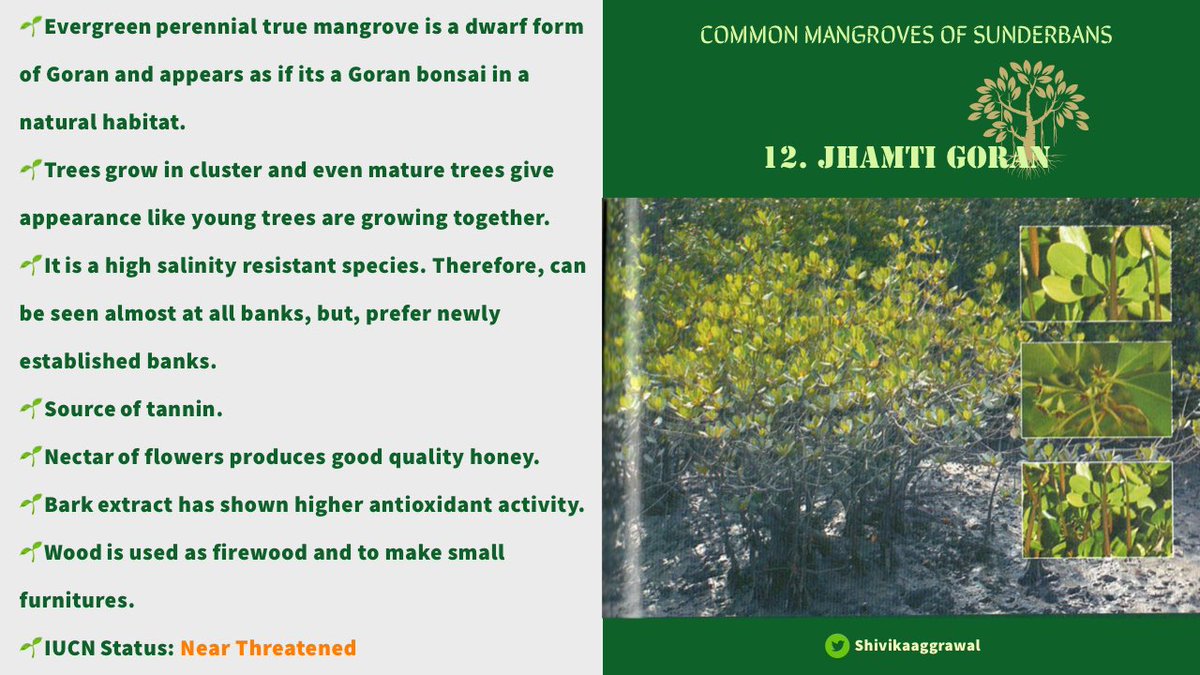 𝐉𝐇𝐀𝐌𝐓𝐈 𝐆𝐎𝐑𝐀𝐍https://abs.twimg.com/emoji/v2/... draggable="false" alt="🍃" title="Im Wind flatterndes Blatt" aria-label="Emoji: Im Wind flatterndes Blatt">https://abs.twimg.com/emoji/v2/... draggable="false" alt="🎍" title="Kiefer Dekoration" aria-label="Emoji: Kiefer Dekoration">Jhamti may have been derived from Hindi word jamat meaning “group”. They grow in cluster & give an appearance that young trees are growing together, though in reality they are matured.https://abs.twimg.com/emoji/v2/... draggable="false" alt="🌸" title="Kirschblüte" aria-label="Emoji: Kirschblüte">Fruits and flowers are pretty similar to that of Math Goran." title="https://abs.twimg.com/emoji/v2/... draggable="false" alt="🍃" title="Im Wind flatterndes Blatt" aria-label="Emoji: Im Wind flatterndes Blatt">𝐉𝐇𝐀𝐌𝐓𝐈 𝐆𝐎𝐑𝐀𝐍https://abs.twimg.com/emoji/v2/... draggable="false" alt="🍃" title="Im Wind flatterndes Blatt" aria-label="Emoji: Im Wind flatterndes Blatt">https://abs.twimg.com/emoji/v2/... draggable="false" alt="🎍" title="Kiefer Dekoration" aria-label="Emoji: Kiefer Dekoration">Jhamti may have been derived from Hindi word jamat meaning “group”. They grow in cluster & give an appearance that young trees are growing together, though in reality they are matured.https://abs.twimg.com/emoji/v2/... draggable="false" alt="🌸" title="Kirschblüte" aria-label="Emoji: Kirschblüte">Fruits and flowers are pretty similar to that of Math Goran." class="img-responsive" style="max-width:100%;"/>
𝐉𝐇𝐀𝐌𝐓𝐈 𝐆𝐎𝐑𝐀𝐍https://abs.twimg.com/emoji/v2/... draggable="false" alt="🍃" title="Im Wind flatterndes Blatt" aria-label="Emoji: Im Wind flatterndes Blatt">https://abs.twimg.com/emoji/v2/... draggable="false" alt="🎍" title="Kiefer Dekoration" aria-label="Emoji: Kiefer Dekoration">Jhamti may have been derived from Hindi word jamat meaning “group”. They grow in cluster & give an appearance that young trees are growing together, though in reality they are matured.https://abs.twimg.com/emoji/v2/... draggable="false" alt="🌸" title="Kirschblüte" aria-label="Emoji: Kirschblüte">Fruits and flowers are pretty similar to that of Math Goran." title="https://abs.twimg.com/emoji/v2/... draggable="false" alt="🍃" title="Im Wind flatterndes Blatt" aria-label="Emoji: Im Wind flatterndes Blatt">𝐉𝐇𝐀𝐌𝐓𝐈 𝐆𝐎𝐑𝐀𝐍https://abs.twimg.com/emoji/v2/... draggable="false" alt="🍃" title="Im Wind flatterndes Blatt" aria-label="Emoji: Im Wind flatterndes Blatt">https://abs.twimg.com/emoji/v2/... draggable="false" alt="🎍" title="Kiefer Dekoration" aria-label="Emoji: Kiefer Dekoration">Jhamti may have been derived from Hindi word jamat meaning “group”. They grow in cluster & give an appearance that young trees are growing together, though in reality they are matured.https://abs.twimg.com/emoji/v2/... draggable="false" alt="🌸" title="Kirschblüte" aria-label="Emoji: Kirschblüte">Fruits and flowers are pretty similar to that of Math Goran." class="img-responsive" style="max-width:100%;"/>
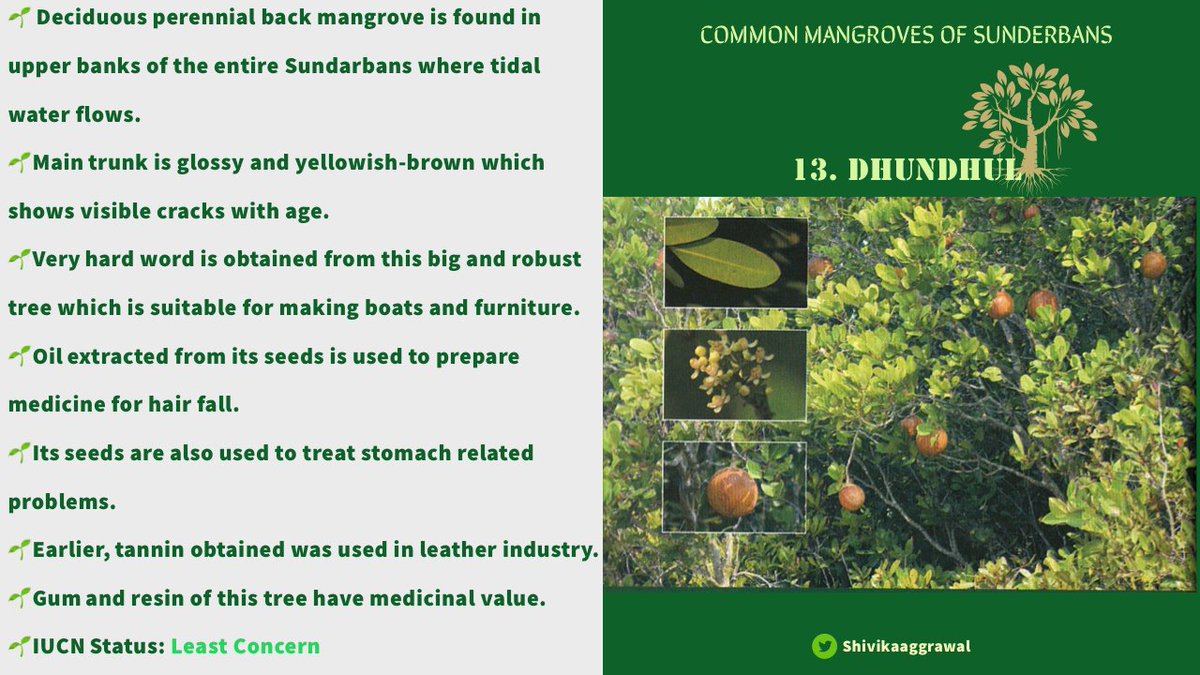 𝐃𝐇𝐔𝐍𝐃𝐇𝐔𝐋https://abs.twimg.com/emoji/v2/... draggable="false" alt="🍃" title="Im Wind flatterndes Blatt" aria-label="Emoji: Im Wind flatterndes Blatt">https://abs.twimg.com/emoji/v2/... draggable="false" alt="☄️" title="Komet" aria-label="Emoji: Komet">Dhundhul is also known as “cannon ball” tree as it bears big round shaped fruits which turns woody and reddish brown when matured.https://abs.twimg.com/emoji/v2/... draggable="false" alt="🪑" title="Stuhl" aria-label="Emoji: Stuhl"> It is known for its best quality timber used for making furniture, umbrella handle, flower vase, and carvings." title="https://abs.twimg.com/emoji/v2/... draggable="false" alt="🍃" title="Im Wind flatterndes Blatt" aria-label="Emoji: Im Wind flatterndes Blatt">𝐃𝐇𝐔𝐍𝐃𝐇𝐔𝐋https://abs.twimg.com/emoji/v2/... draggable="false" alt="🍃" title="Im Wind flatterndes Blatt" aria-label="Emoji: Im Wind flatterndes Blatt">https://abs.twimg.com/emoji/v2/... draggable="false" alt="☄️" title="Komet" aria-label="Emoji: Komet">Dhundhul is also known as “cannon ball” tree as it bears big round shaped fruits which turns woody and reddish brown when matured.https://abs.twimg.com/emoji/v2/... draggable="false" alt="🪑" title="Stuhl" aria-label="Emoji: Stuhl"> It is known for its best quality timber used for making furniture, umbrella handle, flower vase, and carvings." class="img-responsive" style="max-width:100%;"/>
𝐃𝐇𝐔𝐍𝐃𝐇𝐔𝐋https://abs.twimg.com/emoji/v2/... draggable="false" alt="🍃" title="Im Wind flatterndes Blatt" aria-label="Emoji: Im Wind flatterndes Blatt">https://abs.twimg.com/emoji/v2/... draggable="false" alt="☄️" title="Komet" aria-label="Emoji: Komet">Dhundhul is also known as “cannon ball” tree as it bears big round shaped fruits which turns woody and reddish brown when matured.https://abs.twimg.com/emoji/v2/... draggable="false" alt="🪑" title="Stuhl" aria-label="Emoji: Stuhl"> It is known for its best quality timber used for making furniture, umbrella handle, flower vase, and carvings." title="https://abs.twimg.com/emoji/v2/... draggable="false" alt="🍃" title="Im Wind flatterndes Blatt" aria-label="Emoji: Im Wind flatterndes Blatt">𝐃𝐇𝐔𝐍𝐃𝐇𝐔𝐋https://abs.twimg.com/emoji/v2/... draggable="false" alt="🍃" title="Im Wind flatterndes Blatt" aria-label="Emoji: Im Wind flatterndes Blatt">https://abs.twimg.com/emoji/v2/... draggable="false" alt="☄️" title="Komet" aria-label="Emoji: Komet">Dhundhul is also known as “cannon ball” tree as it bears big round shaped fruits which turns woody and reddish brown when matured.https://abs.twimg.com/emoji/v2/... draggable="false" alt="🪑" title="Stuhl" aria-label="Emoji: Stuhl"> It is known for its best quality timber used for making furniture, umbrella handle, flower vase, and carvings." class="img-responsive" style="max-width:100%;"/>
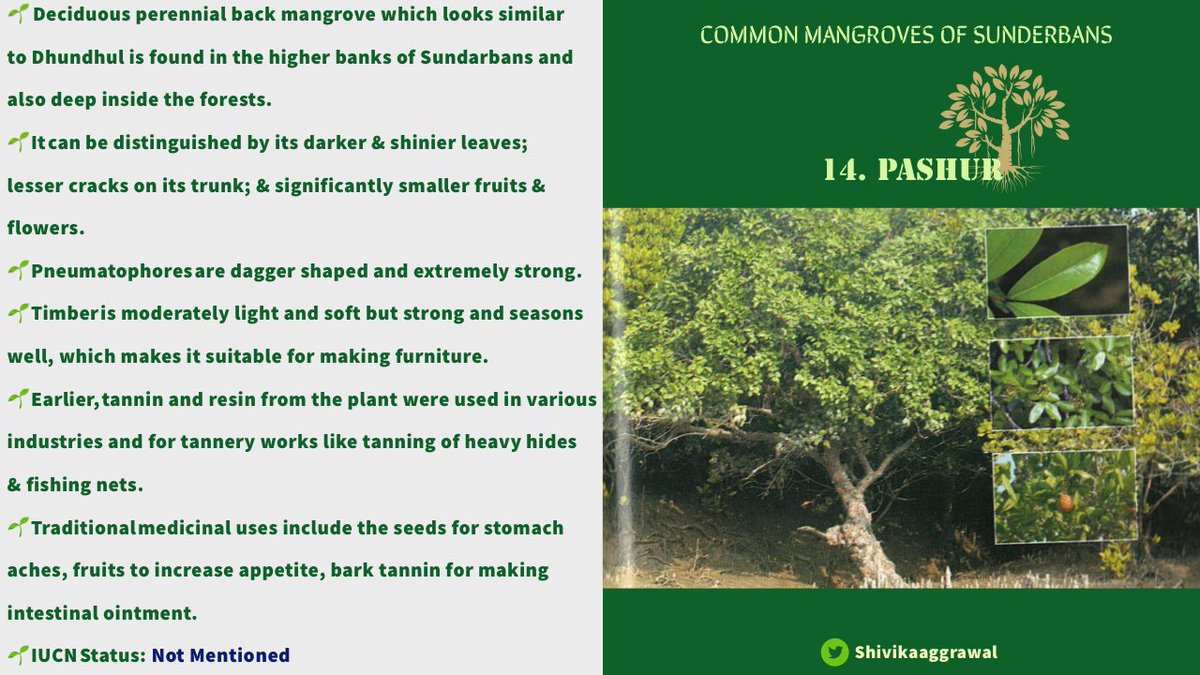 𝐏𝐀𝐒𝐇𝐔𝐑https://abs.twimg.com/emoji/v2/... draggable="false" alt="🍃" title="Im Wind flatterndes Blatt" aria-label="Emoji: Im Wind flatterndes Blatt">https://abs.twimg.com/emoji/v2/... draggable="false" alt="🦌" title="Hirsch" aria-label="Emoji: Hirsch">Pashur in Bengali translates to “animals”. Also, its a name of river in Sunderbans region of Bangladesh. So, the name of mangrove may have association with any of these.https://abs.twimg.com/emoji/v2/... draggable="false" alt="🍀" title="Vierblättriges Kleeblatt" aria-label="Emoji: Vierblättriges Kleeblatt">Looks similar to Dhundhul tree but can be distinguished by the color of leaf." title="https://abs.twimg.com/emoji/v2/... draggable="false" alt="🍃" title="Im Wind flatterndes Blatt" aria-label="Emoji: Im Wind flatterndes Blatt">𝐏𝐀𝐒𝐇𝐔𝐑https://abs.twimg.com/emoji/v2/... draggable="false" alt="🍃" title="Im Wind flatterndes Blatt" aria-label="Emoji: Im Wind flatterndes Blatt">https://abs.twimg.com/emoji/v2/... draggable="false" alt="🦌" title="Hirsch" aria-label="Emoji: Hirsch">Pashur in Bengali translates to “animals”. Also, its a name of river in Sunderbans region of Bangladesh. So, the name of mangrove may have association with any of these.https://abs.twimg.com/emoji/v2/... draggable="false" alt="🍀" title="Vierblättriges Kleeblatt" aria-label="Emoji: Vierblättriges Kleeblatt">Looks similar to Dhundhul tree but can be distinguished by the color of leaf." class="img-responsive" style="max-width:100%;"/>
𝐏𝐀𝐒𝐇𝐔𝐑https://abs.twimg.com/emoji/v2/... draggable="false" alt="🍃" title="Im Wind flatterndes Blatt" aria-label="Emoji: Im Wind flatterndes Blatt">https://abs.twimg.com/emoji/v2/... draggable="false" alt="🦌" title="Hirsch" aria-label="Emoji: Hirsch">Pashur in Bengali translates to “animals”. Also, its a name of river in Sunderbans region of Bangladesh. So, the name of mangrove may have association with any of these.https://abs.twimg.com/emoji/v2/... draggable="false" alt="🍀" title="Vierblättriges Kleeblatt" aria-label="Emoji: Vierblättriges Kleeblatt">Looks similar to Dhundhul tree but can be distinguished by the color of leaf." title="https://abs.twimg.com/emoji/v2/... draggable="false" alt="🍃" title="Im Wind flatterndes Blatt" aria-label="Emoji: Im Wind flatterndes Blatt">𝐏𝐀𝐒𝐇𝐔𝐑https://abs.twimg.com/emoji/v2/... draggable="false" alt="🍃" title="Im Wind flatterndes Blatt" aria-label="Emoji: Im Wind flatterndes Blatt">https://abs.twimg.com/emoji/v2/... draggable="false" alt="🦌" title="Hirsch" aria-label="Emoji: Hirsch">Pashur in Bengali translates to “animals”. Also, its a name of river in Sunderbans region of Bangladesh. So, the name of mangrove may have association with any of these.https://abs.twimg.com/emoji/v2/... draggable="false" alt="🍀" title="Vierblättriges Kleeblatt" aria-label="Emoji: Vierblättriges Kleeblatt">Looks similar to Dhundhul tree but can be distinguished by the color of leaf." class="img-responsive" style="max-width:100%;"/>
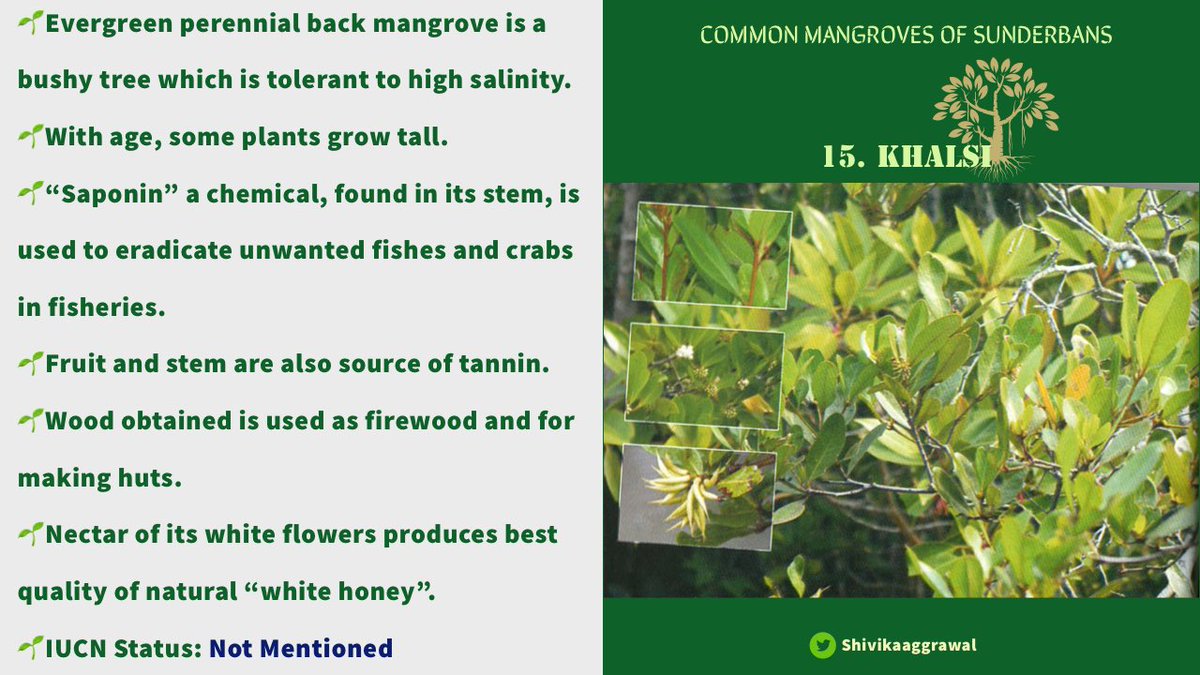 𝐊𝐇𝐀𝐋𝐒𝐈https://abs.twimg.com/emoji/v2/... draggable="false" alt="🍃" title="Im Wind flatterndes Blatt" aria-label="Emoji: Im Wind flatterndes Blatt">https://abs.twimg.com/emoji/v2/... draggable="false" alt="🐐" title="Ziege" aria-label="Emoji: Ziege">Also called Black mangrove, River mangrove, & Goat& #39;s horn mangrove.https://abs.twimg.com/emoji/v2/... draggable="false" alt="🐠" title="Tropischer Fisch" aria-label="Emoji: Tropischer Fisch">Also, Khalsi (Bengali) translates to “redemption”. This may have association with toxic chemical saponin found in tree which is used in fisheries to clear out unwanted fishes & crabs." title="https://abs.twimg.com/emoji/v2/... draggable="false" alt="🍃" title="Im Wind flatterndes Blatt" aria-label="Emoji: Im Wind flatterndes Blatt">𝐊𝐇𝐀𝐋𝐒𝐈https://abs.twimg.com/emoji/v2/... draggable="false" alt="🍃" title="Im Wind flatterndes Blatt" aria-label="Emoji: Im Wind flatterndes Blatt">https://abs.twimg.com/emoji/v2/... draggable="false" alt="🐐" title="Ziege" aria-label="Emoji: Ziege">Also called Black mangrove, River mangrove, & Goat& #39;s horn mangrove.https://abs.twimg.com/emoji/v2/... draggable="false" alt="🐠" title="Tropischer Fisch" aria-label="Emoji: Tropischer Fisch">Also, Khalsi (Bengali) translates to “redemption”. This may have association with toxic chemical saponin found in tree which is used in fisheries to clear out unwanted fishes & crabs." class="img-responsive" style="max-width:100%;"/>
𝐊𝐇𝐀𝐋𝐒𝐈https://abs.twimg.com/emoji/v2/... draggable="false" alt="🍃" title="Im Wind flatterndes Blatt" aria-label="Emoji: Im Wind flatterndes Blatt">https://abs.twimg.com/emoji/v2/... draggable="false" alt="🐐" title="Ziege" aria-label="Emoji: Ziege">Also called Black mangrove, River mangrove, & Goat& #39;s horn mangrove.https://abs.twimg.com/emoji/v2/... draggable="false" alt="🐠" title="Tropischer Fisch" aria-label="Emoji: Tropischer Fisch">Also, Khalsi (Bengali) translates to “redemption”. This may have association with toxic chemical saponin found in tree which is used in fisheries to clear out unwanted fishes & crabs." title="https://abs.twimg.com/emoji/v2/... draggable="false" alt="🍃" title="Im Wind flatterndes Blatt" aria-label="Emoji: Im Wind flatterndes Blatt">𝐊𝐇𝐀𝐋𝐒𝐈https://abs.twimg.com/emoji/v2/... draggable="false" alt="🍃" title="Im Wind flatterndes Blatt" aria-label="Emoji: Im Wind flatterndes Blatt">https://abs.twimg.com/emoji/v2/... draggable="false" alt="🐐" title="Ziege" aria-label="Emoji: Ziege">Also called Black mangrove, River mangrove, & Goat& #39;s horn mangrove.https://abs.twimg.com/emoji/v2/... draggable="false" alt="🐠" title="Tropischer Fisch" aria-label="Emoji: Tropischer Fisch">Also, Khalsi (Bengali) translates to “redemption”. This may have association with toxic chemical saponin found in tree which is used in fisheries to clear out unwanted fishes & crabs." class="img-responsive" style="max-width:100%;"/>
 𝐓𝐎𝐑𝐀https://abs.twimg.com/emoji/v2/... draggable="false" alt="🍃" title="Im Wind flatterndes Blatt" aria-label="Emoji: Im Wind flatterndes Blatt">https://abs.twimg.com/emoji/v2/... draggable="false" alt="🌟" title="Leuchtender Stern" aria-label="Emoji: Leuchtender Stern">Tora, in Bengali, translates to “star”. Since this mangrove bears white, small, star-shaped flowers; it might have been named Tora. https://abs.twimg.com/emoji/v2/... draggable="false" alt="🧂" title="Salt" aria-label="Emoji: Salt"> Its shining leaves have high density of salt glands. Therefore, dried leaves were used to prepare table salts." title="https://abs.twimg.com/emoji/v2/... draggable="false" alt="🍃" title="Im Wind flatterndes Blatt" aria-label="Emoji: Im Wind flatterndes Blatt">𝐓𝐎𝐑𝐀https://abs.twimg.com/emoji/v2/... draggable="false" alt="🍃" title="Im Wind flatterndes Blatt" aria-label="Emoji: Im Wind flatterndes Blatt">https://abs.twimg.com/emoji/v2/... draggable="false" alt="🌟" title="Leuchtender Stern" aria-label="Emoji: Leuchtender Stern">Tora, in Bengali, translates to “star”. Since this mangrove bears white, small, star-shaped flowers; it might have been named Tora. https://abs.twimg.com/emoji/v2/... draggable="false" alt="🧂" title="Salt" aria-label="Emoji: Salt"> Its shining leaves have high density of salt glands. Therefore, dried leaves were used to prepare table salts." class="img-responsive" style="max-width:100%;"/>
𝐓𝐎𝐑𝐀https://abs.twimg.com/emoji/v2/... draggable="false" alt="🍃" title="Im Wind flatterndes Blatt" aria-label="Emoji: Im Wind flatterndes Blatt">https://abs.twimg.com/emoji/v2/... draggable="false" alt="🌟" title="Leuchtender Stern" aria-label="Emoji: Leuchtender Stern">Tora, in Bengali, translates to “star”. Since this mangrove bears white, small, star-shaped flowers; it might have been named Tora. https://abs.twimg.com/emoji/v2/... draggable="false" alt="🧂" title="Salt" aria-label="Emoji: Salt"> Its shining leaves have high density of salt glands. Therefore, dried leaves were used to prepare table salts." title="https://abs.twimg.com/emoji/v2/... draggable="false" alt="🍃" title="Im Wind flatterndes Blatt" aria-label="Emoji: Im Wind flatterndes Blatt">𝐓𝐎𝐑𝐀https://abs.twimg.com/emoji/v2/... draggable="false" alt="🍃" title="Im Wind flatterndes Blatt" aria-label="Emoji: Im Wind flatterndes Blatt">https://abs.twimg.com/emoji/v2/... draggable="false" alt="🌟" title="Leuchtender Stern" aria-label="Emoji: Leuchtender Stern">Tora, in Bengali, translates to “star”. Since this mangrove bears white, small, star-shaped flowers; it might have been named Tora. https://abs.twimg.com/emoji/v2/... draggable="false" alt="🧂" title="Salt" aria-label="Emoji: Salt"> Its shining leaves have high density of salt glands. Therefore, dried leaves were used to prepare table salts." class="img-responsive" style="max-width:100%;"/>
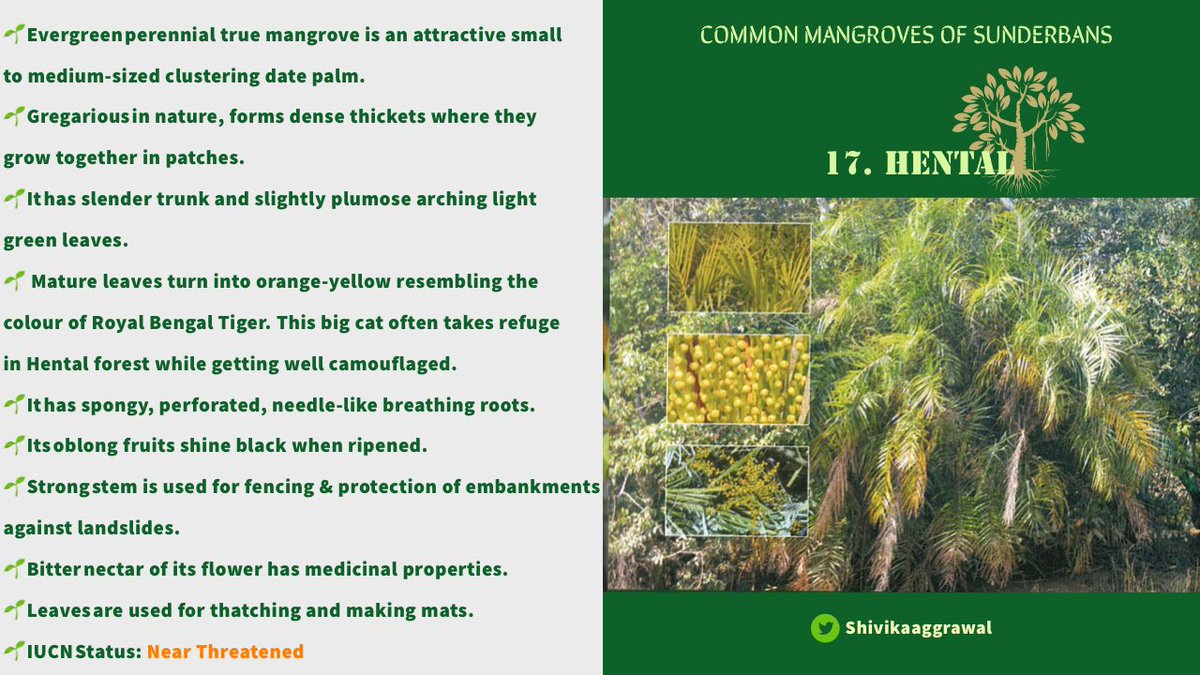 𝐇𝐄𝐍𝐓𝐀𝐋https://abs.twimg.com/emoji/v2/... draggable="false" alt="🍃" title="Im Wind flatterndes Blatt" aria-label="Emoji: Im Wind flatterndes Blatt">https://abs.twimg.com/emoji/v2/... draggable="false" alt="🌴" title="Palme" aria-label="Emoji: Palme">Hental is derived from a Sanskrit word Hintāla meaning “marshland date palm” where Hin stands for short (palm) and tāla for marsh. It is also known as Sea Dates.https://abs.twimg.com/emoji/v2/... draggable="false" alt="🐅" title="Tiger" aria-label="Emoji: Tiger">It is also called Tiger palm as it provides Big cats perfect camouflage. #WorldTigerDay2020" title="https://abs.twimg.com/emoji/v2/... draggable="false" alt="🍃" title="Im Wind flatterndes Blatt" aria-label="Emoji: Im Wind flatterndes Blatt">𝐇𝐄𝐍𝐓𝐀𝐋https://abs.twimg.com/emoji/v2/... draggable="false" alt="🍃" title="Im Wind flatterndes Blatt" aria-label="Emoji: Im Wind flatterndes Blatt">https://abs.twimg.com/emoji/v2/... draggable="false" alt="🌴" title="Palme" aria-label="Emoji: Palme">Hental is derived from a Sanskrit word Hintāla meaning “marshland date palm” where Hin stands for short (palm) and tāla for marsh. It is also known as Sea Dates.https://abs.twimg.com/emoji/v2/... draggable="false" alt="🐅" title="Tiger" aria-label="Emoji: Tiger">It is also called Tiger palm as it provides Big cats perfect camouflage. #WorldTigerDay2020" class="img-responsive" style="max-width:100%;"/>
𝐇𝐄𝐍𝐓𝐀𝐋https://abs.twimg.com/emoji/v2/... draggable="false" alt="🍃" title="Im Wind flatterndes Blatt" aria-label="Emoji: Im Wind flatterndes Blatt">https://abs.twimg.com/emoji/v2/... draggable="false" alt="🌴" title="Palme" aria-label="Emoji: Palme">Hental is derived from a Sanskrit word Hintāla meaning “marshland date palm” where Hin stands for short (palm) and tāla for marsh. It is also known as Sea Dates.https://abs.twimg.com/emoji/v2/... draggable="false" alt="🐅" title="Tiger" aria-label="Emoji: Tiger">It is also called Tiger palm as it provides Big cats perfect camouflage. #WorldTigerDay2020" title="https://abs.twimg.com/emoji/v2/... draggable="false" alt="🍃" title="Im Wind flatterndes Blatt" aria-label="Emoji: Im Wind flatterndes Blatt">𝐇𝐄𝐍𝐓𝐀𝐋https://abs.twimg.com/emoji/v2/... draggable="false" alt="🍃" title="Im Wind flatterndes Blatt" aria-label="Emoji: Im Wind flatterndes Blatt">https://abs.twimg.com/emoji/v2/... draggable="false" alt="🌴" title="Palme" aria-label="Emoji: Palme">Hental is derived from a Sanskrit word Hintāla meaning “marshland date palm” where Hin stands for short (palm) and tāla for marsh. It is also known as Sea Dates.https://abs.twimg.com/emoji/v2/... draggable="false" alt="🐅" title="Tiger" aria-label="Emoji: Tiger">It is also called Tiger palm as it provides Big cats perfect camouflage. #WorldTigerDay2020" class="img-responsive" style="max-width:100%;"/>
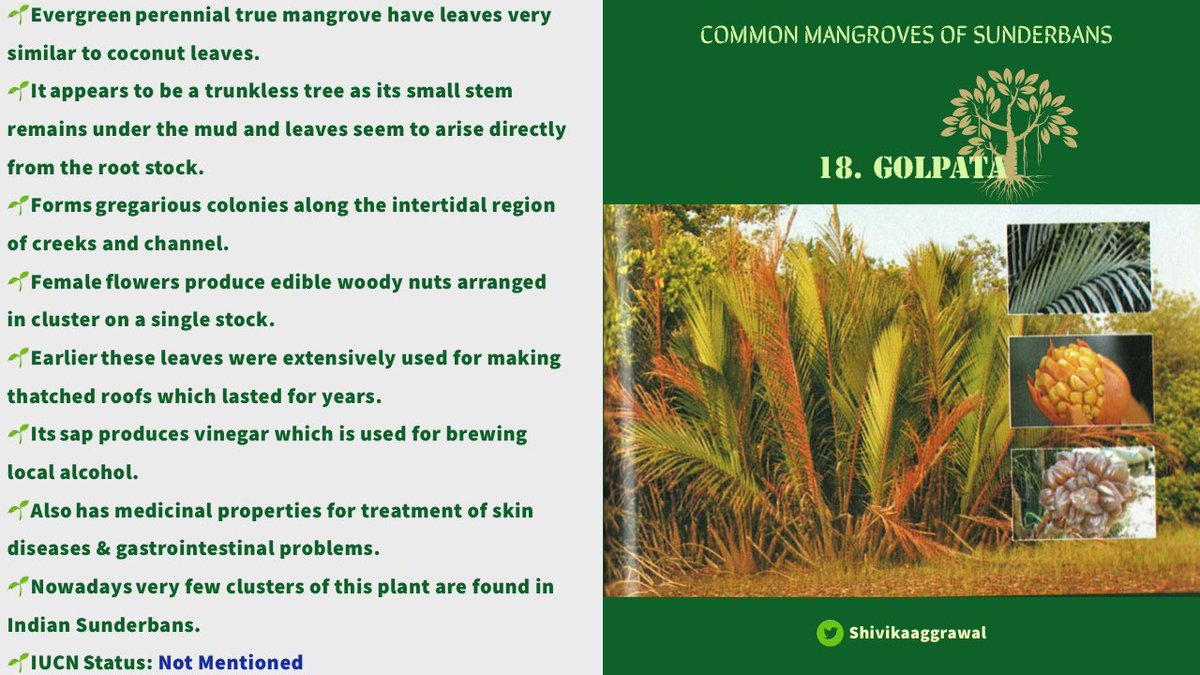 𝐆𝐎𝐋𝐏𝐀𝐓𝐀https://abs.twimg.com/emoji/v2/... draggable="false" alt="🍃" title="Im Wind flatterndes Blatt" aria-label="Emoji: Im Wind flatterndes Blatt">https://abs.twimg.com/emoji/v2/... draggable="false" alt="🥥" title="Kokosnuss" aria-label="Emoji: Kokosnuss"> Golpata is named so as it has Pata (leaf in Hindi) very similar to that of Gola (coconut in Hindi) tree. https://abs.twimg.com/emoji/v2/... draggable="false" alt="🌴" title="Palme" aria-label="Emoji: Palme">Though called “Mangrove Palm”, it is only moderately salt tolerant and prefers brackish waters of estuaries." title="https://abs.twimg.com/emoji/v2/... draggable="false" alt="🍃" title="Im Wind flatterndes Blatt" aria-label="Emoji: Im Wind flatterndes Blatt">𝐆𝐎𝐋𝐏𝐀𝐓𝐀https://abs.twimg.com/emoji/v2/... draggable="false" alt="🍃" title="Im Wind flatterndes Blatt" aria-label="Emoji: Im Wind flatterndes Blatt">https://abs.twimg.com/emoji/v2/... draggable="false" alt="🥥" title="Kokosnuss" aria-label="Emoji: Kokosnuss"> Golpata is named so as it has Pata (leaf in Hindi) very similar to that of Gola (coconut in Hindi) tree. https://abs.twimg.com/emoji/v2/... draggable="false" alt="🌴" title="Palme" aria-label="Emoji: Palme">Though called “Mangrove Palm”, it is only moderately salt tolerant and prefers brackish waters of estuaries." class="img-responsive" style="max-width:100%;"/>
𝐆𝐎𝐋𝐏𝐀𝐓𝐀https://abs.twimg.com/emoji/v2/... draggable="false" alt="🍃" title="Im Wind flatterndes Blatt" aria-label="Emoji: Im Wind flatterndes Blatt">https://abs.twimg.com/emoji/v2/... draggable="false" alt="🥥" title="Kokosnuss" aria-label="Emoji: Kokosnuss"> Golpata is named so as it has Pata (leaf in Hindi) very similar to that of Gola (coconut in Hindi) tree. https://abs.twimg.com/emoji/v2/... draggable="false" alt="🌴" title="Palme" aria-label="Emoji: Palme">Though called “Mangrove Palm”, it is only moderately salt tolerant and prefers brackish waters of estuaries." title="https://abs.twimg.com/emoji/v2/... draggable="false" alt="🍃" title="Im Wind flatterndes Blatt" aria-label="Emoji: Im Wind flatterndes Blatt">𝐆𝐎𝐋𝐏𝐀𝐓𝐀https://abs.twimg.com/emoji/v2/... draggable="false" alt="🍃" title="Im Wind flatterndes Blatt" aria-label="Emoji: Im Wind flatterndes Blatt">https://abs.twimg.com/emoji/v2/... draggable="false" alt="🥥" title="Kokosnuss" aria-label="Emoji: Kokosnuss"> Golpata is named so as it has Pata (leaf in Hindi) very similar to that of Gola (coconut in Hindi) tree. https://abs.twimg.com/emoji/v2/... draggable="false" alt="🌴" title="Palme" aria-label="Emoji: Palme">Though called “Mangrove Palm”, it is only moderately salt tolerant and prefers brackish waters of estuaries." class="img-responsive" style="max-width:100%;"/>
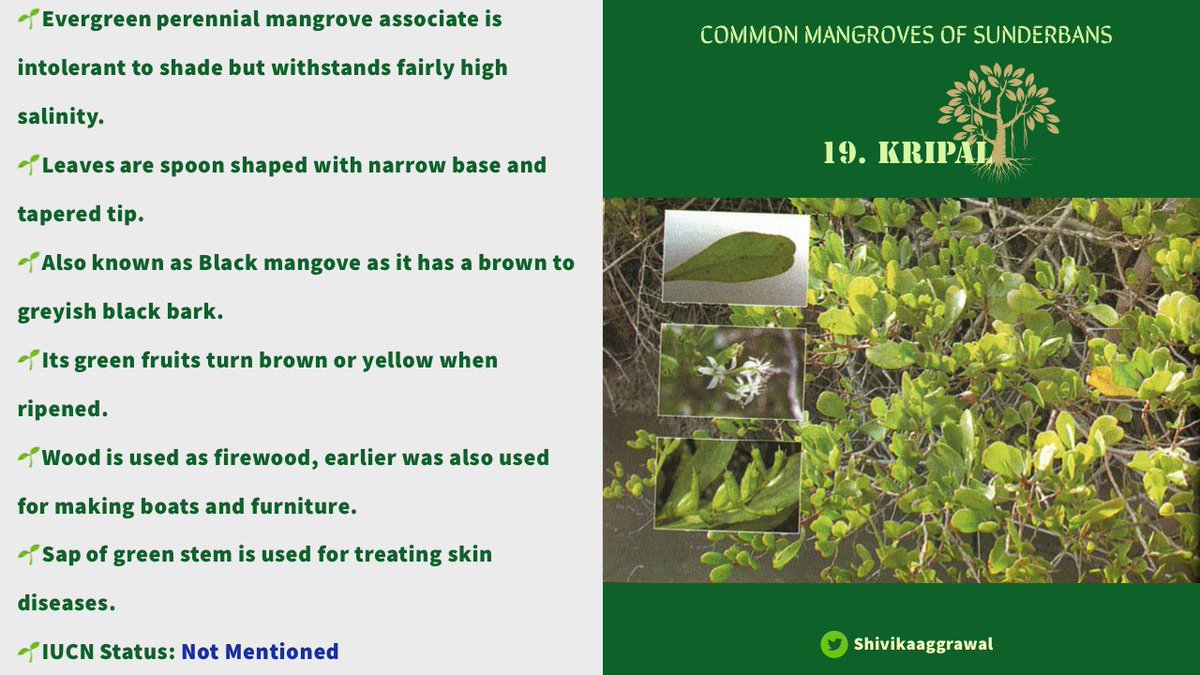 𝐊𝐑𝐈𝐏𝐀𝐋https://abs.twimg.com/emoji/v2/... draggable="false" alt="🍃" title="Im Wind flatterndes Blatt" aria-label="Emoji: Im Wind flatterndes Blatt">https://abs.twimg.com/emoji/v2/... draggable="false" alt="🕊" title="Friedens-Taube" aria-label="Emoji: Friedens-Taube">This “white flowered black mangrove” is a pretty plant having spoon shaped leaves.https://abs.twimg.com/emoji/v2/... draggable="false" alt="🍂" title="Gefallenes Blatt" aria-label="Emoji: Gefallenes Blatt">It develops pneumatophores and often has stilt roots.https://abs.twimg.com/emoji/v2/... draggable="false" alt="🟤" title="Brauner Kreis" aria-label="Emoji: Brauner Kreis">Its woody fruit contains only one seed." title="https://abs.twimg.com/emoji/v2/... draggable="false" alt="🍃" title="Im Wind flatterndes Blatt" aria-label="Emoji: Im Wind flatterndes Blatt">𝐊𝐑𝐈𝐏𝐀𝐋https://abs.twimg.com/emoji/v2/... draggable="false" alt="🍃" title="Im Wind flatterndes Blatt" aria-label="Emoji: Im Wind flatterndes Blatt">https://abs.twimg.com/emoji/v2/... draggable="false" alt="🕊" title="Friedens-Taube" aria-label="Emoji: Friedens-Taube">This “white flowered black mangrove” is a pretty plant having spoon shaped leaves.https://abs.twimg.com/emoji/v2/... draggable="false" alt="🍂" title="Gefallenes Blatt" aria-label="Emoji: Gefallenes Blatt">It develops pneumatophores and often has stilt roots.https://abs.twimg.com/emoji/v2/... draggable="false" alt="🟤" title="Brauner Kreis" aria-label="Emoji: Brauner Kreis">Its woody fruit contains only one seed." class="img-responsive" style="max-width:100%;"/>
𝐊𝐑𝐈𝐏𝐀𝐋https://abs.twimg.com/emoji/v2/... draggable="false" alt="🍃" title="Im Wind flatterndes Blatt" aria-label="Emoji: Im Wind flatterndes Blatt">https://abs.twimg.com/emoji/v2/... draggable="false" alt="🕊" title="Friedens-Taube" aria-label="Emoji: Friedens-Taube">This “white flowered black mangrove” is a pretty plant having spoon shaped leaves.https://abs.twimg.com/emoji/v2/... draggable="false" alt="🍂" title="Gefallenes Blatt" aria-label="Emoji: Gefallenes Blatt">It develops pneumatophores and often has stilt roots.https://abs.twimg.com/emoji/v2/... draggable="false" alt="🟤" title="Brauner Kreis" aria-label="Emoji: Brauner Kreis">Its woody fruit contains only one seed." title="https://abs.twimg.com/emoji/v2/... draggable="false" alt="🍃" title="Im Wind flatterndes Blatt" aria-label="Emoji: Im Wind flatterndes Blatt">𝐊𝐑𝐈𝐏𝐀𝐋https://abs.twimg.com/emoji/v2/... draggable="false" alt="🍃" title="Im Wind flatterndes Blatt" aria-label="Emoji: Im Wind flatterndes Blatt">https://abs.twimg.com/emoji/v2/... draggable="false" alt="🕊" title="Friedens-Taube" aria-label="Emoji: Friedens-Taube">This “white flowered black mangrove” is a pretty plant having spoon shaped leaves.https://abs.twimg.com/emoji/v2/... draggable="false" alt="🍂" title="Gefallenes Blatt" aria-label="Emoji: Gefallenes Blatt">It develops pneumatophores and often has stilt roots.https://abs.twimg.com/emoji/v2/... draggable="false" alt="🟤" title="Brauner Kreis" aria-label="Emoji: Brauner Kreis">Its woody fruit contains only one seed." class="img-responsive" style="max-width:100%;"/>
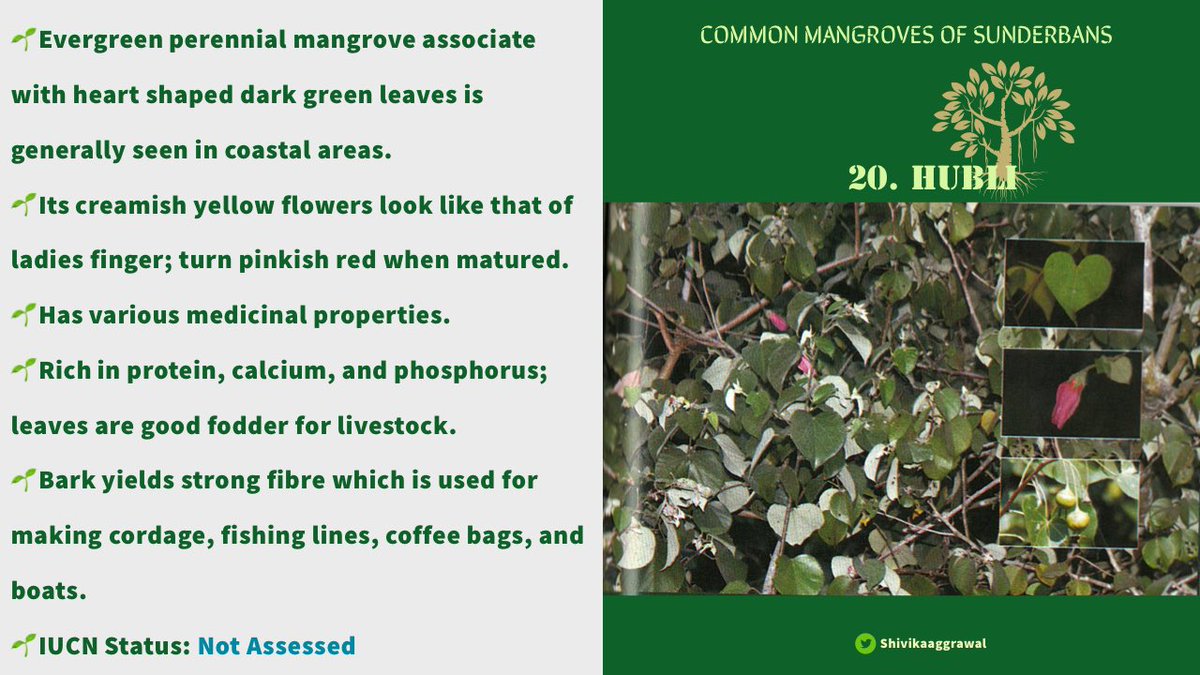 𝐇𝐔𝐁𝐋𝐈https://abs.twimg.com/emoji/v2/... draggable="false" alt="🍃" title="Im Wind flatterndes Blatt" aria-label="Emoji: Im Wind flatterndes Blatt">https://abs.twimg.com/emoji/v2/... draggable="false" alt="🌷" title="Tulpe" aria-label="Emoji: Tulpe">Commonly known as Indian tulip tree is able to grow in wide range of soil types present in coastal environments.https://abs.twimg.com/emoji/v2/... draggable="false" alt="🍏" title="Grüner Apfel" aria-label="Emoji: Grüner Apfel">It is also known as “Aden Apple tree” as flowers are followed by apple-shaped fruit." title="https://abs.twimg.com/emoji/v2/... draggable="false" alt="🍃" title="Im Wind flatterndes Blatt" aria-label="Emoji: Im Wind flatterndes Blatt">𝐇𝐔𝐁𝐋𝐈https://abs.twimg.com/emoji/v2/... draggable="false" alt="🍃" title="Im Wind flatterndes Blatt" aria-label="Emoji: Im Wind flatterndes Blatt">https://abs.twimg.com/emoji/v2/... draggable="false" alt="🌷" title="Tulpe" aria-label="Emoji: Tulpe">Commonly known as Indian tulip tree is able to grow in wide range of soil types present in coastal environments.https://abs.twimg.com/emoji/v2/... draggable="false" alt="🍏" title="Grüner Apfel" aria-label="Emoji: Grüner Apfel">It is also known as “Aden Apple tree” as flowers are followed by apple-shaped fruit." class="img-responsive" style="max-width:100%;"/>
𝐇𝐔𝐁𝐋𝐈https://abs.twimg.com/emoji/v2/... draggable="false" alt="🍃" title="Im Wind flatterndes Blatt" aria-label="Emoji: Im Wind flatterndes Blatt">https://abs.twimg.com/emoji/v2/... draggable="false" alt="🌷" title="Tulpe" aria-label="Emoji: Tulpe">Commonly known as Indian tulip tree is able to grow in wide range of soil types present in coastal environments.https://abs.twimg.com/emoji/v2/... draggable="false" alt="🍏" title="Grüner Apfel" aria-label="Emoji: Grüner Apfel">It is also known as “Aden Apple tree” as flowers are followed by apple-shaped fruit." title="https://abs.twimg.com/emoji/v2/... draggable="false" alt="🍃" title="Im Wind flatterndes Blatt" aria-label="Emoji: Im Wind flatterndes Blatt">𝐇𝐔𝐁𝐋𝐈https://abs.twimg.com/emoji/v2/... draggable="false" alt="🍃" title="Im Wind flatterndes Blatt" aria-label="Emoji: Im Wind flatterndes Blatt">https://abs.twimg.com/emoji/v2/... draggable="false" alt="🌷" title="Tulpe" aria-label="Emoji: Tulpe">Commonly known as Indian tulip tree is able to grow in wide range of soil types present in coastal environments.https://abs.twimg.com/emoji/v2/... draggable="false" alt="🍏" title="Grüner Apfel" aria-label="Emoji: Grüner Apfel">It is also known as “Aden Apple tree” as flowers are followed by apple-shaped fruit." class="img-responsive" style="max-width:100%;"/>
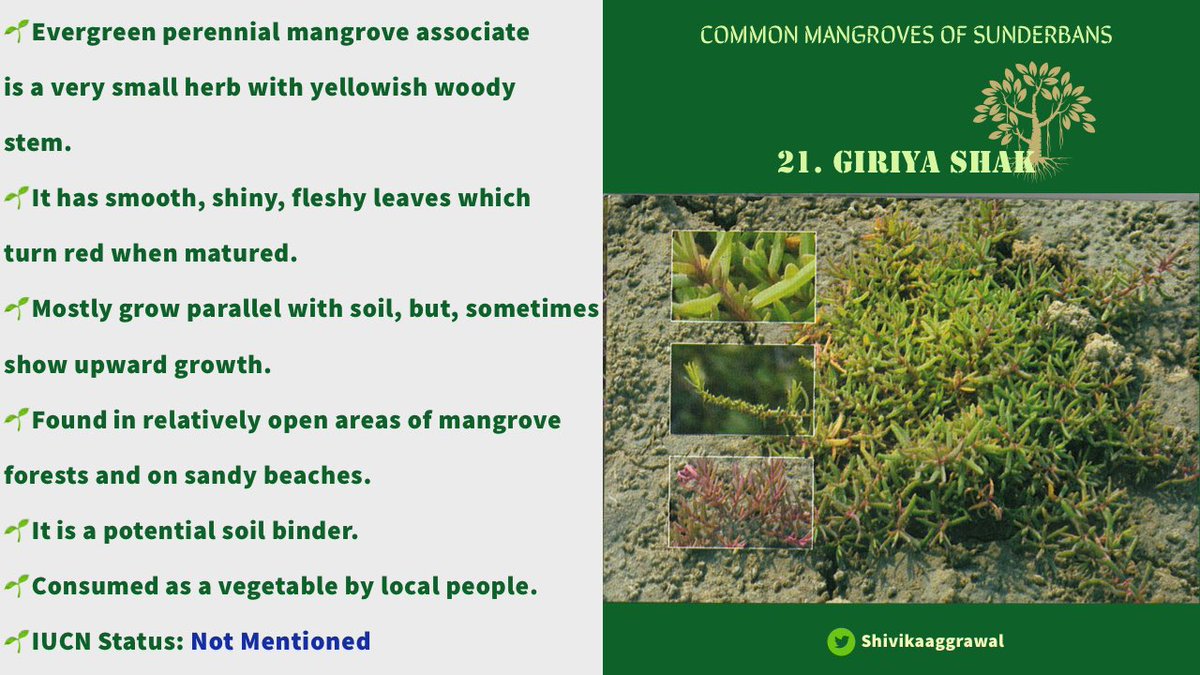 𝐆𝐈𝐑𝐈𝐘𝐀 𝐒𝐇𝐀𝐊https://abs.twimg.com/emoji/v2/... draggable="false" alt="🍃" title="Im Wind flatterndes Blatt" aria-label="Emoji: Im Wind flatterndes Blatt">https://abs.twimg.com/emoji/v2/... draggable="false" alt="🥬" title="Leafy green" aria-label="Emoji: Leafy green">Shak in Bengali refers to green leafy vegetable called spinach. Similarly Giriya Shak is consumed as a green leafy vegetable.https://abs.twimg.com/emoji/v2/... draggable="false" alt="📏" title="Gerades Lineal" aria-label="Emoji: Gerades Lineal">Generally donot grow more than one and half feet in height." title="https://abs.twimg.com/emoji/v2/... draggable="false" alt="🍃" title="Im Wind flatterndes Blatt" aria-label="Emoji: Im Wind flatterndes Blatt">𝐆𝐈𝐑𝐈𝐘𝐀 𝐒𝐇𝐀𝐊https://abs.twimg.com/emoji/v2/... draggable="false" alt="🍃" title="Im Wind flatterndes Blatt" aria-label="Emoji: Im Wind flatterndes Blatt">https://abs.twimg.com/emoji/v2/... draggable="false" alt="🥬" title="Leafy green" aria-label="Emoji: Leafy green">Shak in Bengali refers to green leafy vegetable called spinach. Similarly Giriya Shak is consumed as a green leafy vegetable.https://abs.twimg.com/emoji/v2/... draggable="false" alt="📏" title="Gerades Lineal" aria-label="Emoji: Gerades Lineal">Generally donot grow more than one and half feet in height." class="img-responsive" style="max-width:100%;"/>
𝐆𝐈𝐑𝐈𝐘𝐀 𝐒𝐇𝐀𝐊https://abs.twimg.com/emoji/v2/... draggable="false" alt="🍃" title="Im Wind flatterndes Blatt" aria-label="Emoji: Im Wind flatterndes Blatt">https://abs.twimg.com/emoji/v2/... draggable="false" alt="🥬" title="Leafy green" aria-label="Emoji: Leafy green">Shak in Bengali refers to green leafy vegetable called spinach. Similarly Giriya Shak is consumed as a green leafy vegetable.https://abs.twimg.com/emoji/v2/... draggable="false" alt="📏" title="Gerades Lineal" aria-label="Emoji: Gerades Lineal">Generally donot grow more than one and half feet in height." title="https://abs.twimg.com/emoji/v2/... draggable="false" alt="🍃" title="Im Wind flatterndes Blatt" aria-label="Emoji: Im Wind flatterndes Blatt">𝐆𝐈𝐑𝐈𝐘𝐀 𝐒𝐇𝐀𝐊https://abs.twimg.com/emoji/v2/... draggable="false" alt="🍃" title="Im Wind flatterndes Blatt" aria-label="Emoji: Im Wind flatterndes Blatt">https://abs.twimg.com/emoji/v2/... draggable="false" alt="🥬" title="Leafy green" aria-label="Emoji: Leafy green">Shak in Bengali refers to green leafy vegetable called spinach. Similarly Giriya Shak is consumed as a green leafy vegetable.https://abs.twimg.com/emoji/v2/... draggable="false" alt="📏" title="Gerades Lineal" aria-label="Emoji: Gerades Lineal">Generally donot grow more than one and half feet in height." class="img-responsive" style="max-width:100%;"/>
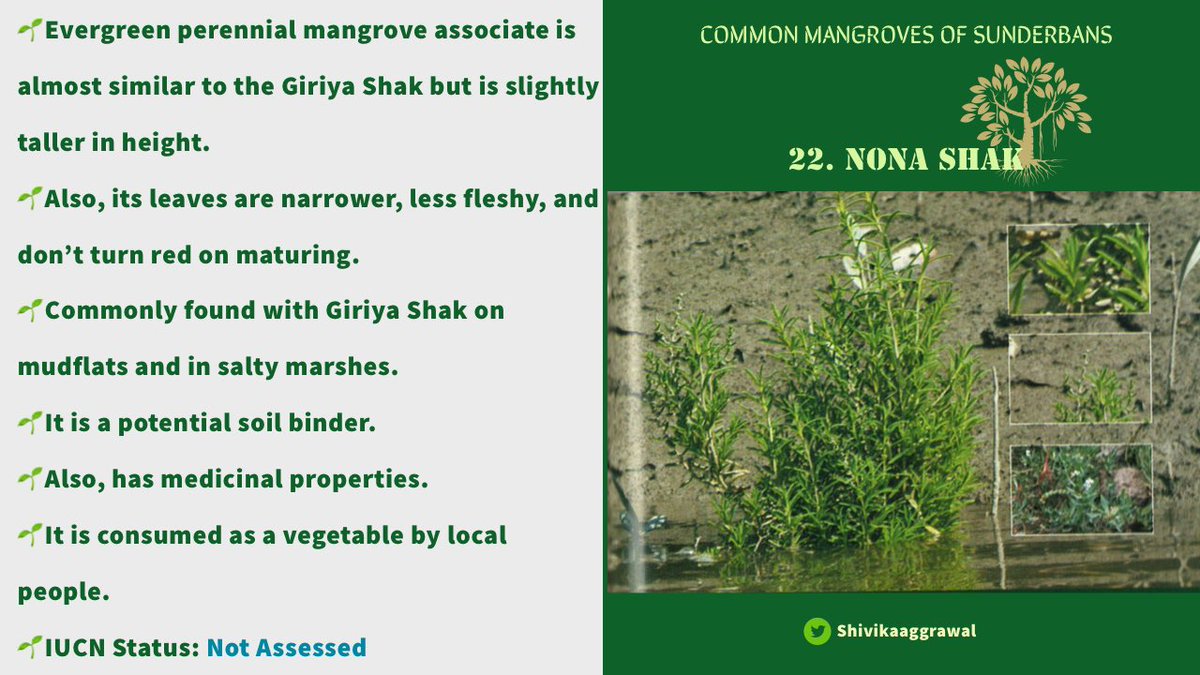 𝐍𝐎𝐍𝐀 𝐒𝐇𝐀𝐊https://abs.twimg.com/emoji/v2/... draggable="false" alt="🍃" title="Im Wind flatterndes Blatt" aria-label="Emoji: Im Wind flatterndes Blatt">https://abs.twimg.com/emoji/v2/... draggable="false" alt="🥗" title="Grüner Salat" aria-label="Emoji: Grüner Salat">As its name suggests, nona shak, is consumed as green leafy vegetable.https://abs.twimg.com/emoji/v2/... draggable="false" alt="🧂" title="Salt" aria-label="Emoji: Salt">Due to its high salt content, it is also used as a seasoning with other foods." title="https://abs.twimg.com/emoji/v2/... draggable="false" alt="🍃" title="Im Wind flatterndes Blatt" aria-label="Emoji: Im Wind flatterndes Blatt">𝐍𝐎𝐍𝐀 𝐒𝐇𝐀𝐊https://abs.twimg.com/emoji/v2/... draggable="false" alt="🍃" title="Im Wind flatterndes Blatt" aria-label="Emoji: Im Wind flatterndes Blatt">https://abs.twimg.com/emoji/v2/... draggable="false" alt="🥗" title="Grüner Salat" aria-label="Emoji: Grüner Salat">As its name suggests, nona shak, is consumed as green leafy vegetable.https://abs.twimg.com/emoji/v2/... draggable="false" alt="🧂" title="Salt" aria-label="Emoji: Salt">Due to its high salt content, it is also used as a seasoning with other foods." class="img-responsive" style="max-width:100%;"/>
𝐍𝐎𝐍𝐀 𝐒𝐇𝐀𝐊https://abs.twimg.com/emoji/v2/... draggable="false" alt="🍃" title="Im Wind flatterndes Blatt" aria-label="Emoji: Im Wind flatterndes Blatt">https://abs.twimg.com/emoji/v2/... draggable="false" alt="🥗" title="Grüner Salat" aria-label="Emoji: Grüner Salat">As its name suggests, nona shak, is consumed as green leafy vegetable.https://abs.twimg.com/emoji/v2/... draggable="false" alt="🧂" title="Salt" aria-label="Emoji: Salt">Due to its high salt content, it is also used as a seasoning with other foods." title="https://abs.twimg.com/emoji/v2/... draggable="false" alt="🍃" title="Im Wind flatterndes Blatt" aria-label="Emoji: Im Wind flatterndes Blatt">𝐍𝐎𝐍𝐀 𝐒𝐇𝐀𝐊https://abs.twimg.com/emoji/v2/... draggable="false" alt="🍃" title="Im Wind flatterndes Blatt" aria-label="Emoji: Im Wind flatterndes Blatt">https://abs.twimg.com/emoji/v2/... draggable="false" alt="🥗" title="Grüner Salat" aria-label="Emoji: Grüner Salat">As its name suggests, nona shak, is consumed as green leafy vegetable.https://abs.twimg.com/emoji/v2/... draggable="false" alt="🧂" title="Salt" aria-label="Emoji: Salt">Due to its high salt content, it is also used as a seasoning with other foods." class="img-responsive" style="max-width:100%;"/>
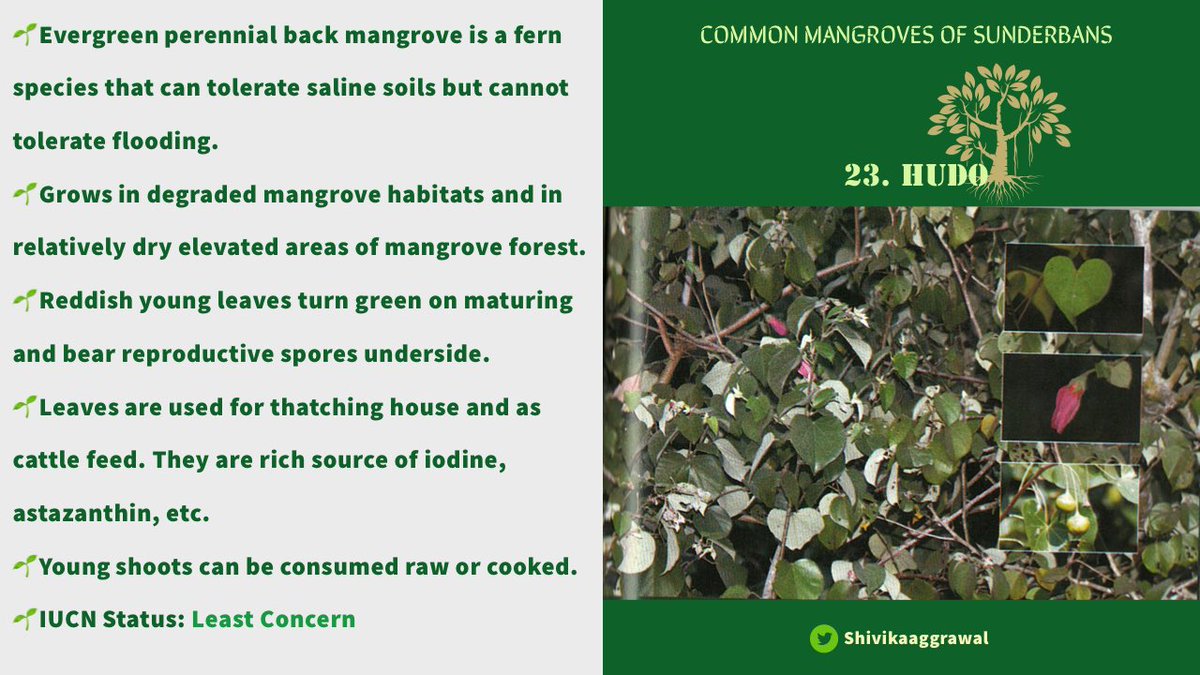 𝐇𝐔𝐃𝐎https://abs.twimg.com/emoji/v2/... draggable="false" alt="🍃" title="Im Wind flatterndes Blatt" aria-label="Emoji: Im Wind flatterndes Blatt">https://abs.twimg.com/emoji/v2/... draggable="false" alt="🍁" title="Ahornblatt" aria-label="Emoji: Ahornblatt">Only mangrove terrestrial fern is commonly known as “Golden Leather Fern” owingto its matured reddish aand dark brown elongated leaves. https://abs.twimg.com/emoji/v2/... draggable="false" alt="🌊" title="Wasserwelle" aria-label="Emoji: Wasserwelle">Grows in upper reaches of tidal zone, perticularly, from where tidal water has retreated." title="https://abs.twimg.com/emoji/v2/... draggable="false" alt="🍃" title="Im Wind flatterndes Blatt" aria-label="Emoji: Im Wind flatterndes Blatt">𝐇𝐔𝐃𝐎https://abs.twimg.com/emoji/v2/... draggable="false" alt="🍃" title="Im Wind flatterndes Blatt" aria-label="Emoji: Im Wind flatterndes Blatt">https://abs.twimg.com/emoji/v2/... draggable="false" alt="🍁" title="Ahornblatt" aria-label="Emoji: Ahornblatt">Only mangrove terrestrial fern is commonly known as “Golden Leather Fern” owingto its matured reddish aand dark brown elongated leaves. https://abs.twimg.com/emoji/v2/... draggable="false" alt="🌊" title="Wasserwelle" aria-label="Emoji: Wasserwelle">Grows in upper reaches of tidal zone, perticularly, from where tidal water has retreated." class="img-responsive" style="max-width:100%;"/>
𝐇𝐔𝐃𝐎https://abs.twimg.com/emoji/v2/... draggable="false" alt="🍃" title="Im Wind flatterndes Blatt" aria-label="Emoji: Im Wind flatterndes Blatt">https://abs.twimg.com/emoji/v2/... draggable="false" alt="🍁" title="Ahornblatt" aria-label="Emoji: Ahornblatt">Only mangrove terrestrial fern is commonly known as “Golden Leather Fern” owingto its matured reddish aand dark brown elongated leaves. https://abs.twimg.com/emoji/v2/... draggable="false" alt="🌊" title="Wasserwelle" aria-label="Emoji: Wasserwelle">Grows in upper reaches of tidal zone, perticularly, from where tidal water has retreated." title="https://abs.twimg.com/emoji/v2/... draggable="false" alt="🍃" title="Im Wind flatterndes Blatt" aria-label="Emoji: Im Wind flatterndes Blatt">𝐇𝐔𝐃𝐎https://abs.twimg.com/emoji/v2/... draggable="false" alt="🍃" title="Im Wind flatterndes Blatt" aria-label="Emoji: Im Wind flatterndes Blatt">https://abs.twimg.com/emoji/v2/... draggable="false" alt="🍁" title="Ahornblatt" aria-label="Emoji: Ahornblatt">Only mangrove terrestrial fern is commonly known as “Golden Leather Fern” owingto its matured reddish aand dark brown elongated leaves. https://abs.twimg.com/emoji/v2/... draggable="false" alt="🌊" title="Wasserwelle" aria-label="Emoji: Wasserwelle">Grows in upper reaches of tidal zone, perticularly, from where tidal water has retreated." class="img-responsive" style="max-width:100%;"/>
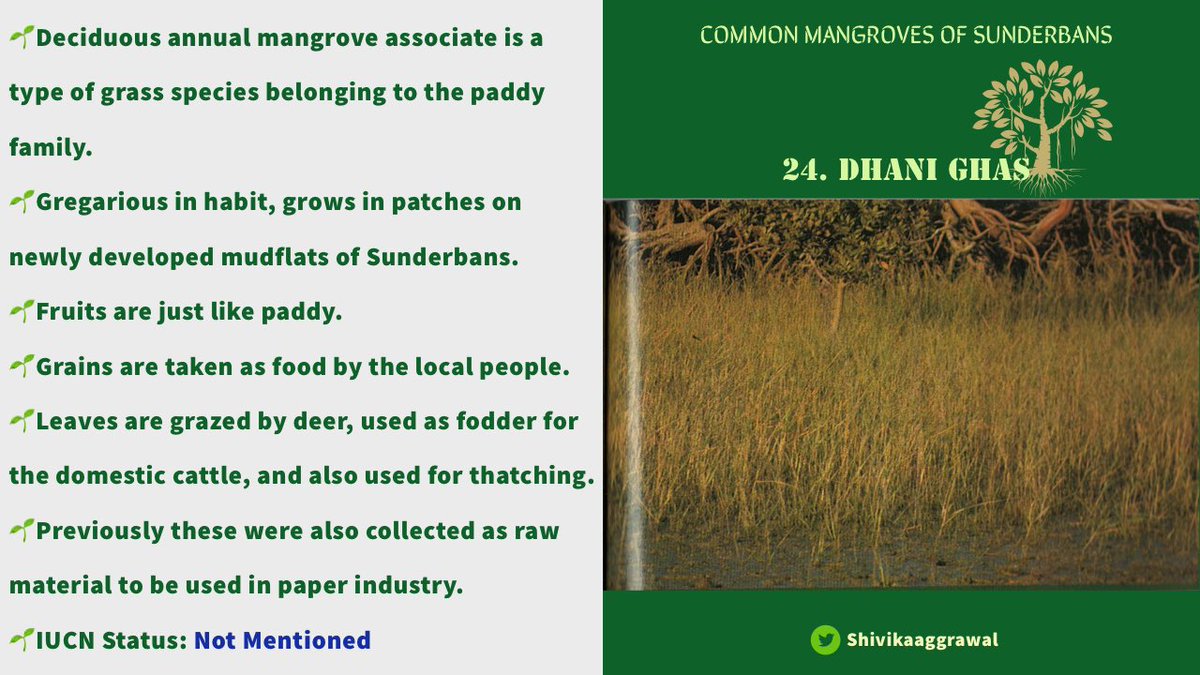 𝐃𝐇𝐀𝐍𝐈 𝐆𝐇𝐀𝐒https://abs.twimg.com/emoji/v2/... draggable="false" alt="🍃" title="Im Wind flatterndes Blatt" aria-label="Emoji: Im Wind flatterndes Blatt">https://abs.twimg.com/emoji/v2/... draggable="false" alt="🌾" title="Reisgetreide" aria-label="Emoji: Reisgetreide">Dhani Ghas is named so as this grass (ghas) belongs to the paddy (dhani) family.https://abs.twimg.com/emoji/v2/... draggable="false" alt="🧂" title="Salt" aria-label="Emoji: Salt"> A pioneer species of mangrove excretes salt crystals through its leaves.https://abs.twimg.com/emoji/v2/... draggable="false" alt="🐒" title="Affe" aria-label="Emoji: Affe"> Roots are preferred food of wild boars and even rhesus monkey." title="https://abs.twimg.com/emoji/v2/... draggable="false" alt="🍃" title="Im Wind flatterndes Blatt" aria-label="Emoji: Im Wind flatterndes Blatt">𝐃𝐇𝐀𝐍𝐈 𝐆𝐇𝐀𝐒https://abs.twimg.com/emoji/v2/... draggable="false" alt="🍃" title="Im Wind flatterndes Blatt" aria-label="Emoji: Im Wind flatterndes Blatt">https://abs.twimg.com/emoji/v2/... draggable="false" alt="🌾" title="Reisgetreide" aria-label="Emoji: Reisgetreide">Dhani Ghas is named so as this grass (ghas) belongs to the paddy (dhani) family.https://abs.twimg.com/emoji/v2/... draggable="false" alt="🧂" title="Salt" aria-label="Emoji: Salt"> A pioneer species of mangrove excretes salt crystals through its leaves.https://abs.twimg.com/emoji/v2/... draggable="false" alt="🐒" title="Affe" aria-label="Emoji: Affe"> Roots are preferred food of wild boars and even rhesus monkey." class="img-responsive" style="max-width:100%;"/>
𝐃𝐇𝐀𝐍𝐈 𝐆𝐇𝐀𝐒https://abs.twimg.com/emoji/v2/... draggable="false" alt="🍃" title="Im Wind flatterndes Blatt" aria-label="Emoji: Im Wind flatterndes Blatt">https://abs.twimg.com/emoji/v2/... draggable="false" alt="🌾" title="Reisgetreide" aria-label="Emoji: Reisgetreide">Dhani Ghas is named so as this grass (ghas) belongs to the paddy (dhani) family.https://abs.twimg.com/emoji/v2/... draggable="false" alt="🧂" title="Salt" aria-label="Emoji: Salt"> A pioneer species of mangrove excretes salt crystals through its leaves.https://abs.twimg.com/emoji/v2/... draggable="false" alt="🐒" title="Affe" aria-label="Emoji: Affe"> Roots are preferred food of wild boars and even rhesus monkey." title="https://abs.twimg.com/emoji/v2/... draggable="false" alt="🍃" title="Im Wind flatterndes Blatt" aria-label="Emoji: Im Wind flatterndes Blatt">𝐃𝐇𝐀𝐍𝐈 𝐆𝐇𝐀𝐒https://abs.twimg.com/emoji/v2/... draggable="false" alt="🍃" title="Im Wind flatterndes Blatt" aria-label="Emoji: Im Wind flatterndes Blatt">https://abs.twimg.com/emoji/v2/... draggable="false" alt="🌾" title="Reisgetreide" aria-label="Emoji: Reisgetreide">Dhani Ghas is named so as this grass (ghas) belongs to the paddy (dhani) family.https://abs.twimg.com/emoji/v2/... draggable="false" alt="🧂" title="Salt" aria-label="Emoji: Salt"> A pioneer species of mangrove excretes salt crystals through its leaves.https://abs.twimg.com/emoji/v2/... draggable="false" alt="🐒" title="Affe" aria-label="Emoji: Affe"> Roots are preferred food of wild boars and even rhesus monkey." class="img-responsive" style="max-width:100%;"/>
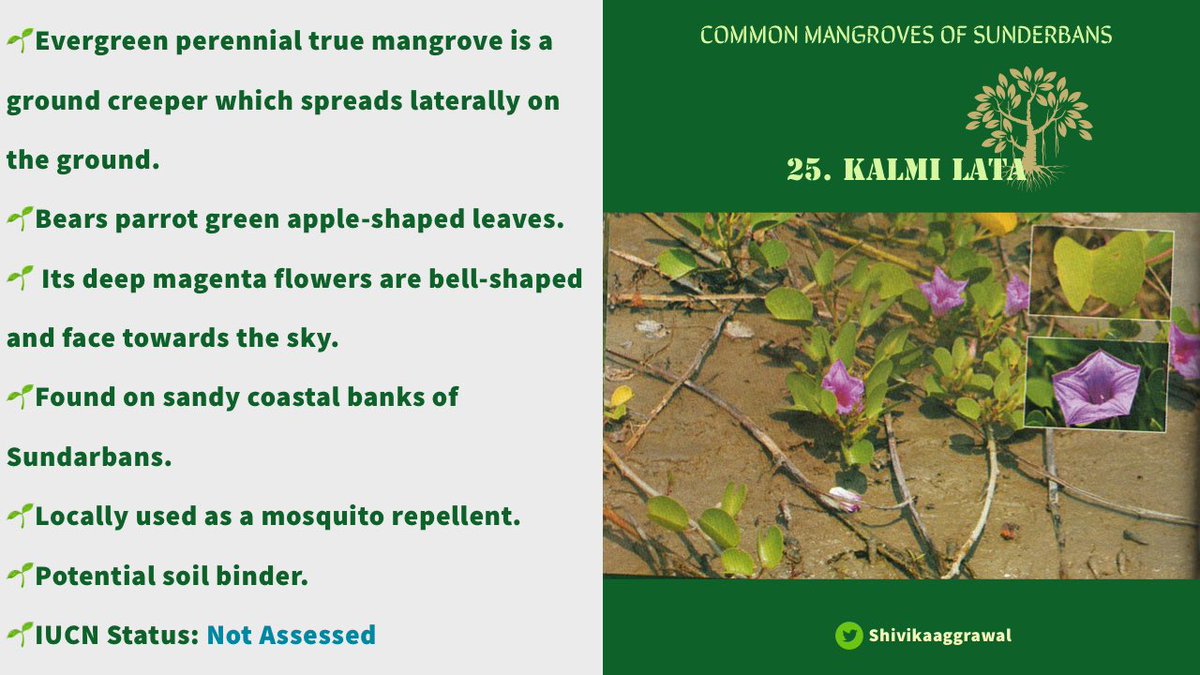 𝐊𝐀𝐋𝐌𝐈 𝐋𝐀𝐓𝐀https://abs.twimg.com/emoji/v2/... draggable="false" alt="🍃" title="Im Wind flatterndes Blatt" aria-label="Emoji: Im Wind flatterndes Blatt">https://abs.twimg.com/emoji/v2/... draggable="false" alt="🎋" title="Tanabata Baum" aria-label="Emoji: Tanabata Baum">Kalam refers to “stem” and Lata means “creeper”, therefore, name suggests that it is a creeper with a woody stem.https://abs.twimg.com/emoji/v2/... draggable="false" alt="🌸" title="Kirschblüte" aria-label="Emoji: Kirschblüte">It has beautiful flowers which are bell-shaped and face towards the sky. They are deep magenta colored inside and pink outside." title="https://abs.twimg.com/emoji/v2/... draggable="false" alt="🍃" title="Im Wind flatterndes Blatt" aria-label="Emoji: Im Wind flatterndes Blatt">𝐊𝐀𝐋𝐌𝐈 𝐋𝐀𝐓𝐀https://abs.twimg.com/emoji/v2/... draggable="false" alt="🍃" title="Im Wind flatterndes Blatt" aria-label="Emoji: Im Wind flatterndes Blatt">https://abs.twimg.com/emoji/v2/... draggable="false" alt="🎋" title="Tanabata Baum" aria-label="Emoji: Tanabata Baum">Kalam refers to “stem” and Lata means “creeper”, therefore, name suggests that it is a creeper with a woody stem.https://abs.twimg.com/emoji/v2/... draggable="false" alt="🌸" title="Kirschblüte" aria-label="Emoji: Kirschblüte">It has beautiful flowers which are bell-shaped and face towards the sky. They are deep magenta colored inside and pink outside." class="img-responsive" style="max-width:100%;"/>
𝐊𝐀𝐋𝐌𝐈 𝐋𝐀𝐓𝐀https://abs.twimg.com/emoji/v2/... draggable="false" alt="🍃" title="Im Wind flatterndes Blatt" aria-label="Emoji: Im Wind flatterndes Blatt">https://abs.twimg.com/emoji/v2/... draggable="false" alt="🎋" title="Tanabata Baum" aria-label="Emoji: Tanabata Baum">Kalam refers to “stem” and Lata means “creeper”, therefore, name suggests that it is a creeper with a woody stem.https://abs.twimg.com/emoji/v2/... draggable="false" alt="🌸" title="Kirschblüte" aria-label="Emoji: Kirschblüte">It has beautiful flowers which are bell-shaped and face towards the sky. They are deep magenta colored inside and pink outside." title="https://abs.twimg.com/emoji/v2/... draggable="false" alt="🍃" title="Im Wind flatterndes Blatt" aria-label="Emoji: Im Wind flatterndes Blatt">𝐊𝐀𝐋𝐌𝐈 𝐋𝐀𝐓𝐀https://abs.twimg.com/emoji/v2/... draggable="false" alt="🍃" title="Im Wind flatterndes Blatt" aria-label="Emoji: Im Wind flatterndes Blatt">https://abs.twimg.com/emoji/v2/... draggable="false" alt="🎋" title="Tanabata Baum" aria-label="Emoji: Tanabata Baum">Kalam refers to “stem” and Lata means “creeper”, therefore, name suggests that it is a creeper with a woody stem.https://abs.twimg.com/emoji/v2/... draggable="false" alt="🌸" title="Kirschblüte" aria-label="Emoji: Kirschblüte">It has beautiful flowers which are bell-shaped and face towards the sky. They are deep magenta colored inside and pink outside." class="img-responsive" style="max-width:100%;"/>
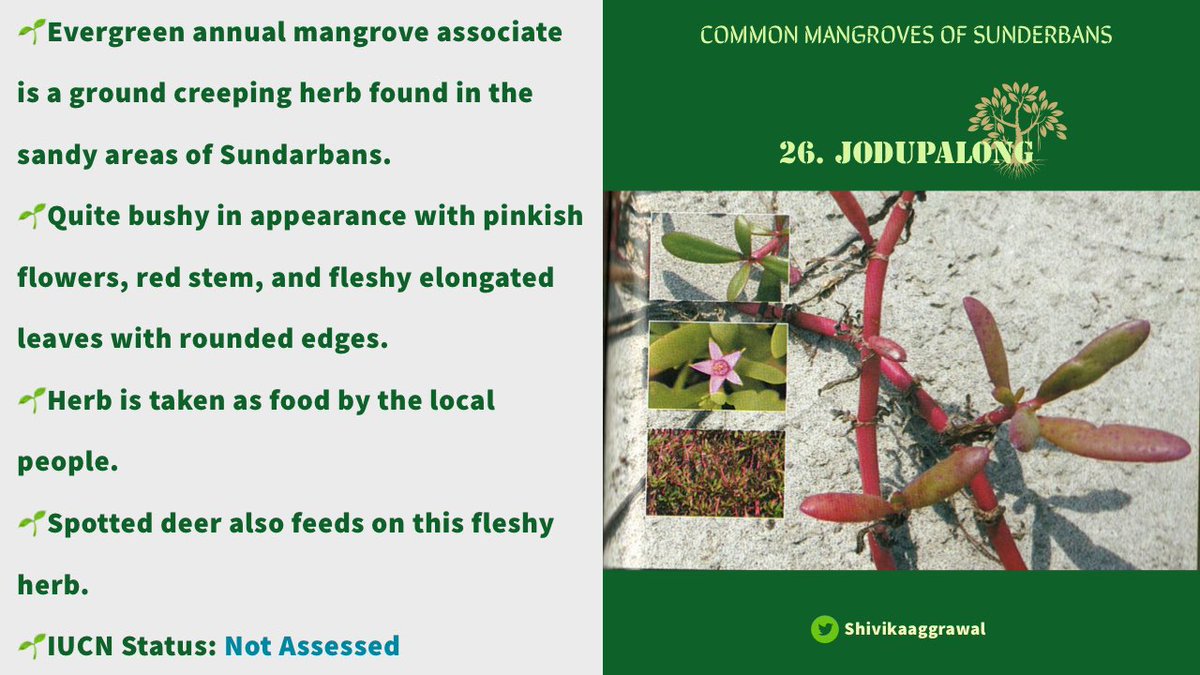 𝐉𝐎𝐃𝐔𝐏𝐀𝐋𝐎𝐍𝐆https://abs.twimg.com/emoji/v2/... draggable="false" alt="🍃" title="Im Wind flatterndes Blatt" aria-label="Emoji: Im Wind flatterndes Blatt">https://abs.twimg.com/emoji/v2/... draggable="false" alt="🥬" title="Leafy green" aria-label="Emoji: Leafy green">Palong translates to “spinach” or “vegetable”. Since its taken as food by local people, this creeping herb, is named so.https://abs.twimg.com/emoji/v2/... draggable="false" alt="🌟" title="Leuchtender Stern" aria-label="Emoji: Leuchtender Stern">Its 5-petals star-shaped pink flowers look beautiful." title="https://abs.twimg.com/emoji/v2/... draggable="false" alt="🍃" title="Im Wind flatterndes Blatt" aria-label="Emoji: Im Wind flatterndes Blatt">𝐉𝐎𝐃𝐔𝐏𝐀𝐋𝐎𝐍𝐆https://abs.twimg.com/emoji/v2/... draggable="false" alt="🍃" title="Im Wind flatterndes Blatt" aria-label="Emoji: Im Wind flatterndes Blatt">https://abs.twimg.com/emoji/v2/... draggable="false" alt="🥬" title="Leafy green" aria-label="Emoji: Leafy green">Palong translates to “spinach” or “vegetable”. Since its taken as food by local people, this creeping herb, is named so.https://abs.twimg.com/emoji/v2/... draggable="false" alt="🌟" title="Leuchtender Stern" aria-label="Emoji: Leuchtender Stern">Its 5-petals star-shaped pink flowers look beautiful." class="img-responsive" style="max-width:100%;"/>
𝐉𝐎𝐃𝐔𝐏𝐀𝐋𝐎𝐍𝐆https://abs.twimg.com/emoji/v2/... draggable="false" alt="🍃" title="Im Wind flatterndes Blatt" aria-label="Emoji: Im Wind flatterndes Blatt">https://abs.twimg.com/emoji/v2/... draggable="false" alt="🥬" title="Leafy green" aria-label="Emoji: Leafy green">Palong translates to “spinach” or “vegetable”. Since its taken as food by local people, this creeping herb, is named so.https://abs.twimg.com/emoji/v2/... draggable="false" alt="🌟" title="Leuchtender Stern" aria-label="Emoji: Leuchtender Stern">Its 5-petals star-shaped pink flowers look beautiful." title="https://abs.twimg.com/emoji/v2/... draggable="false" alt="🍃" title="Im Wind flatterndes Blatt" aria-label="Emoji: Im Wind flatterndes Blatt">𝐉𝐎𝐃𝐔𝐏𝐀𝐋𝐎𝐍𝐆https://abs.twimg.com/emoji/v2/... draggable="false" alt="🍃" title="Im Wind flatterndes Blatt" aria-label="Emoji: Im Wind flatterndes Blatt">https://abs.twimg.com/emoji/v2/... draggable="false" alt="🥬" title="Leafy green" aria-label="Emoji: Leafy green">Palong translates to “spinach” or “vegetable”. Since its taken as food by local people, this creeping herb, is named so.https://abs.twimg.com/emoji/v2/... draggable="false" alt="🌟" title="Leuchtender Stern" aria-label="Emoji: Leuchtender Stern">Its 5-petals star-shaped pink flowers look beautiful." class="img-responsive" style="max-width:100%;"/>
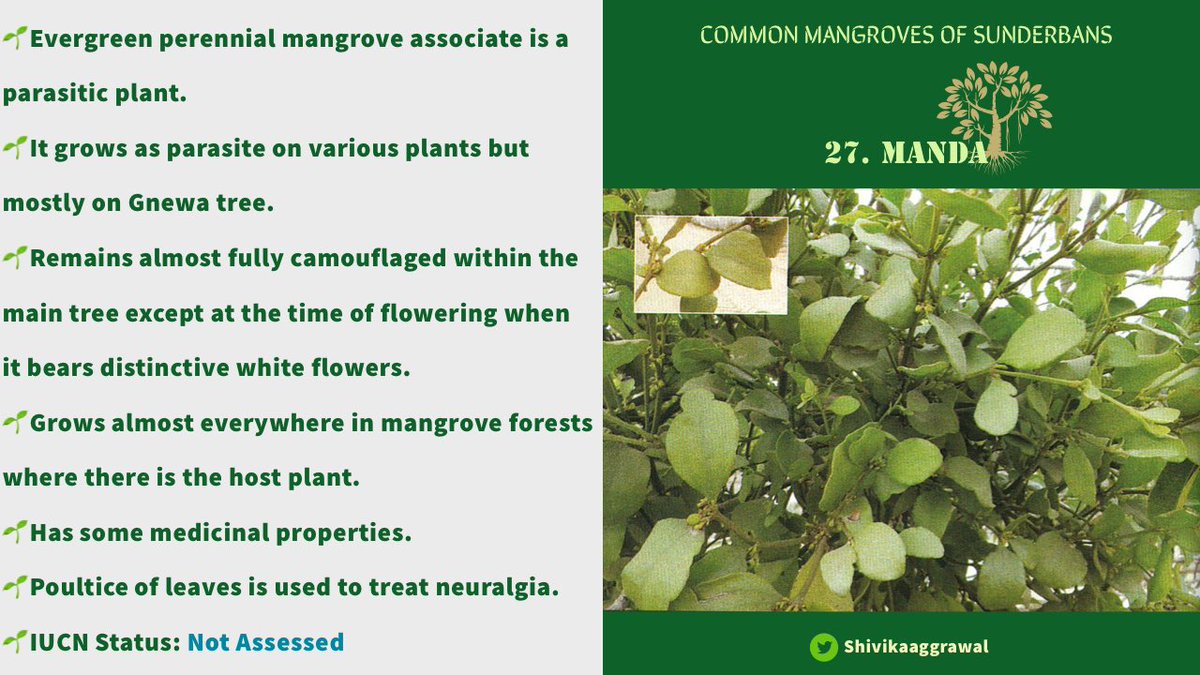 𝐌𝐀𝐍𝐃𝐀https://abs.twimg.com/emoji/v2/... draggable="false" alt="🍃" title="Im Wind flatterndes Blatt" aria-label="Emoji: Im Wind flatterndes Blatt">https://abs.twimg.com/emoji/v2/... draggable="false" alt="🐌" title="Schnecke" aria-label="Emoji: Schnecke">Manda seems to be derived from Sanskrit word which roughly translates to slow, tardy,sick,bad something that can be associated with parasites.https://abs.twimg.com/emoji/v2/... draggable="false" alt="☘️" title="Kleeblatt" aria-label="Emoji: Kleeblatt">Remains almost fully camouflaged within the main tree except at the time of flowering." title="https://abs.twimg.com/emoji/v2/... draggable="false" alt="🍃" title="Im Wind flatterndes Blatt" aria-label="Emoji: Im Wind flatterndes Blatt">𝐌𝐀𝐍𝐃𝐀https://abs.twimg.com/emoji/v2/... draggable="false" alt="🍃" title="Im Wind flatterndes Blatt" aria-label="Emoji: Im Wind flatterndes Blatt">https://abs.twimg.com/emoji/v2/... draggable="false" alt="🐌" title="Schnecke" aria-label="Emoji: Schnecke">Manda seems to be derived from Sanskrit word which roughly translates to slow, tardy,sick,bad something that can be associated with parasites.https://abs.twimg.com/emoji/v2/... draggable="false" alt="☘️" title="Kleeblatt" aria-label="Emoji: Kleeblatt">Remains almost fully camouflaged within the main tree except at the time of flowering." class="img-responsive" style="max-width:100%;"/>
𝐌𝐀𝐍𝐃𝐀https://abs.twimg.com/emoji/v2/... draggable="false" alt="🍃" title="Im Wind flatterndes Blatt" aria-label="Emoji: Im Wind flatterndes Blatt">https://abs.twimg.com/emoji/v2/... draggable="false" alt="🐌" title="Schnecke" aria-label="Emoji: Schnecke">Manda seems to be derived from Sanskrit word which roughly translates to slow, tardy,sick,bad something that can be associated with parasites.https://abs.twimg.com/emoji/v2/... draggable="false" alt="☘️" title="Kleeblatt" aria-label="Emoji: Kleeblatt">Remains almost fully camouflaged within the main tree except at the time of flowering." title="https://abs.twimg.com/emoji/v2/... draggable="false" alt="🍃" title="Im Wind flatterndes Blatt" aria-label="Emoji: Im Wind flatterndes Blatt">𝐌𝐀𝐍𝐃𝐀https://abs.twimg.com/emoji/v2/... draggable="false" alt="🍃" title="Im Wind flatterndes Blatt" aria-label="Emoji: Im Wind flatterndes Blatt">https://abs.twimg.com/emoji/v2/... draggable="false" alt="🐌" title="Schnecke" aria-label="Emoji: Schnecke">Manda seems to be derived from Sanskrit word which roughly translates to slow, tardy,sick,bad something that can be associated with parasites.https://abs.twimg.com/emoji/v2/... draggable="false" alt="☘️" title="Kleeblatt" aria-label="Emoji: Kleeblatt">Remains almost fully camouflaged within the main tree except at the time of flowering." class="img-responsive" style="max-width:100%;"/>
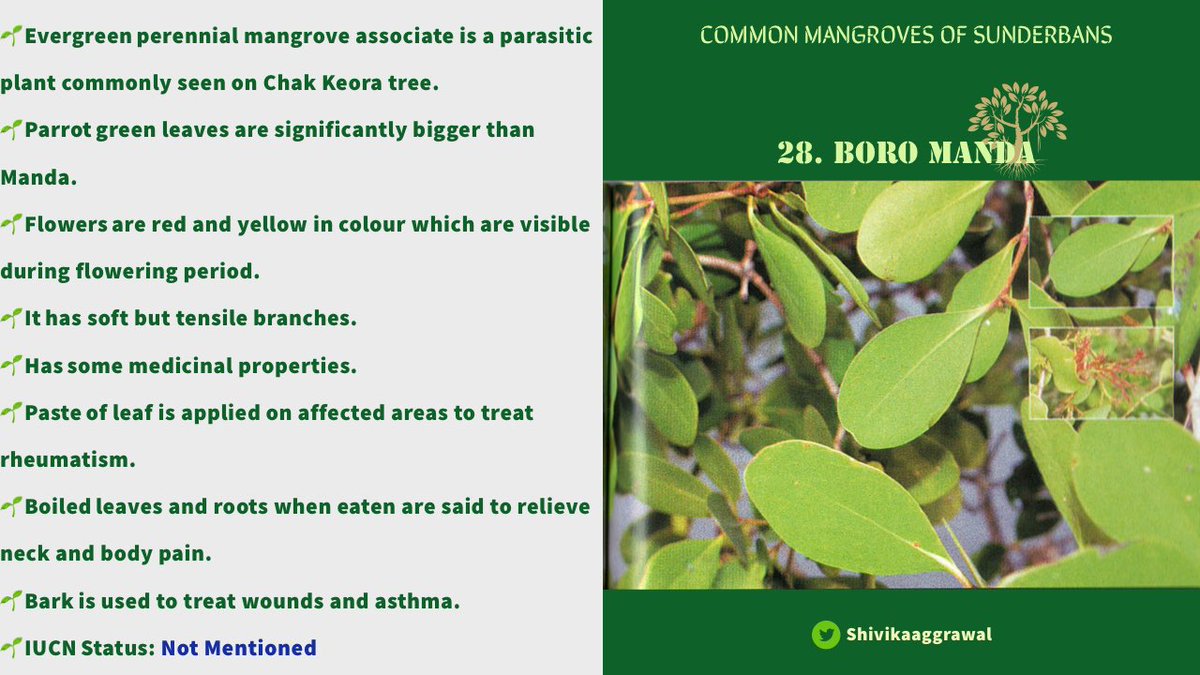 𝐁𝐎𝐑𝐎 𝐌𝐀𝐍𝐃𝐀https://abs.twimg.com/emoji/v2/... draggable="false" alt="🍃" title="Im Wind flatterndes Blatt" aria-label="Emoji: Im Wind flatterndes Blatt">https://abs.twimg.com/emoji/v2/... draggable="false" alt="🍀" title="Vierblättriges Kleeblatt" aria-label="Emoji: Vierblättriges Kleeblatt">Boro means “big” in Bengali. Since, its leaves are bigger than Manda; it is named so.https://abs.twimg.com/emoji/v2/... draggable="false" alt="🌺" title="Hibiskus" aria-label="Emoji: Hibiskus">Red and yellow flowers make the plant visible during flowering season, otherwise it remains well camouflaged within the main tree." title="https://abs.twimg.com/emoji/v2/... draggable="false" alt="🍃" title="Im Wind flatterndes Blatt" aria-label="Emoji: Im Wind flatterndes Blatt">𝐁𝐎𝐑𝐎 𝐌𝐀𝐍𝐃𝐀https://abs.twimg.com/emoji/v2/... draggable="false" alt="🍃" title="Im Wind flatterndes Blatt" aria-label="Emoji: Im Wind flatterndes Blatt">https://abs.twimg.com/emoji/v2/... draggable="false" alt="🍀" title="Vierblättriges Kleeblatt" aria-label="Emoji: Vierblättriges Kleeblatt">Boro means “big” in Bengali. Since, its leaves are bigger than Manda; it is named so.https://abs.twimg.com/emoji/v2/... draggable="false" alt="🌺" title="Hibiskus" aria-label="Emoji: Hibiskus">Red and yellow flowers make the plant visible during flowering season, otherwise it remains well camouflaged within the main tree." class="img-responsive" style="max-width:100%;"/>
𝐁𝐎𝐑𝐎 𝐌𝐀𝐍𝐃𝐀https://abs.twimg.com/emoji/v2/... draggable="false" alt="🍃" title="Im Wind flatterndes Blatt" aria-label="Emoji: Im Wind flatterndes Blatt">https://abs.twimg.com/emoji/v2/... draggable="false" alt="🍀" title="Vierblättriges Kleeblatt" aria-label="Emoji: Vierblättriges Kleeblatt">Boro means “big” in Bengali. Since, its leaves are bigger than Manda; it is named so.https://abs.twimg.com/emoji/v2/... draggable="false" alt="🌺" title="Hibiskus" aria-label="Emoji: Hibiskus">Red and yellow flowers make the plant visible during flowering season, otherwise it remains well camouflaged within the main tree." title="https://abs.twimg.com/emoji/v2/... draggable="false" alt="🍃" title="Im Wind flatterndes Blatt" aria-label="Emoji: Im Wind flatterndes Blatt">𝐁𝐎𝐑𝐎 𝐌𝐀𝐍𝐃𝐀https://abs.twimg.com/emoji/v2/... draggable="false" alt="🍃" title="Im Wind flatterndes Blatt" aria-label="Emoji: Im Wind flatterndes Blatt">https://abs.twimg.com/emoji/v2/... draggable="false" alt="🍀" title="Vierblättriges Kleeblatt" aria-label="Emoji: Vierblättriges Kleeblatt">Boro means “big” in Bengali. Since, its leaves are bigger than Manda; it is named so.https://abs.twimg.com/emoji/v2/... draggable="false" alt="🌺" title="Hibiskus" aria-label="Emoji: Hibiskus">Red and yellow flowers make the plant visible during flowering season, otherwise it remains well camouflaged within the main tree." class="img-responsive" style="max-width:100%;"/>
 𝐒𝐔𝐓𝐎 𝐒𝐇𝐀𝐎𝐋𝐀https://abs.twimg.com/emoji/v2/... draggable="false" alt="🍃" title="Im Wind flatterndes Blatt" aria-label="Emoji: Im Wind flatterndes Blatt">https://abs.twimg.com/emoji/v2/... draggable="false" alt="🧶" title="Yarn" aria-label="Emoji: Yarn">Suto in Bengali means “thread” whereas Shaola means “algae”. This algae is named so as it looks like green thread floating in water." title="https://abs.twimg.com/emoji/v2/... draggable="false" alt="🍃" title="Im Wind flatterndes Blatt" aria-label="Emoji: Im Wind flatterndes Blatt">𝐒𝐔𝐓𝐎 𝐒𝐇𝐀𝐎𝐋𝐀https://abs.twimg.com/emoji/v2/... draggable="false" alt="🍃" title="Im Wind flatterndes Blatt" aria-label="Emoji: Im Wind flatterndes Blatt">https://abs.twimg.com/emoji/v2/... draggable="false" alt="🧶" title="Yarn" aria-label="Emoji: Yarn">Suto in Bengali means “thread” whereas Shaola means “algae”. This algae is named so as it looks like green thread floating in water." class="img-responsive" style="max-width:100%;"/>
𝐒𝐔𝐓𝐎 𝐒𝐇𝐀𝐎𝐋𝐀https://abs.twimg.com/emoji/v2/... draggable="false" alt="🍃" title="Im Wind flatterndes Blatt" aria-label="Emoji: Im Wind flatterndes Blatt">https://abs.twimg.com/emoji/v2/... draggable="false" alt="🧶" title="Yarn" aria-label="Emoji: Yarn">Suto in Bengali means “thread” whereas Shaola means “algae”. This algae is named so as it looks like green thread floating in water." title="https://abs.twimg.com/emoji/v2/... draggable="false" alt="🍃" title="Im Wind flatterndes Blatt" aria-label="Emoji: Im Wind flatterndes Blatt">𝐒𝐔𝐓𝐎 𝐒𝐇𝐀𝐎𝐋𝐀https://abs.twimg.com/emoji/v2/... draggable="false" alt="🍃" title="Im Wind flatterndes Blatt" aria-label="Emoji: Im Wind flatterndes Blatt">https://abs.twimg.com/emoji/v2/... draggable="false" alt="🧶" title="Yarn" aria-label="Emoji: Yarn">Suto in Bengali means “thread” whereas Shaola means “algae”. This algae is named so as it looks like green thread floating in water." class="img-responsive" style="max-width:100%;"/>
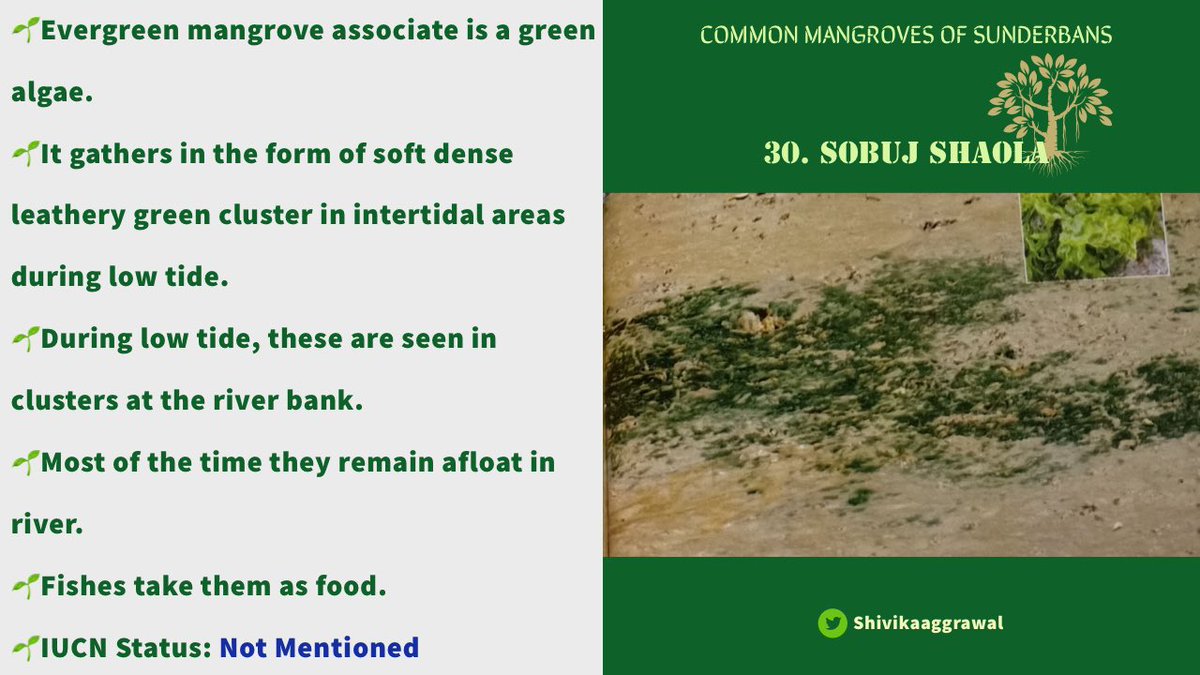 𝐒𝐎𝐁𝐔𝐉 𝐒𝐇𝐀𝐎𝐋𝐀https://abs.twimg.com/emoji/v2/... draggable="false" alt="🍃" title="Im Wind flatterndes Blatt" aria-label="Emoji: Im Wind flatterndes Blatt">https://abs.twimg.com/emoji/v2/... draggable="false" alt="🌿" title="Kräuter" aria-label="Emoji: Kräuter">Sobuj means “green” in Bengali. Since this algae is green in color, it is called so." title="https://abs.twimg.com/emoji/v2/... draggable="false" alt="🍃" title="Im Wind flatterndes Blatt" aria-label="Emoji: Im Wind flatterndes Blatt">𝐒𝐎𝐁𝐔𝐉 𝐒𝐇𝐀𝐎𝐋𝐀https://abs.twimg.com/emoji/v2/... draggable="false" alt="🍃" title="Im Wind flatterndes Blatt" aria-label="Emoji: Im Wind flatterndes Blatt">https://abs.twimg.com/emoji/v2/... draggable="false" alt="🌿" title="Kräuter" aria-label="Emoji: Kräuter">Sobuj means “green” in Bengali. Since this algae is green in color, it is called so." class="img-responsive" style="max-width:100%;"/>
𝐒𝐎𝐁𝐔𝐉 𝐒𝐇𝐀𝐎𝐋𝐀https://abs.twimg.com/emoji/v2/... draggable="false" alt="🍃" title="Im Wind flatterndes Blatt" aria-label="Emoji: Im Wind flatterndes Blatt">https://abs.twimg.com/emoji/v2/... draggable="false" alt="🌿" title="Kräuter" aria-label="Emoji: Kräuter">Sobuj means “green” in Bengali. Since this algae is green in color, it is called so." title="https://abs.twimg.com/emoji/v2/... draggable="false" alt="🍃" title="Im Wind flatterndes Blatt" aria-label="Emoji: Im Wind flatterndes Blatt">𝐒𝐎𝐁𝐔𝐉 𝐒𝐇𝐀𝐎𝐋𝐀https://abs.twimg.com/emoji/v2/... draggable="false" alt="🍃" title="Im Wind flatterndes Blatt" aria-label="Emoji: Im Wind flatterndes Blatt">https://abs.twimg.com/emoji/v2/... draggable="false" alt="🌿" title="Kräuter" aria-label="Emoji: Kräuter">Sobuj means “green” in Bengali. Since this algae is green in color, it is called so." class="img-responsive" style="max-width:100%;"/>
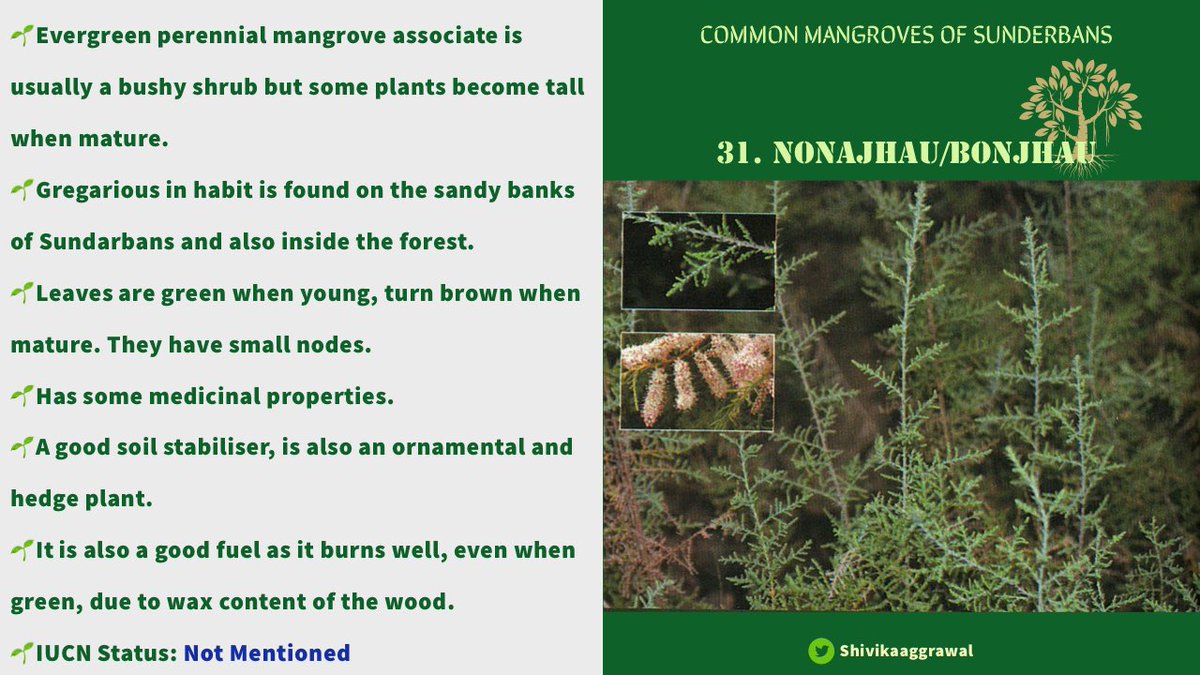 𝐍𝐎𝐍𝐀𝐉𝐇𝐀𝐔/𝐁𝐎𝐍𝐉𝐇𝐀𝐔https://abs.twimg.com/emoji/v2/... draggable="false" alt="🍃" title="Im Wind flatterndes Blatt" aria-label="Emoji: Im Wind flatterndes Blatt">https://abs.twimg.com/emoji/v2/... draggable="false" alt="🎋" title="Tanabata Baum" aria-label="Emoji: Tanabata Baum">Commonly known as Indian Tamarisk is called “jhau” in Hindi and Bengali.https://abs.twimg.com/emoji/v2/... draggable="false" alt="🥀" title="Verwelkte Blume" aria-label="Emoji: Verwelkte Blume">Its flowers are borne on long and slender racemes." title="https://abs.twimg.com/emoji/v2/... draggable="false" alt="🍃" title="Im Wind flatterndes Blatt" aria-label="Emoji: Im Wind flatterndes Blatt">𝐍𝐎𝐍𝐀𝐉𝐇𝐀𝐔/𝐁𝐎𝐍𝐉𝐇𝐀𝐔https://abs.twimg.com/emoji/v2/... draggable="false" alt="🍃" title="Im Wind flatterndes Blatt" aria-label="Emoji: Im Wind flatterndes Blatt">https://abs.twimg.com/emoji/v2/... draggable="false" alt="🎋" title="Tanabata Baum" aria-label="Emoji: Tanabata Baum">Commonly known as Indian Tamarisk is called “jhau” in Hindi and Bengali.https://abs.twimg.com/emoji/v2/... draggable="false" alt="🥀" title="Verwelkte Blume" aria-label="Emoji: Verwelkte Blume">Its flowers are borne on long and slender racemes." class="img-responsive" style="max-width:100%;"/>
𝐍𝐎𝐍𝐀𝐉𝐇𝐀𝐔/𝐁𝐎𝐍𝐉𝐇𝐀𝐔https://abs.twimg.com/emoji/v2/... draggable="false" alt="🍃" title="Im Wind flatterndes Blatt" aria-label="Emoji: Im Wind flatterndes Blatt">https://abs.twimg.com/emoji/v2/... draggable="false" alt="🎋" title="Tanabata Baum" aria-label="Emoji: Tanabata Baum">Commonly known as Indian Tamarisk is called “jhau” in Hindi and Bengali.https://abs.twimg.com/emoji/v2/... draggable="false" alt="🥀" title="Verwelkte Blume" aria-label="Emoji: Verwelkte Blume">Its flowers are borne on long and slender racemes." title="https://abs.twimg.com/emoji/v2/... draggable="false" alt="🍃" title="Im Wind flatterndes Blatt" aria-label="Emoji: Im Wind flatterndes Blatt">𝐍𝐎𝐍𝐀𝐉𝐇𝐀𝐔/𝐁𝐎𝐍𝐉𝐇𝐀𝐔https://abs.twimg.com/emoji/v2/... draggable="false" alt="🍃" title="Im Wind flatterndes Blatt" aria-label="Emoji: Im Wind flatterndes Blatt">https://abs.twimg.com/emoji/v2/... draggable="false" alt="🎋" title="Tanabata Baum" aria-label="Emoji: Tanabata Baum">Commonly known as Indian Tamarisk is called “jhau” in Hindi and Bengali.https://abs.twimg.com/emoji/v2/... draggable="false" alt="🥀" title="Verwelkte Blume" aria-label="Emoji: Verwelkte Blume">Its flowers are borne on long and slender racemes." class="img-responsive" style="max-width:100%;"/>
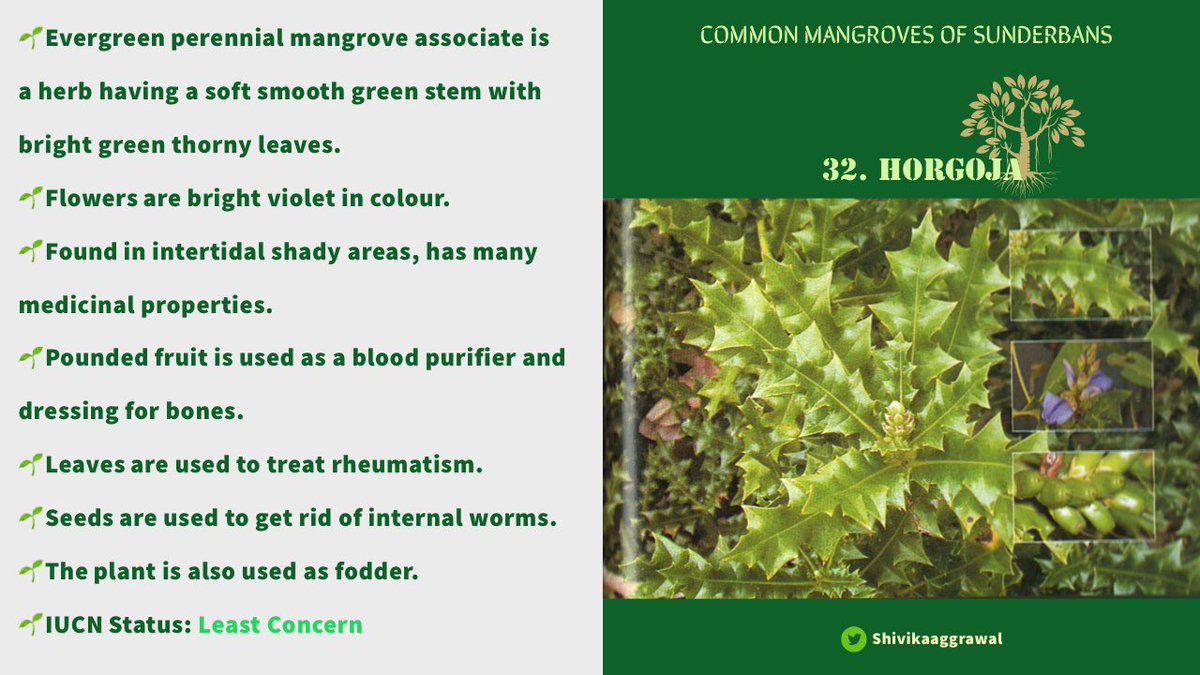 𝐇𝐎𝐑𝐆𝐎𝐉𝐀https://abs.twimg.com/emoji/v2/... draggable="false" alt="🍃" title="Im Wind flatterndes Blatt" aria-label="Emoji: Im Wind flatterndes Blatt">https://abs.twimg.com/emoji/v2/... draggable="false" alt="🌺" title="Hibiskus" aria-label="Emoji: Hibiskus">Its leaves and flowers are quite different in shape. https://abs.twimg.com/emoji/v2/... draggable="false" alt="🍀" title="Vierblättriges Kleeblatt" aria-label="Emoji: Vierblättriges Kleeblatt">Leaves are bright green, thorny, and twisted horizontally.https://abs.twimg.com/emoji/v2/... draggable="false" alt="🌸" title="Kirschblüte" aria-label="Emoji: Kirschblüte">Horgoja is known for its beautiful bright purple flowers." title="https://abs.twimg.com/emoji/v2/... draggable="false" alt="🍃" title="Im Wind flatterndes Blatt" aria-label="Emoji: Im Wind flatterndes Blatt">𝐇𝐎𝐑𝐆𝐎𝐉𝐀https://abs.twimg.com/emoji/v2/... draggable="false" alt="🍃" title="Im Wind flatterndes Blatt" aria-label="Emoji: Im Wind flatterndes Blatt">https://abs.twimg.com/emoji/v2/... draggable="false" alt="🌺" title="Hibiskus" aria-label="Emoji: Hibiskus">Its leaves and flowers are quite different in shape. https://abs.twimg.com/emoji/v2/... draggable="false" alt="🍀" title="Vierblättriges Kleeblatt" aria-label="Emoji: Vierblättriges Kleeblatt">Leaves are bright green, thorny, and twisted horizontally.https://abs.twimg.com/emoji/v2/... draggable="false" alt="🌸" title="Kirschblüte" aria-label="Emoji: Kirschblüte">Horgoja is known for its beautiful bright purple flowers." class="img-responsive" style="max-width:100%;"/>
𝐇𝐎𝐑𝐆𝐎𝐉𝐀https://abs.twimg.com/emoji/v2/... draggable="false" alt="🍃" title="Im Wind flatterndes Blatt" aria-label="Emoji: Im Wind flatterndes Blatt">https://abs.twimg.com/emoji/v2/... draggable="false" alt="🌺" title="Hibiskus" aria-label="Emoji: Hibiskus">Its leaves and flowers are quite different in shape. https://abs.twimg.com/emoji/v2/... draggable="false" alt="🍀" title="Vierblättriges Kleeblatt" aria-label="Emoji: Vierblättriges Kleeblatt">Leaves are bright green, thorny, and twisted horizontally.https://abs.twimg.com/emoji/v2/... draggable="false" alt="🌸" title="Kirschblüte" aria-label="Emoji: Kirschblüte">Horgoja is known for its beautiful bright purple flowers." title="https://abs.twimg.com/emoji/v2/... draggable="false" alt="🍃" title="Im Wind flatterndes Blatt" aria-label="Emoji: Im Wind flatterndes Blatt">𝐇𝐎𝐑𝐆𝐎𝐉𝐀https://abs.twimg.com/emoji/v2/... draggable="false" alt="🍃" title="Im Wind flatterndes Blatt" aria-label="Emoji: Im Wind flatterndes Blatt">https://abs.twimg.com/emoji/v2/... draggable="false" alt="🌺" title="Hibiskus" aria-label="Emoji: Hibiskus">Its leaves and flowers are quite different in shape. https://abs.twimg.com/emoji/v2/... draggable="false" alt="🍀" title="Vierblättriges Kleeblatt" aria-label="Emoji: Vierblättriges Kleeblatt">Leaves are bright green, thorny, and twisted horizontally.https://abs.twimg.com/emoji/v2/... draggable="false" alt="🌸" title="Kirschblüte" aria-label="Emoji: Kirschblüte">Horgoja is known for its beautiful bright purple flowers." class="img-responsive" style="max-width:100%;"/>
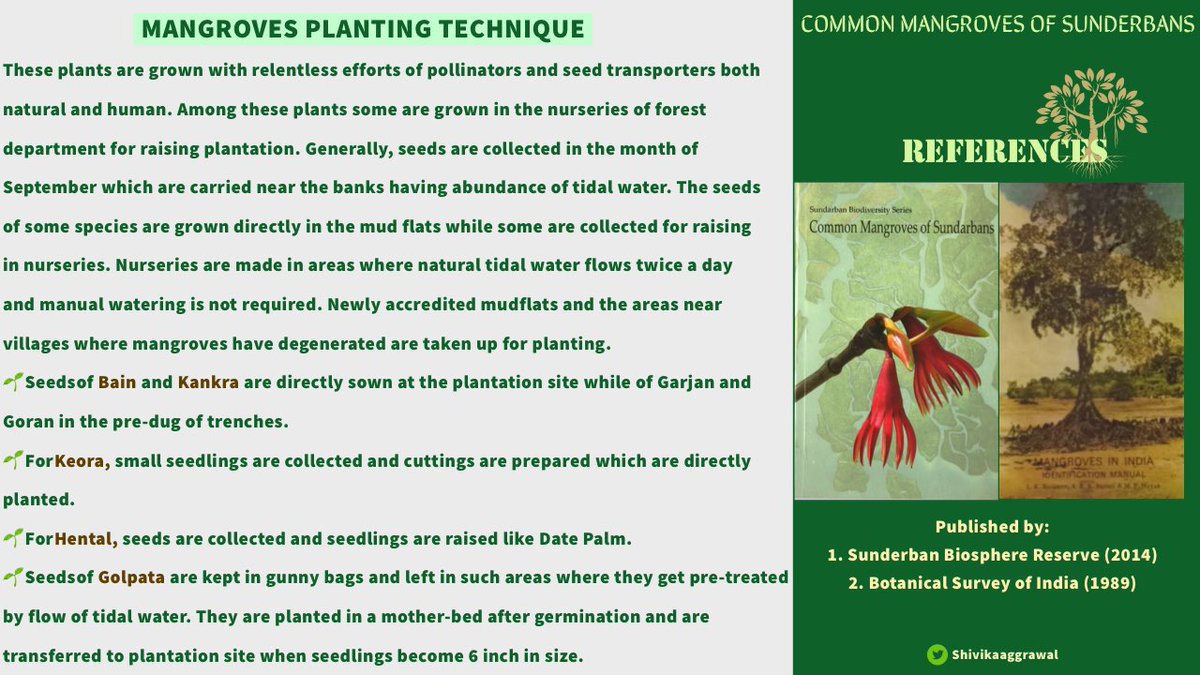 𝐓𝐇𝐀𝐍𝐊 𝐘𝐎𝐔https://abs.twimg.com/emoji/v2/... draggable="false" alt="🍃" title="Im Wind flatterndes Blatt" aria-label="Emoji: Im Wind flatterndes Blatt">I request you to share this thread esp with school & college going students. It& #39;s important that they know about these beautiful ecosystems irrespective of their streams, take interest & think of pursuing higher studies & research in this unexplored domain." title="https://abs.twimg.com/emoji/v2/... draggable="false" alt="🍃" title="Im Wind flatterndes Blatt" aria-label="Emoji: Im Wind flatterndes Blatt">𝐓𝐇𝐀𝐍𝐊 𝐘𝐎𝐔https://abs.twimg.com/emoji/v2/... draggable="false" alt="🍃" title="Im Wind flatterndes Blatt" aria-label="Emoji: Im Wind flatterndes Blatt">I request you to share this thread esp with school & college going students. It& #39;s important that they know about these beautiful ecosystems irrespective of their streams, take interest & think of pursuing higher studies & research in this unexplored domain." class="img-responsive" style="max-width:100%;"/>
𝐓𝐇𝐀𝐍𝐊 𝐘𝐎𝐔https://abs.twimg.com/emoji/v2/... draggable="false" alt="🍃" title="Im Wind flatterndes Blatt" aria-label="Emoji: Im Wind flatterndes Blatt">I request you to share this thread esp with school & college going students. It& #39;s important that they know about these beautiful ecosystems irrespective of their streams, take interest & think of pursuing higher studies & research in this unexplored domain." title="https://abs.twimg.com/emoji/v2/... draggable="false" alt="🍃" title="Im Wind flatterndes Blatt" aria-label="Emoji: Im Wind flatterndes Blatt">𝐓𝐇𝐀𝐍𝐊 𝐘𝐎𝐔https://abs.twimg.com/emoji/v2/... draggable="false" alt="🍃" title="Im Wind flatterndes Blatt" aria-label="Emoji: Im Wind flatterndes Blatt">I request you to share this thread esp with school & college going students. It& #39;s important that they know about these beautiful ecosystems irrespective of their streams, take interest & think of pursuing higher studies & research in this unexplored domain." class="img-responsive" style="max-width:100%;"/>


